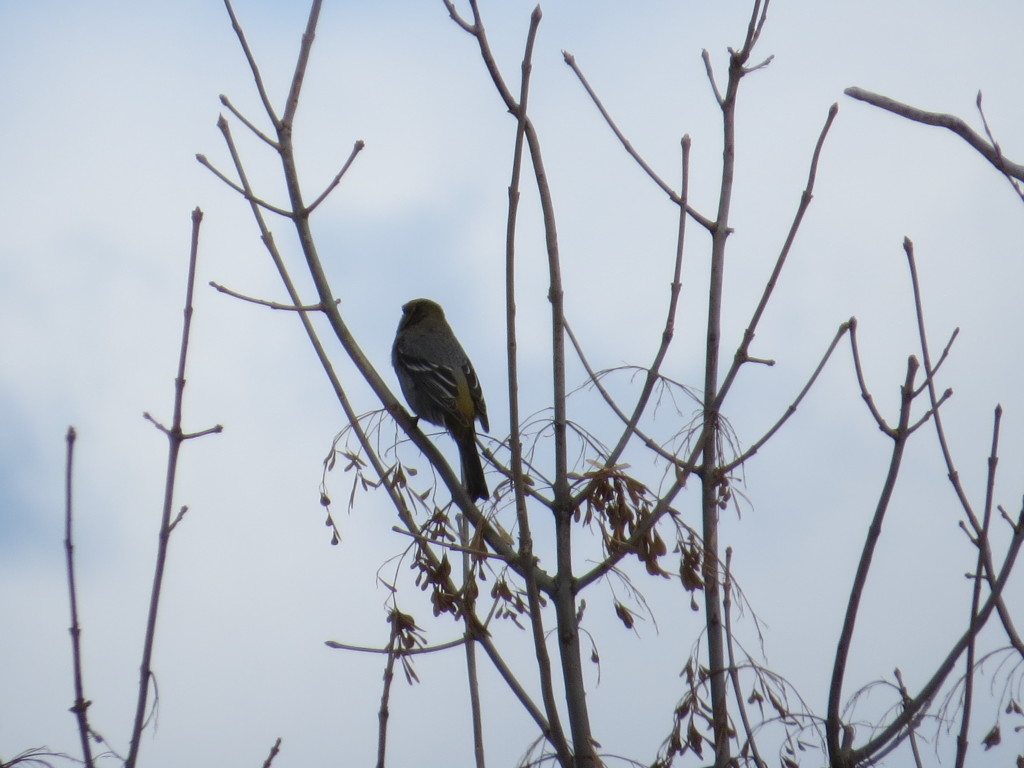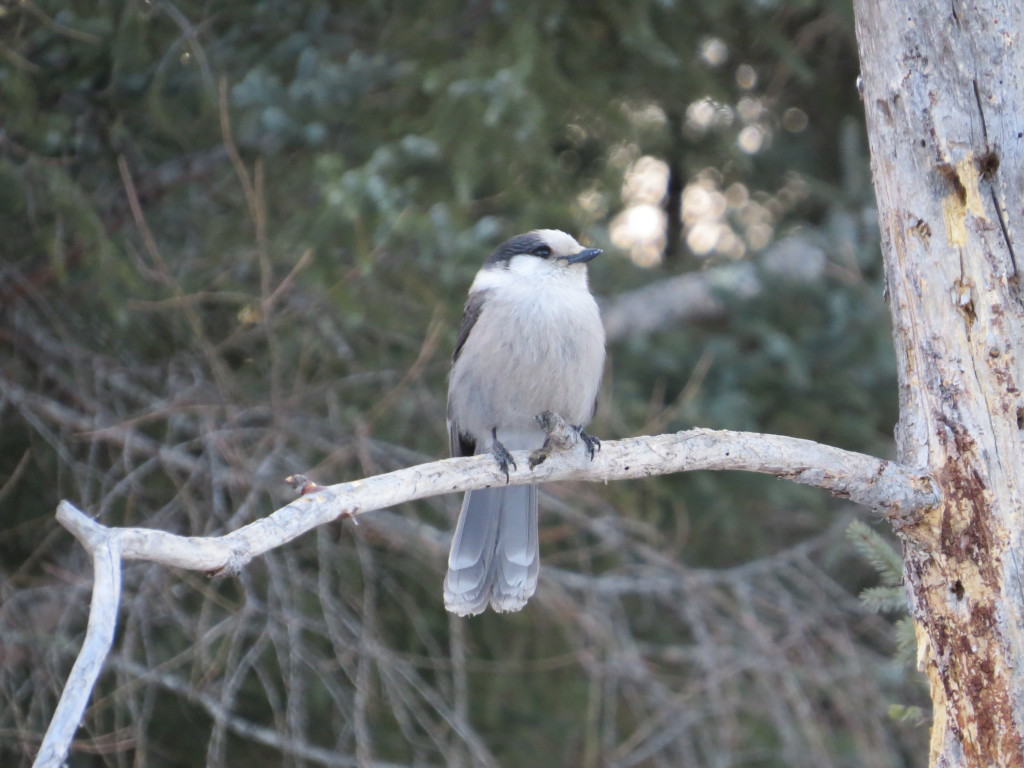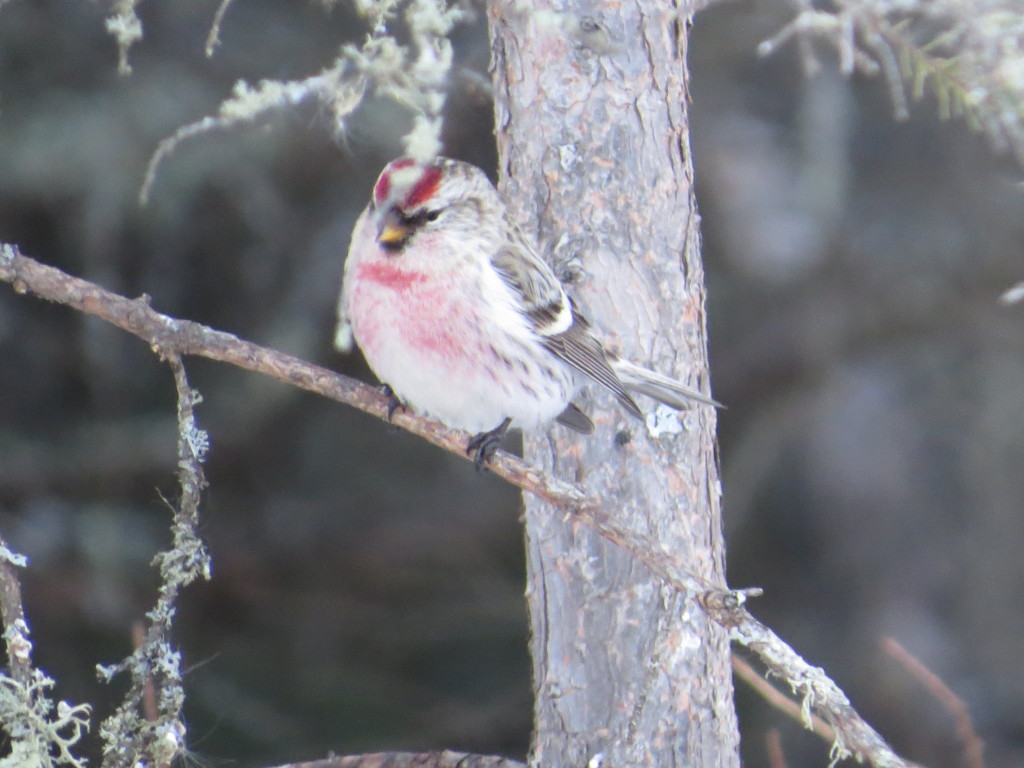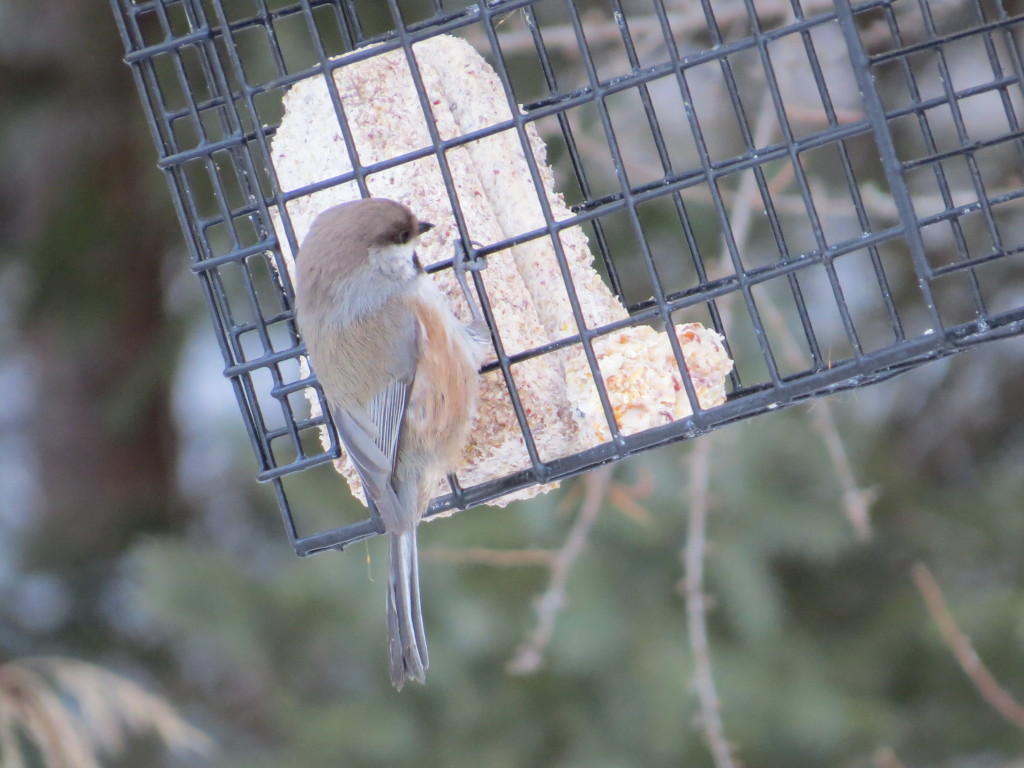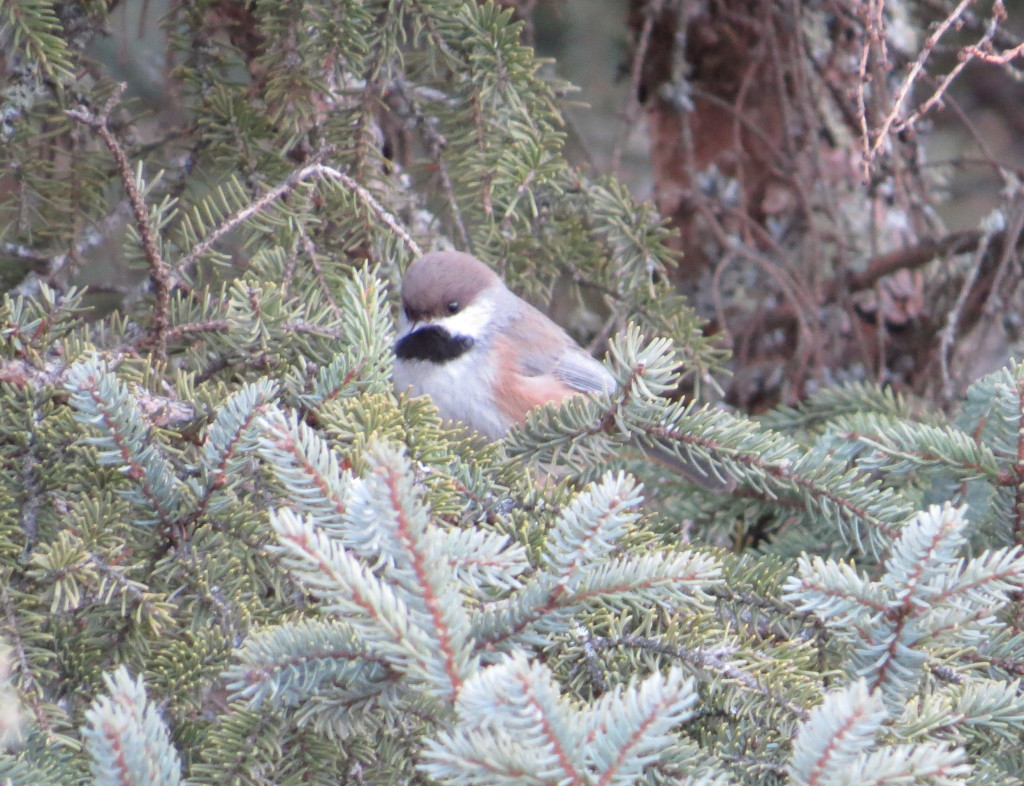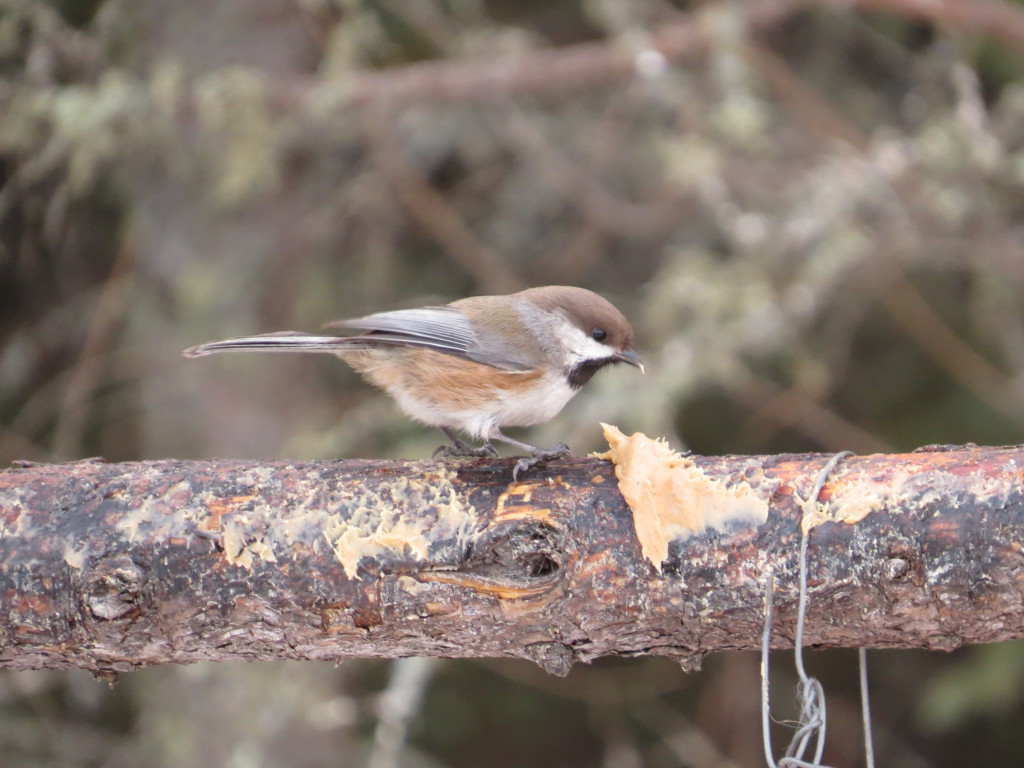No matter how many times I bird northern Minnesota, I don’t think I will ever tire of its landscape or its avian inhabitants. It is home. And it is a place birders from all over the country and even the world want to go, often repeatedly. For me, it holds the same allure as a place like southeastern Arizona. Despite how many times you may see the resident species, they never fail to bring the wow factor, even after years of birding bring about new birding destinations and additions to the life list.
Our annual tradition is to go home to the Iron Range the day after Christmas to visit Melissa’s family. The timing of our visit allows me to participate in the Cook area Christmas Bird Count. This is the CBC I look forward to the most. Even though species counts are usually low, it’s the quality that trumps the quantity.
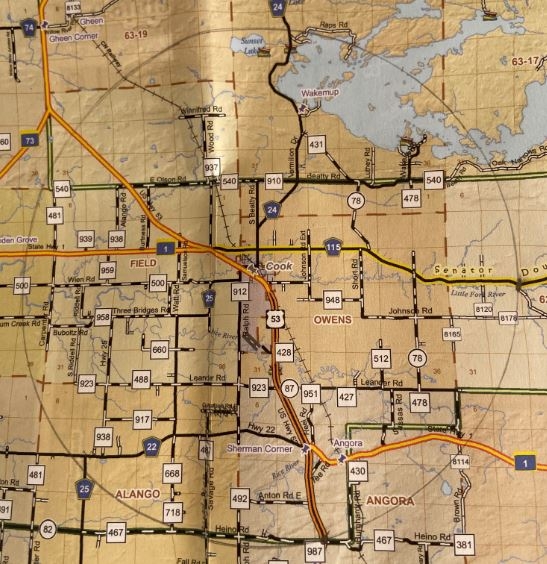
Local birder Julie Grahn always keeps me apprised of good sightings when we go back home. This time was no different as she had not one, but three Northern Hawk Owls hanging out in the Cook area. I was ecstatic. Despite all the owls I have seen over the years, I have never observed any of the northern owls anywhere close to home. And I have always wanted to. So the day before the CBC, I went about searching to finally enjoy one of these awesome owls in an area I enjoy the most. Hawk Owls are usually not hard to spot, but I was only able to find one of Julie’s owls. It was good enough. Actually, it was perfect.
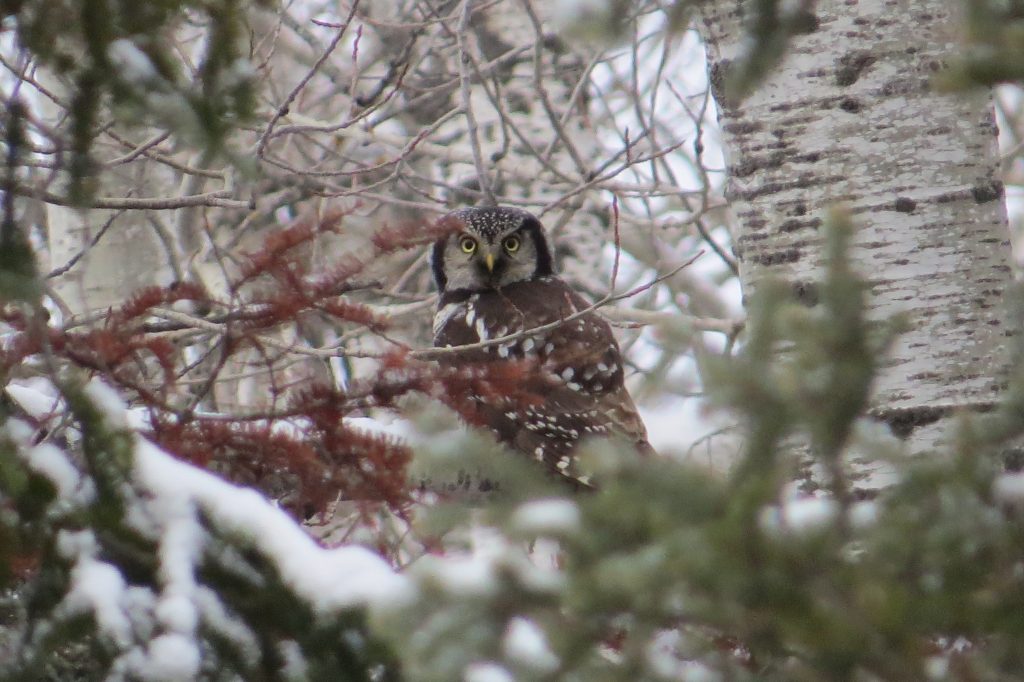 Hanging out with a Hawk Owl by yourself is more enjoyable than being part of the owl paparazzi at the Sax-Zim Bog. This particular owl was first sitting on top of a power pole with his back toward me. Of course owls move their heads in all directions, but I was absolutely shocked when it took off flying in the direction it had its back to and nabbed a vole nearly a quarter mile away. The owl then came back and worked on enjoying his meal in the privacy of various spruce trees.
Hanging out with a Hawk Owl by yourself is more enjoyable than being part of the owl paparazzi at the Sax-Zim Bog. This particular owl was first sitting on top of a power pole with his back toward me. Of course owls move their heads in all directions, but I was absolutely shocked when it took off flying in the direction it had its back to and nabbed a vole nearly a quarter mile away. The owl then came back and worked on enjoying his meal in the privacy of various spruce trees.
For the CBC the next day, I recruited Evan to help me record bird tallies and spot birds. Evan has not been into birds for a very long time. That’s dad’s thing. I’ve been cool with that. This recruitment was not about me trying to turn him into a birder again; it was about spending time together and also doing something Evan enjoys immensely–grouse hunting. He agreed to do the CBC because there might be a chance to get a Ruffed Grouse as I regularly see them whenever I bird the Northland. Evan was excited. I was excited. After all, I’ve seen some pretty darn good incidental birds while taking him out hunting this fall. In October there was an incredible encounter with a juvenile Northern Goshawk while we were grouse hunting on his Great Grandma’s property:
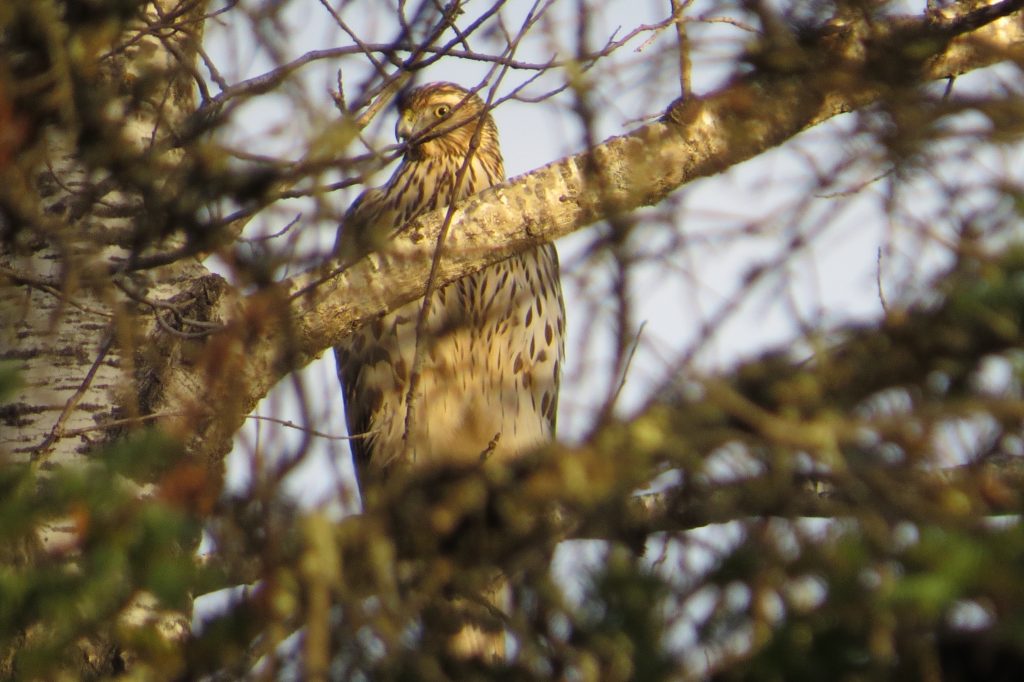
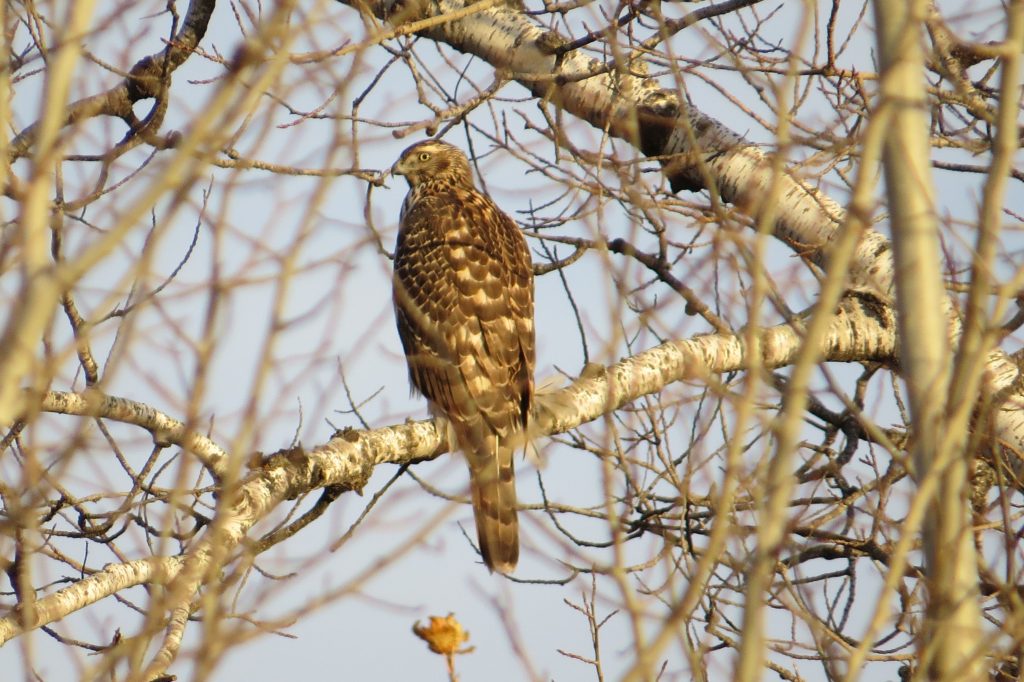 This Goshawk was seen multiple times because it was carefully guarding and working on a Snowshoe Hare meal along a trail that we walked several times in search of Grouse.
This Goshawk was seen multiple times because it was carefully guarding and working on a Snowshoe Hare meal along a trail that we walked several times in search of Grouse. 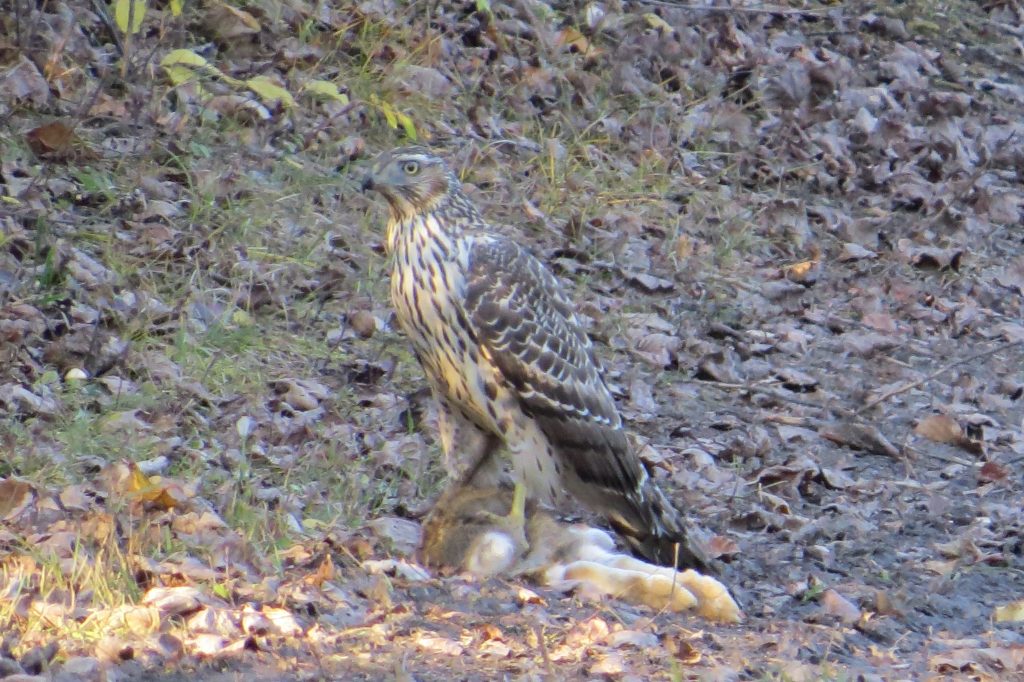
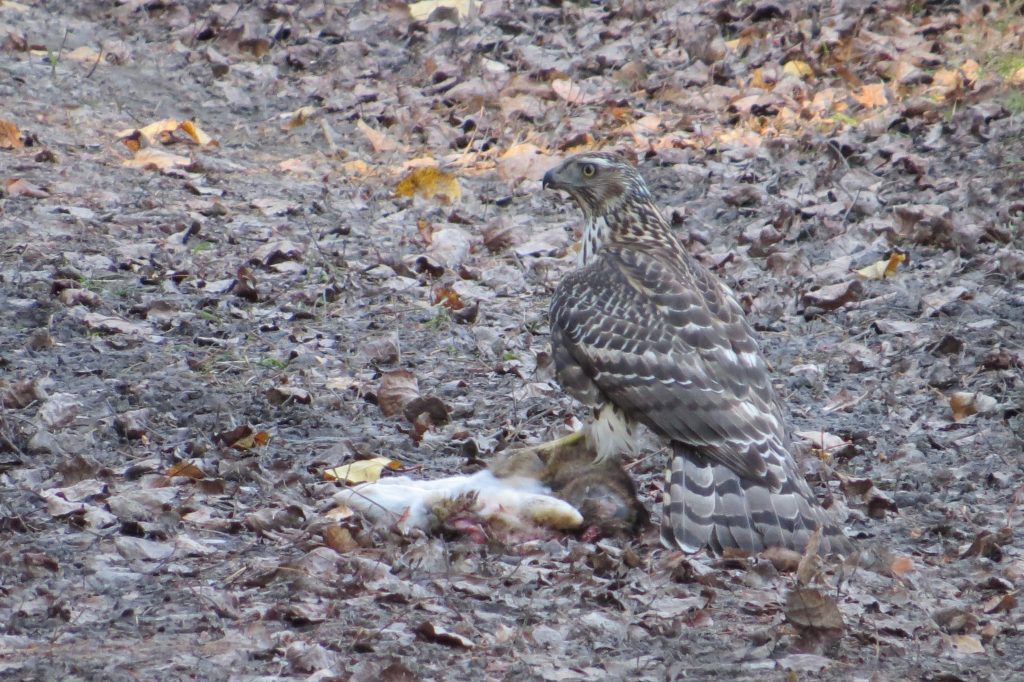
And about a month ago, I took Evan pheasant hunting on a WMA near Willmar and came face-to-face with a Long-eared Owl while trying to push pheasants out of a small spruce grove.
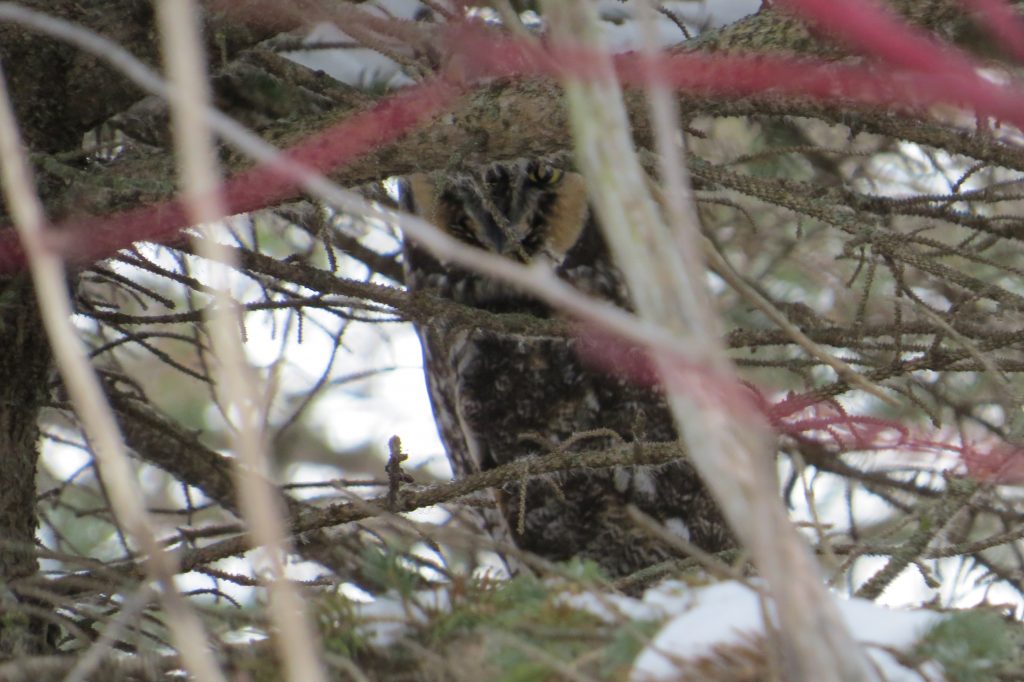 In these instances, birding was secondary and turned out to be phenomenal. Now on the CBC, the hunting was secondary. Would the birding be just as good?
In these instances, birding was secondary and turned out to be phenomenal. Now on the CBC, the hunting was secondary. Would the birding be just as good?
Things started off fairly mundane on our CBC route: the usual American Crows and ubiquitous Common Ravens. Of course, for me, any bird is exciting on a CBC. Each bird counts and gives you something to tally as an observer. The hope for a good species count or unusual count numbers (high or low) or a rare species keeps the interest high at all times. But for Evan, who was hoping for a Ruffed Grouse to shoot, it was starting off kind of boring, though he dutifully tallied whatever I dictated to him. Things picked up a bit when I spied a Black-billed Magpie, a very good bird for the count. Evan seemed interested that we had found a “good” bird. And then I spotted a Red Fox bedded down in a field. Evan enjoyed checking him out with my binoculars.
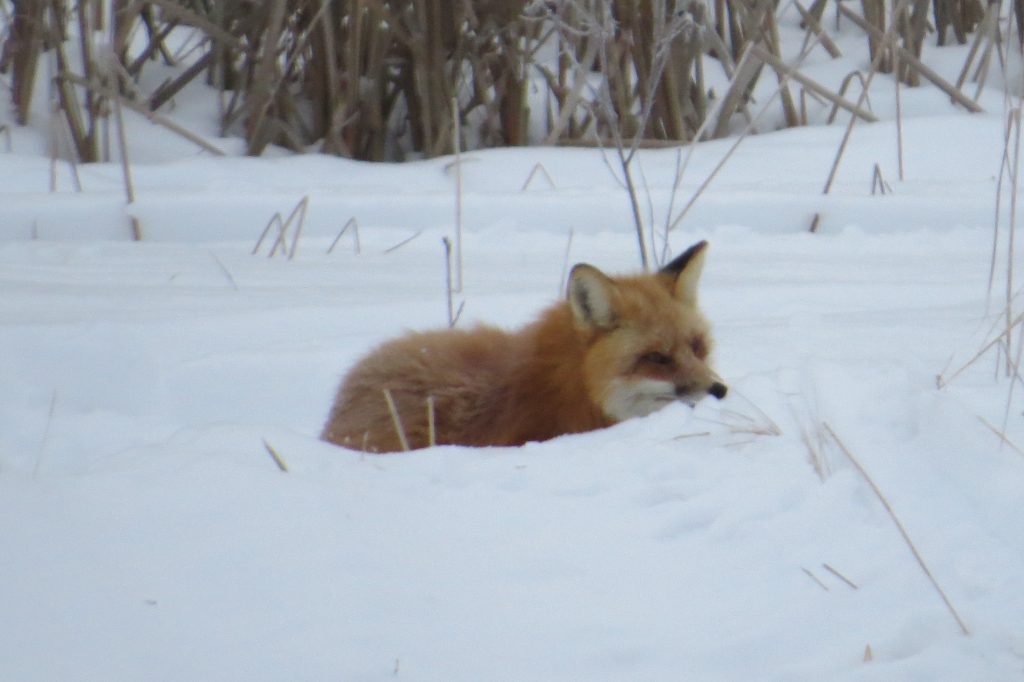 Shortly after this, we were approaching a Northern Hawk Owl territory, and I was on high alert scanning everywhere. This would be a key bird for the count, and I really wanted to get it bad. This resulted in me spotting a bird high in a birch tree that I first thought was our target. But it wasn’t. I was just as thrilled, though, because it was a Ruffed
Shortly after this, we were approaching a Northern Hawk Owl territory, and I was on high alert scanning everywhere. This would be a key bird for the count, and I really wanted to get it bad. This resulted in me spotting a bird high in a birch tree that I first thought was our target. But it wasn’t. I was just as thrilled, though, because it was a Ruffed
Grouse–I knew Evan would be pumped. Sure enough, new life came to the almost teenager as he frantically transitioned from his pencil and clipboard to getting his gun ready. Despite Evan’s best attempt at being stealthy like the fox, the grouse flew away unscathed without a shot fired. A letdown for sure, but now Evan at least knew his dad wasn’t crazy when he said there would probably be a chance to shoot at a grouse.
We set about working our route, and at one point, we were near one of my favorite black spruce bogs to bird. Some of this bog is in the circle and some is out of it. Just for fun I decided to check one of my hotpsots for rare woodpeckers just a couple hundred yards outside of the circle. I played a Black-backed Woodpecker recording and instantly heard one vocalize just off the road. I went into the bog after it and saw that gorgeous jet black back of a female Black-backed Woodpecker.
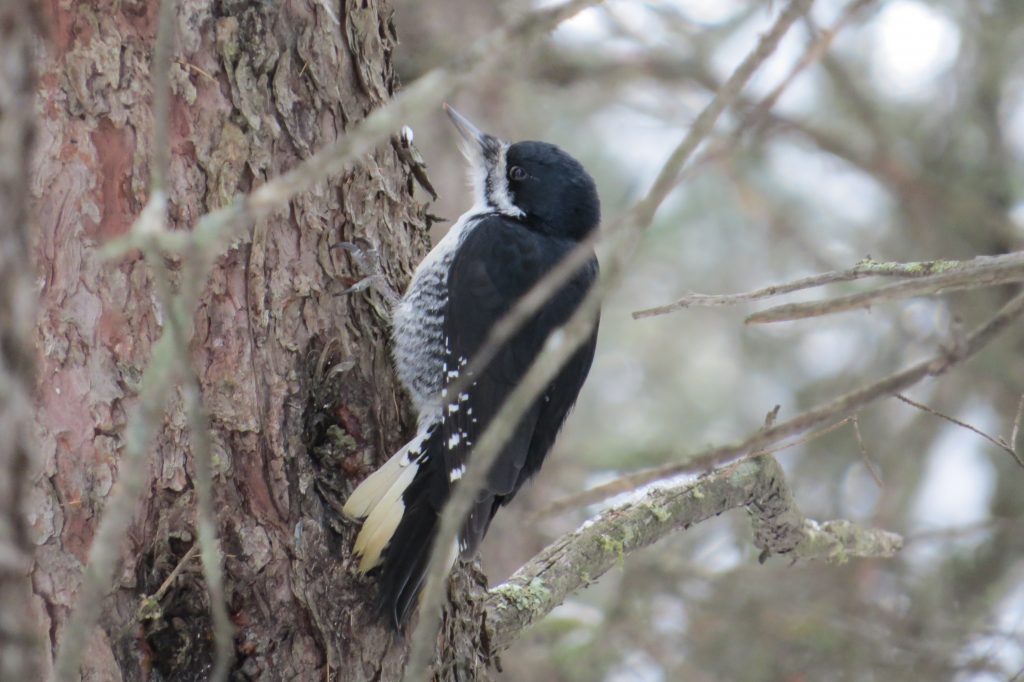 As I watched her, I was surprised when a male Black-backed scooted down the tree, interacted with her, and buzzed off. Where had he come from? The male wasn’t as photogenic but still gave some great looks.
As I watched her, I was surprised when a male Black-backed scooted down the tree, interacted with her, and buzzed off. Where had he come from? The male wasn’t as photogenic but still gave some great looks.
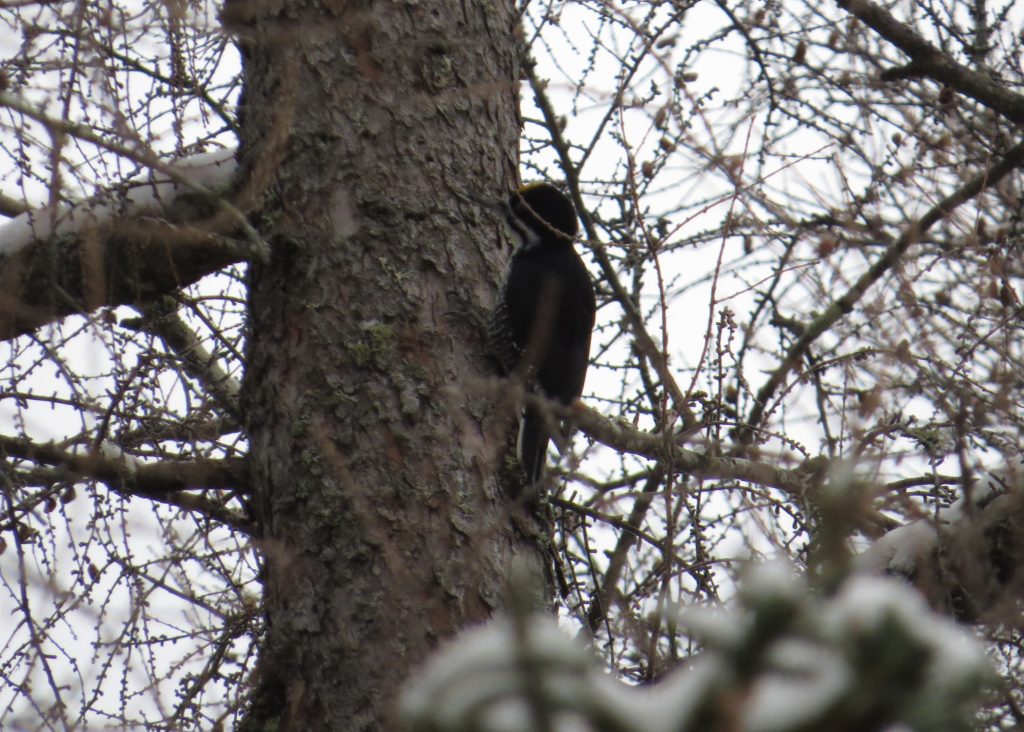 Evan had declined my offer to join me in the swamp to see these rare woodpeckers even though I knew he hadn’t seen them before. He opted to stay in the car; non-Grouse birds were still not exciting to him. He should have joined me because there was so much woodpecker activity (these two plus a Hairy), that I was stomping around in the bog for quite some time investigating every bit of tapping. And then, I heard yet another woodpecker drumming in a cadence that was perfect for a woodpecker even more rare than the Black-backed. It was an American Three-toed Woodpecker! I played a recording, and it instantly flew in, allowing me to visually confirm what I had heard. This species is rare enough in Minnesota that it is flagged in eBird and requires documentation. Thankfully I was able to get a few identifiable photos.
Evan had declined my offer to join me in the swamp to see these rare woodpeckers even though I knew he hadn’t seen them before. He opted to stay in the car; non-Grouse birds were still not exciting to him. He should have joined me because there was so much woodpecker activity (these two plus a Hairy), that I was stomping around in the bog for quite some time investigating every bit of tapping. And then, I heard yet another woodpecker drumming in a cadence that was perfect for a woodpecker even more rare than the Black-backed. It was an American Three-toed Woodpecker! I played a recording, and it instantly flew in, allowing me to visually confirm what I had heard. This species is rare enough in Minnesota that it is flagged in eBird and requires documentation. Thankfully I was able to get a few identifiable photos.
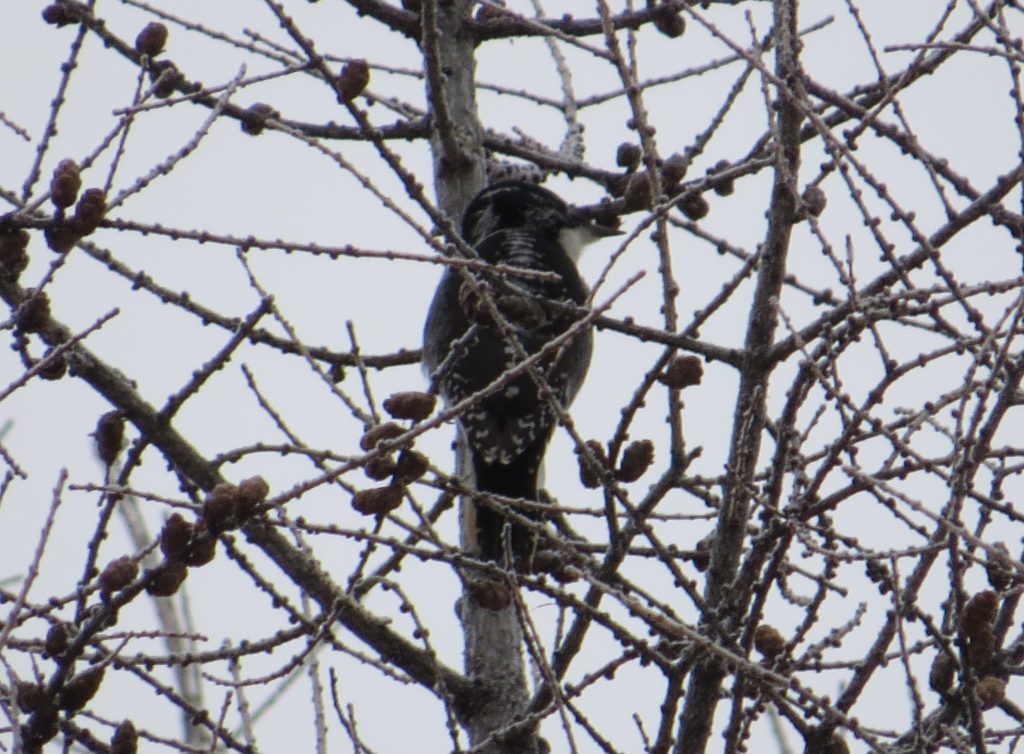 Once again I asked Evan if he now wanted to check out two rare woodpecker species, but he declined. He’s never seen either. There was so much activity that it was hard to keep straight, and our quick stop to check for woodpeckers was now going on a half hour. Even still, Evan preferred the car over the excitement around us. This particular spot has often held these two elusive boreal woodpecker species. In fact, two years ago almost to the day, I had the same encounter in this same spot: two Black-backeds and a single Three-toed.
Once again I asked Evan if he now wanted to check out two rare woodpecker species, but he declined. He’s never seen either. There was so much activity that it was hard to keep straight, and our quick stop to check for woodpeckers was now going on a half hour. Even still, Evan preferred the car over the excitement around us. This particular spot has often held these two elusive boreal woodpecker species. In fact, two years ago almost to the day, I had the same encounter in this same spot: two Black-backeds and a single Three-toed.
As exciting as the Woodpeckers were, I had a bored kid in the car and an unfinished CBC route. So we got back to it. The way the CBC circle falls, we only had to go a half mile before we were back in the circle again but still in the same spruce bog. This bog has held Boreal Chickadees in the past, so I decided to stop and try the secret weapon: playing the recording of chickadees mobbing a singing Eastern Screech-Owl. It never fails to attract a swarm of angry Black-capped Chickadees, looking to bring war to a fake owl. Often times this tremendous commotion can bring in other onlooker birds, ready to join the angry mob with their pitchforks. Sometimes this even attracts rare birds. And this time it did. Two of the chickadees sounded different than the others and proved to be the much rarer Boreal Chickadee. This was a solid find for the count.
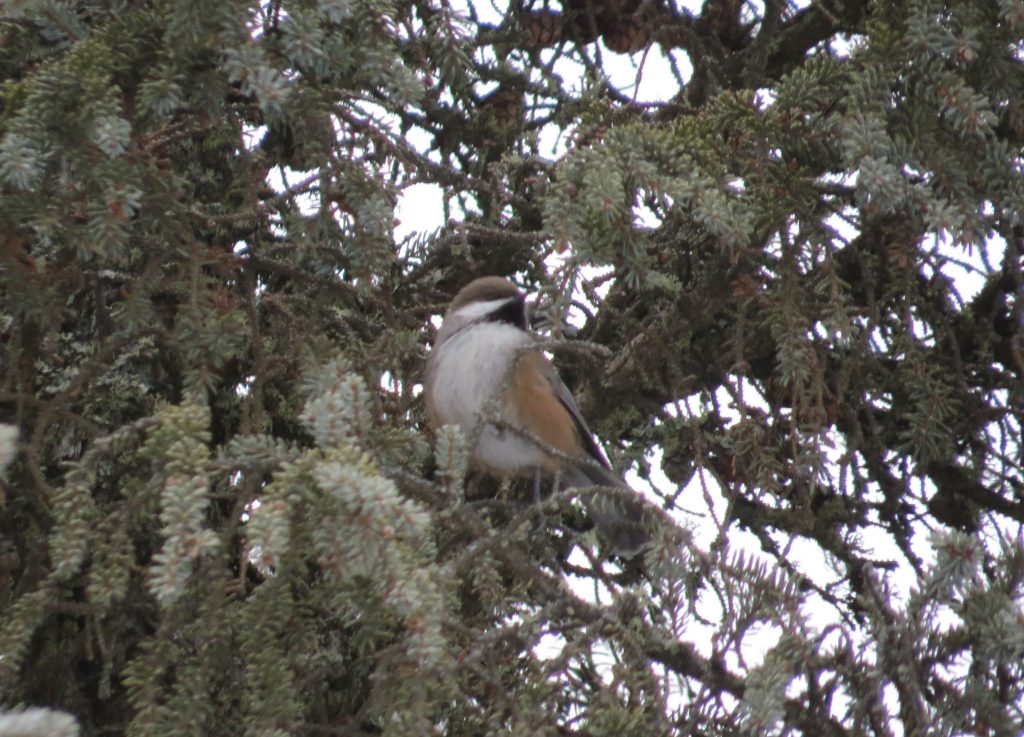
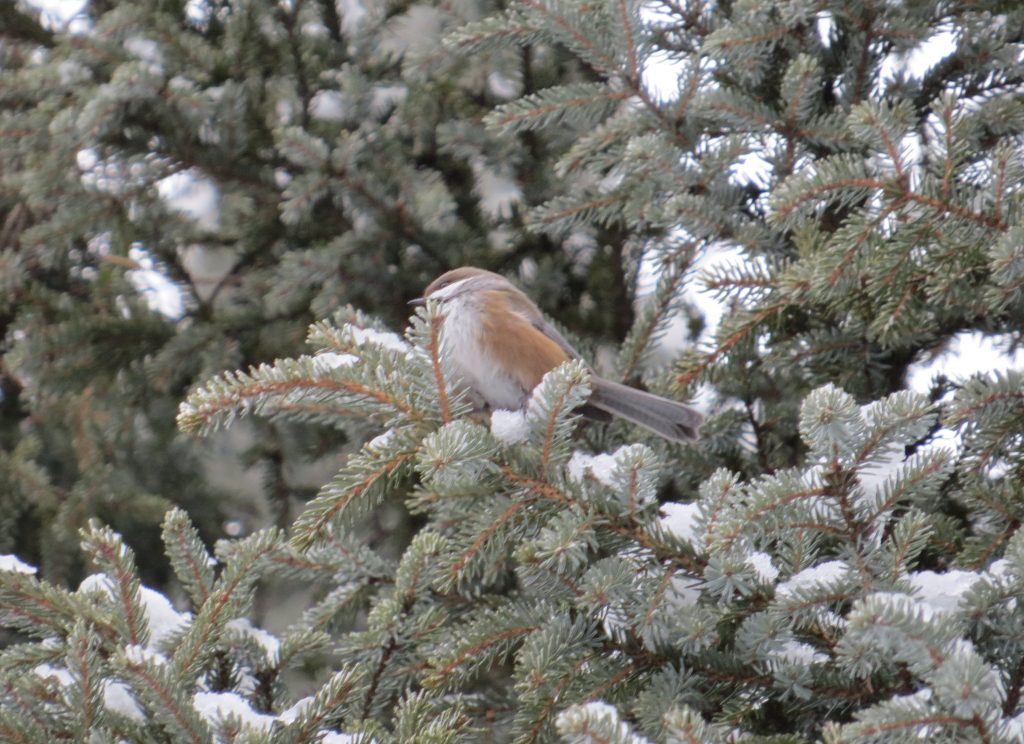 I asked Evan if he wanted to get a good look at the coolest chickadee species there is, but he again declined. I was pumped regardless. It’s always fun to see these birds, even more so when they count for a CBC. A bonus was that as I was observing them, another Black-backed Woodpecker flew into the bog nearby and vocalized! Another great count bird!
I asked Evan if he wanted to get a good look at the coolest chickadee species there is, but he again declined. I was pumped regardless. It’s always fun to see these birds, even more so when they count for a CBC. A bonus was that as I was observing them, another Black-backed Woodpecker flew into the bog nearby and vocalized! Another great count bird!
We got back to doing our route. Evan was hoping for grouse redemption; I was hoping for something, anything, that would be interesting. My hope came true first. Going down a road, we saw a half dozen Ravens scatter from the road. They must have been on a kill. Evan said, “Looks like six ravens and one magpie.”
“There was no magpie there,” I responded.
“Well, look in that tree right there by the road. There’s something special in it.” So I looked with the binos and caught sight of a Black-billed Magpie flying out of that tree! The kid was right, and I had missed it. I think he felt a surge of pride and was starting to get into this count thing.
A few miles later as we drove down a different road with the windows cracked, I heard some chickadees. So I decided to play the mobbing recording again. It paid off with a pile of Black-capped Chickadees, a few Red-breasted Nuthatches, and two more Boreal Chickadees!
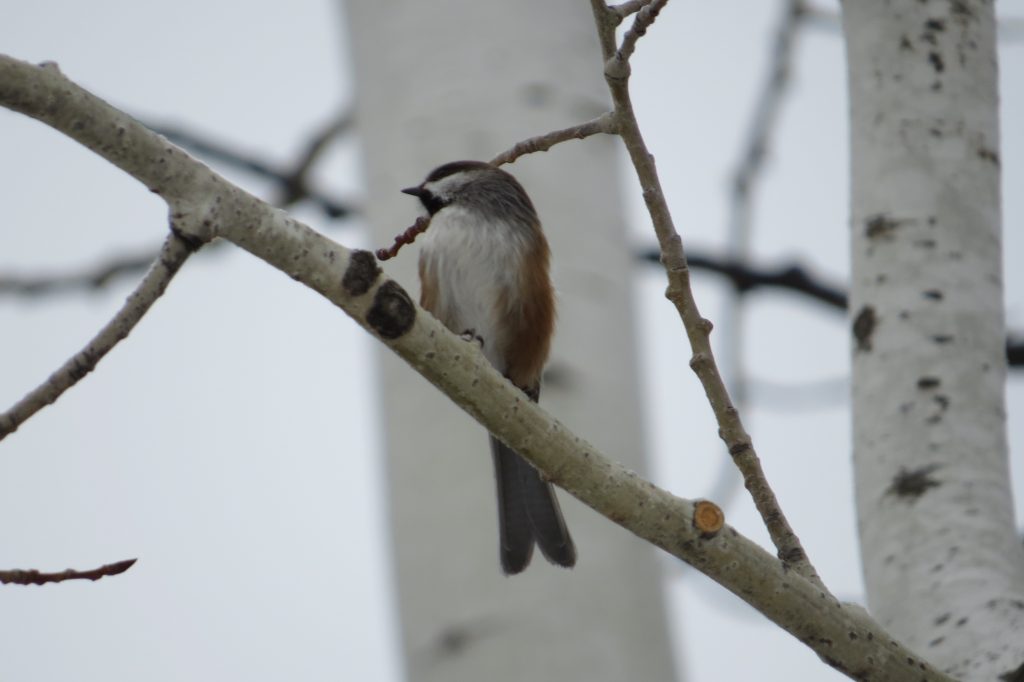
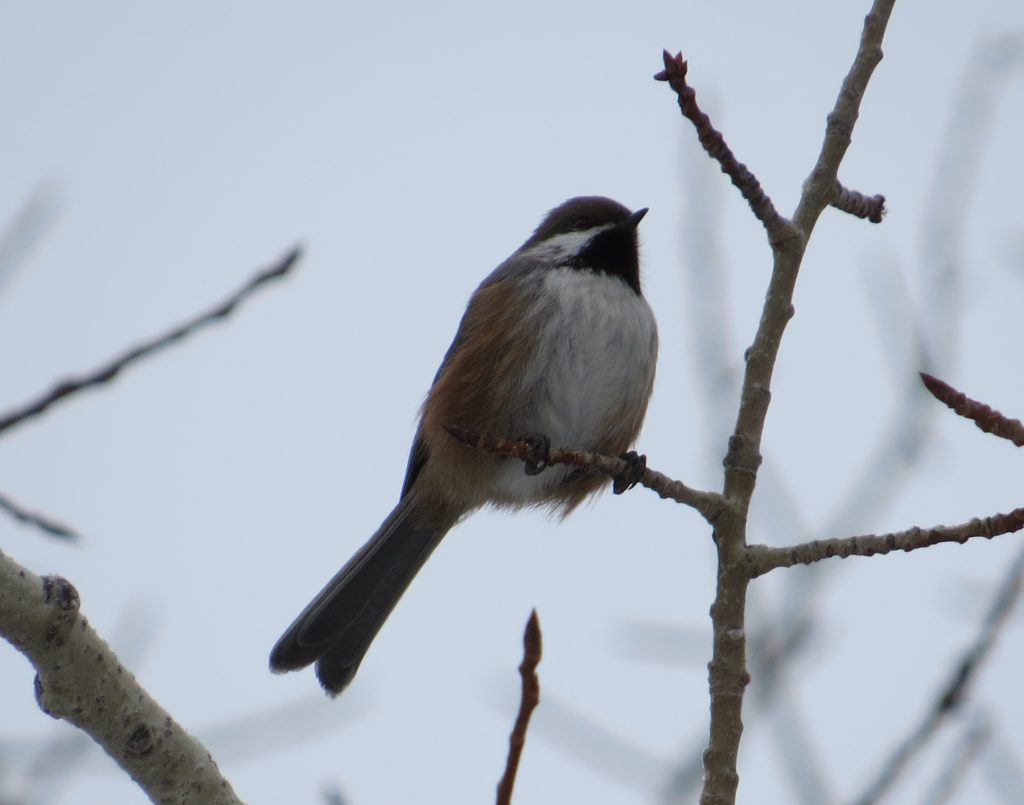 Evan still didn’t share my same level of enthusiasm, but we both shared enthusiasm for the CBC potluck right after finishing our route. The potluck is just as exciting for the nourishment as it is for catching up with other birders and comparing notes on how everybody did. Additionally, it was a reunion of sorts for me as I was among a group of over a dozen people that included several parents of kids I graduated with over 20 years ago. So after food was in our bellies and sufficient small talk was made with people from a past life, it was time to go through everybody’s results. Julie Grahn, who is the compiler for the count, did this by calling out a species and then have everyone go around the table giving their numbers for that species. Evan surprised me when he whispered, “Dad, I want to be the one to say the numbers.” Maybe he was finding some interest in this CBC thing after all, even if he didn’t get a grouse from it. Not surprisingly, Evan and I were the only ones to produce Boreal Chickadees. Surprisingly, our Black-backed Woodpecker was one of four that day. Evan and I also produced half of the total Magpies as well as the only Northern Shrike.
Evan still didn’t share my same level of enthusiasm, but we both shared enthusiasm for the CBC potluck right after finishing our route. The potluck is just as exciting for the nourishment as it is for catching up with other birders and comparing notes on how everybody did. Additionally, it was a reunion of sorts for me as I was among a group of over a dozen people that included several parents of kids I graduated with over 20 years ago. So after food was in our bellies and sufficient small talk was made with people from a past life, it was time to go through everybody’s results. Julie Grahn, who is the compiler for the count, did this by calling out a species and then have everyone go around the table giving their numbers for that species. Evan surprised me when he whispered, “Dad, I want to be the one to say the numbers.” Maybe he was finding some interest in this CBC thing after all, even if he didn’t get a grouse from it. Not surprisingly, Evan and I were the only ones to produce Boreal Chickadees. Surprisingly, our Black-backed Woodpecker was one of four that day. Evan and I also produced half of the total Magpies as well as the only Northern Shrike.
After we bid goodbye to our CBC friends until next year, I decided to run Evan out to the two Hawk Owl spots. Even before we reached the first territory, he was questioning why we were doing this when we’ve seen Hawk Owls before. I tried to explain that they are just that cool and are always worth seeing, especially when they are close. I don’t think he was buying it, though. The first Hawk Owl was right where it was supposed to be. Evan, who had never used binoculars in his early birding days, picked up my pair and looked at the owl. Evan had never seen an owl through quality optics before, and clearly he was impressed. “Whoa! He’s creepy. He has yellow eyes! He’s staring at me!” I chuckled as the little birdwatching kid from the past was back, for however a brief a moment.
We moved on the second Northern Hawk Owl which set up territory right at the edge of the count circle. When we got there, it was on a high pole just outside the circle. This time I set up my scope and zoomed all the way in on this owl for Evan to get a really good look. “Wow! It’s like he’s looking into my soul!”
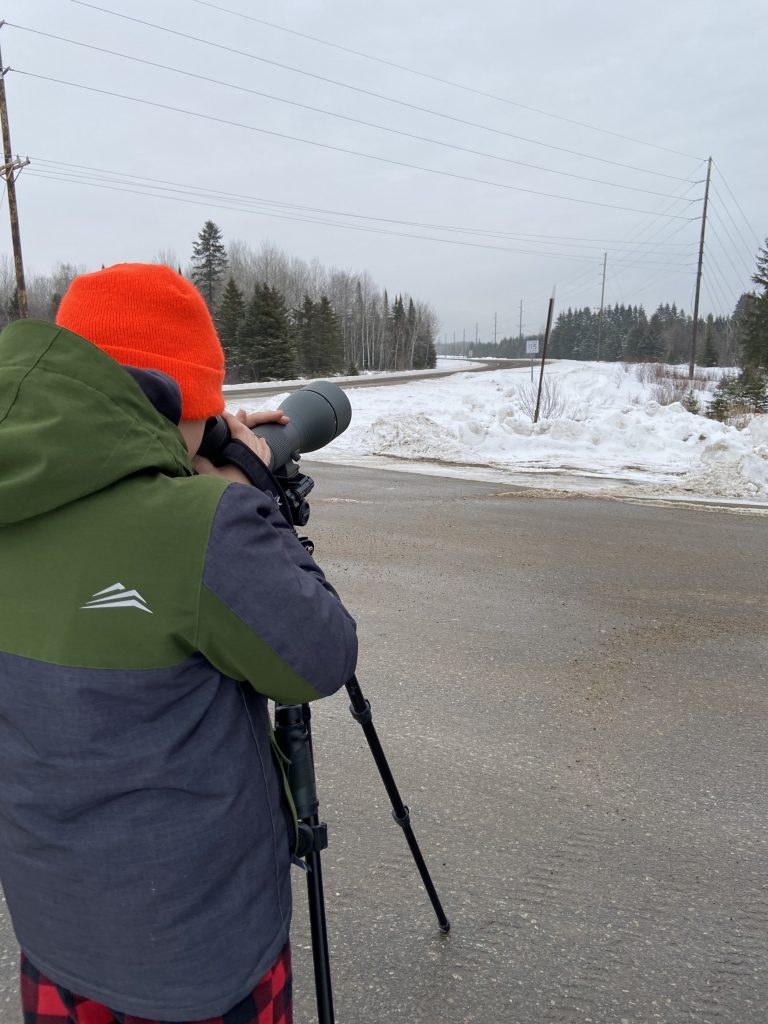
As we watched, the owl did us a huge favor and flew down into the count circle! We thought we saw it go to the ground and guessed that it had gotten a vole. Sure enough, he popped up and landed in the trees right near us with a vole in its talons.
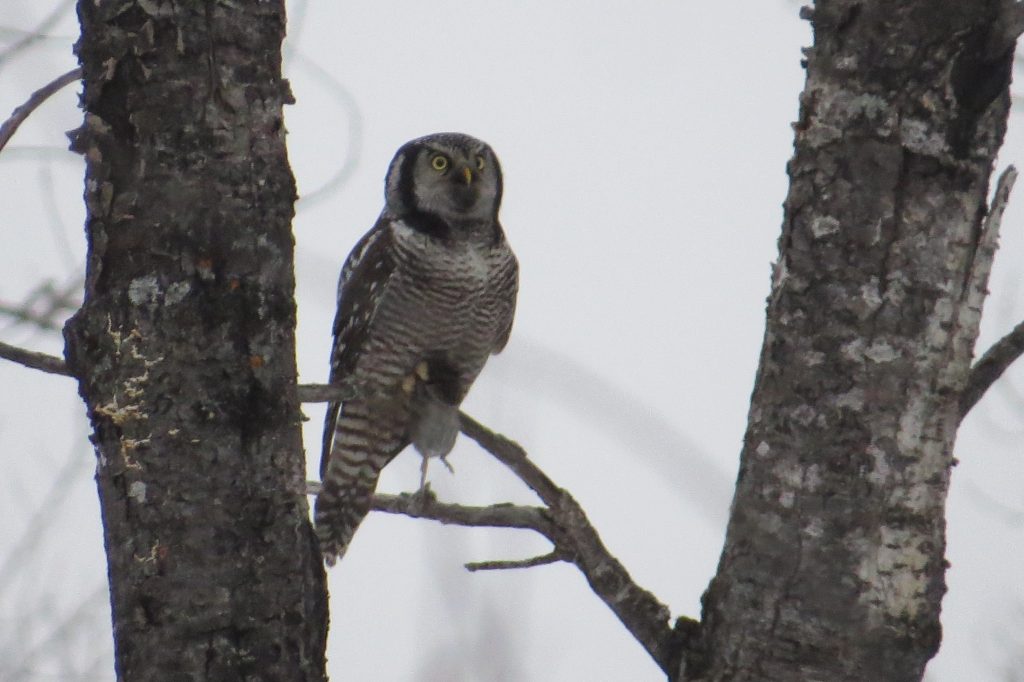
Evan and I were in the car by this point, and the owl kept flying all around us, landing at various perches, and working on downing his meal. “This is incredible. This is absolutely amazing. This is the coolest thing I have ever seen!” Evan was in genuine awe. I hadn’t seen him that excited since we saw the Boreal Owl two years ago. I got just as much a kick out of watching Evan’s reaction as I did watching the Hawk Owl. I think Evan was starting to understand that Hawk Owls are never ever not cool. What other owl not only doesn’t care about you but also gives you the death stare from 20 feet above your car?
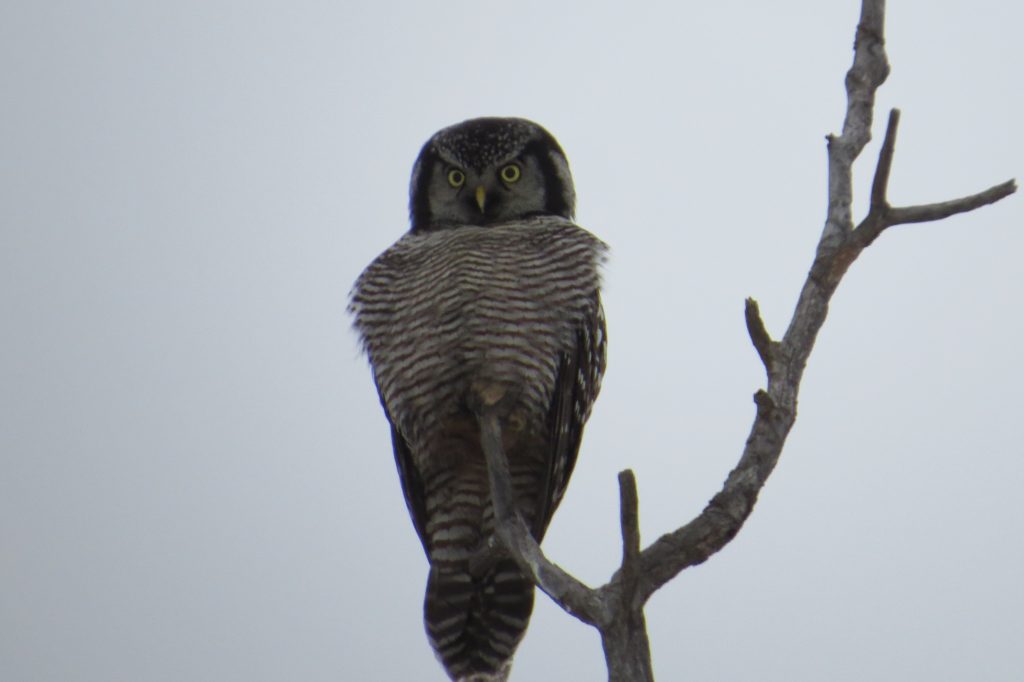 After we texted Julie to let her know that two Hawk Owls were securely in the circle for count day, we headed back toward Grandma and Grandpa’s. I was sure to take a route that would run us through some habitat where I have had good luck seeing Ruffed Grouse over the years at this late hour in the day. When there is so much snow on the ground, the grouse will eat the catkins of birch trees near dusk. As we drove along, we were able to spot two grouse doing just that, and Evan was able to harvest them. And to cap an already great day, I heard and saw our 5th Boreal Chickadee of the day.
After we texted Julie to let her know that two Hawk Owls were securely in the circle for count day, we headed back toward Grandma and Grandpa’s. I was sure to take a route that would run us through some habitat where I have had good luck seeing Ruffed Grouse over the years at this late hour in the day. When there is so much snow on the ground, the grouse will eat the catkins of birch trees near dusk. As we drove along, we were able to spot two grouse doing just that, and Evan was able to harvest them. And to cap an already great day, I heard and saw our 5th Boreal Chickadee of the day.
The next day we were supposed to head back to Willmar, but a huge snowstorm had covered almost the entire state. Traveling would have been treacherous, so we extended our stay one day. The snow was so bad, that when I attempted to go out birding in the middle of the day, I had to turn back because of unplowed roads. The 15-minute foray was not unproductive as it produced three Black-billed Magpies doing their best Bigfoot impressions.
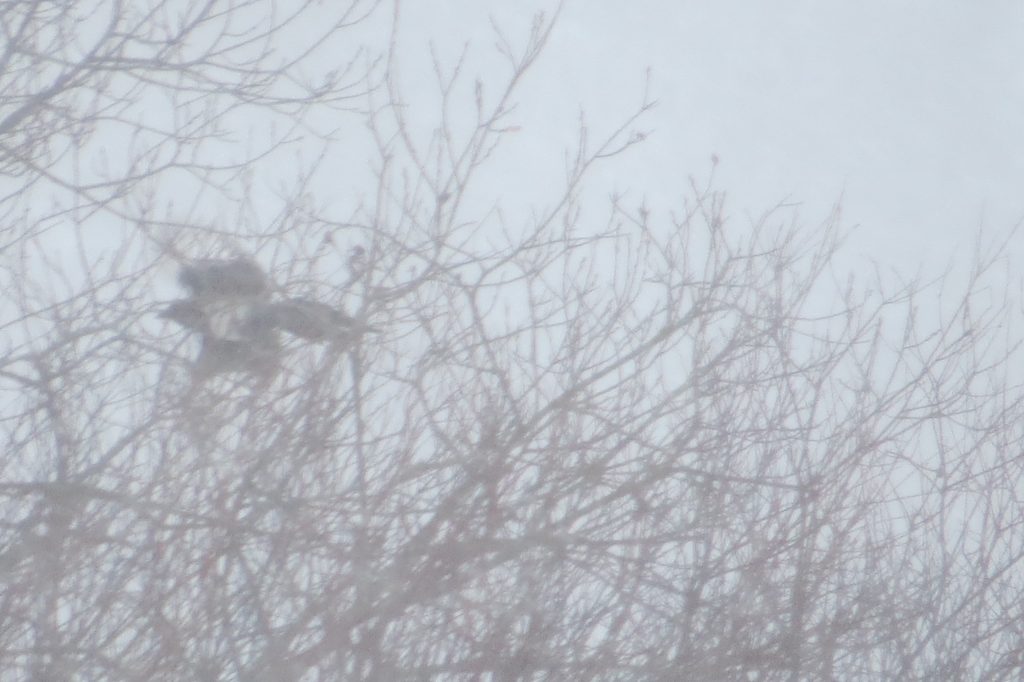 The weather calmed down enough later in the afternoon, and the plows had cleared the roads. So I made another attempt at birding. I really wanted to spend some time in the solitude of the spruce bog, tracking down woodpeckers again. Well, it was a complete 180 from yesterday–absolutely nothing was around. So I began to drive home but always with a watchful and hopeful eye for anything cool. I have longed to see Great Gray Owls on this particular road and have been trying for about 6 years now. I did not see any of the Great Grays, but three moving clumps in the top of a birch tree got the birding juices flowing again. Ruffed Grouse! I looked at the clock and realized that I probably had enough time to go pick up Evan and bring him back to this spot. With an hour until sunset, I figured those birds would be there for a good long while. So I phoned ahead to the house so he would be ready for me to pick him up and make a quick return. Then I marked the tree on Google Maps so I could get right to it again. Within 20 minutes, I had gotten Evan and we were back at the spot except…the grouse were gone. We were both wondering if I was off a bit in my marking, so we continued to scan treetops. Finally I decided to turn around and go looking in the other direction. To turn around, I had to perform a 3-point turn on the narrow gravel road, a move I have perfected over all these years of birding. As I had the car crossways on the gravel road, Evan shouts out, “Dad! An owl!” My mind was reeling. Was it the Great Gray I had been after for so long? Where was it?? I couldn’t find what Evan was seeing. “Dad, it’s right there!” Finally, I caught sight of the owl just 20 feet away perched 6 feet high. It was a beautiful Barred Owl. And it didn’t care that through serendipity we had invaded the exact spot it was hunting.
The weather calmed down enough later in the afternoon, and the plows had cleared the roads. So I made another attempt at birding. I really wanted to spend some time in the solitude of the spruce bog, tracking down woodpeckers again. Well, it was a complete 180 from yesterday–absolutely nothing was around. So I began to drive home but always with a watchful and hopeful eye for anything cool. I have longed to see Great Gray Owls on this particular road and have been trying for about 6 years now. I did not see any of the Great Grays, but three moving clumps in the top of a birch tree got the birding juices flowing again. Ruffed Grouse! I looked at the clock and realized that I probably had enough time to go pick up Evan and bring him back to this spot. With an hour until sunset, I figured those birds would be there for a good long while. So I phoned ahead to the house so he would be ready for me to pick him up and make a quick return. Then I marked the tree on Google Maps so I could get right to it again. Within 20 minutes, I had gotten Evan and we were back at the spot except…the grouse were gone. We were both wondering if I was off a bit in my marking, so we continued to scan treetops. Finally I decided to turn around and go looking in the other direction. To turn around, I had to perform a 3-point turn on the narrow gravel road, a move I have perfected over all these years of birding. As I had the car crossways on the gravel road, Evan shouts out, “Dad! An owl!” My mind was reeling. Was it the Great Gray I had been after for so long? Where was it?? I couldn’t find what Evan was seeing. “Dad, it’s right there!” Finally, I caught sight of the owl just 20 feet away perched 6 feet high. It was a beautiful Barred Owl. And it didn’t care that through serendipity we had invaded the exact spot it was hunting.
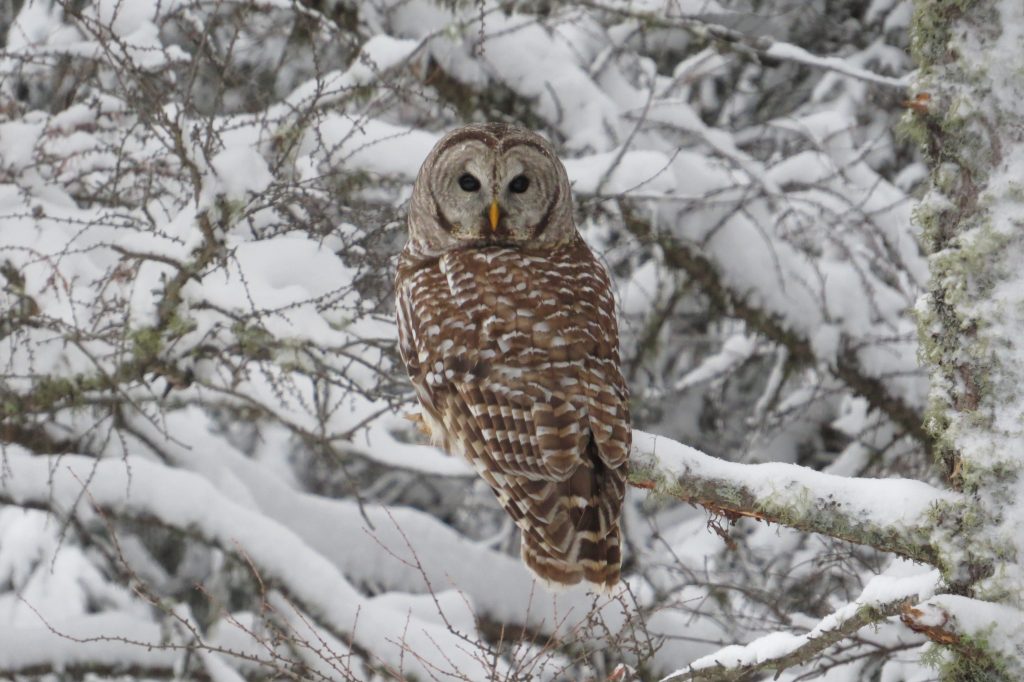 It was truly magical in this winter wonderland. Had we not turned around in that exact spot and had Evan not had watchful eyes, we easily would have missed this owl. Can you see why?
It was truly magical in this winter wonderland. Had we not turned around in that exact spot and had Evan not had watchful eyes, we easily would have missed this owl. Can you see why?
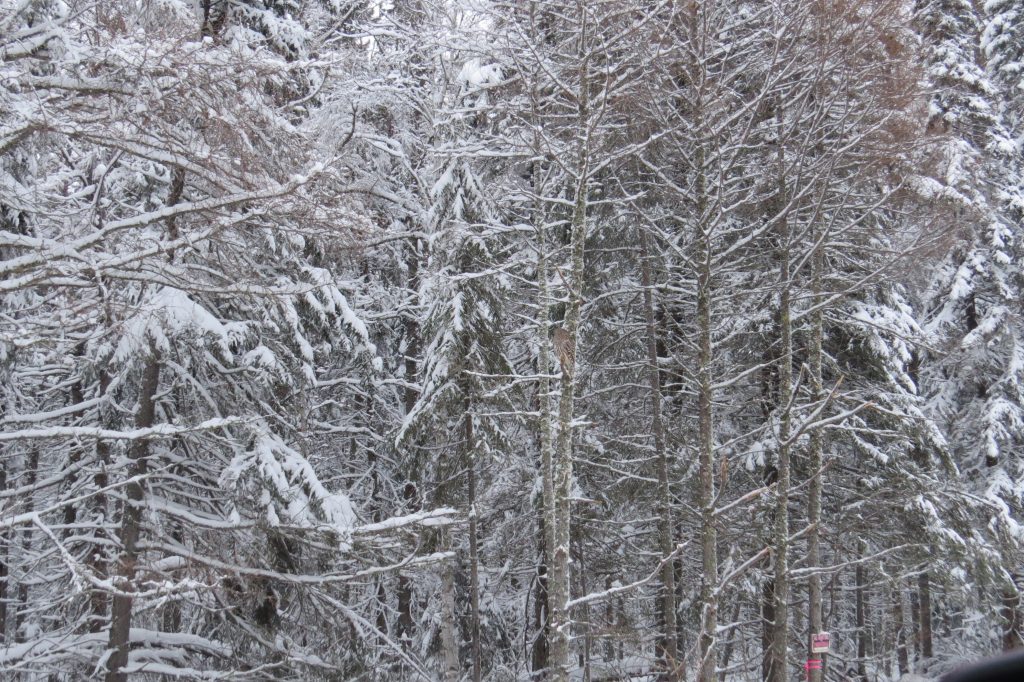 The owl allowed us to complete our 3-point turn and gawk some more. Evan effused more words of awe at this majestic creature that just stared back at us. The little boy who used to get excited about birds was back. It was an incredible moment to share together. We both seemed to have forgotten about grouse completely. It was just a spectacular display of nature–vibrant life that had materialized out of the deep, dark bog.
The owl allowed us to complete our 3-point turn and gawk some more. Evan effused more words of awe at this majestic creature that just stared back at us. The little boy who used to get excited about birds was back. It was an incredible moment to share together. We both seemed to have forgotten about grouse completely. It was just a spectacular display of nature–vibrant life that had materialized out of the deep, dark bog.
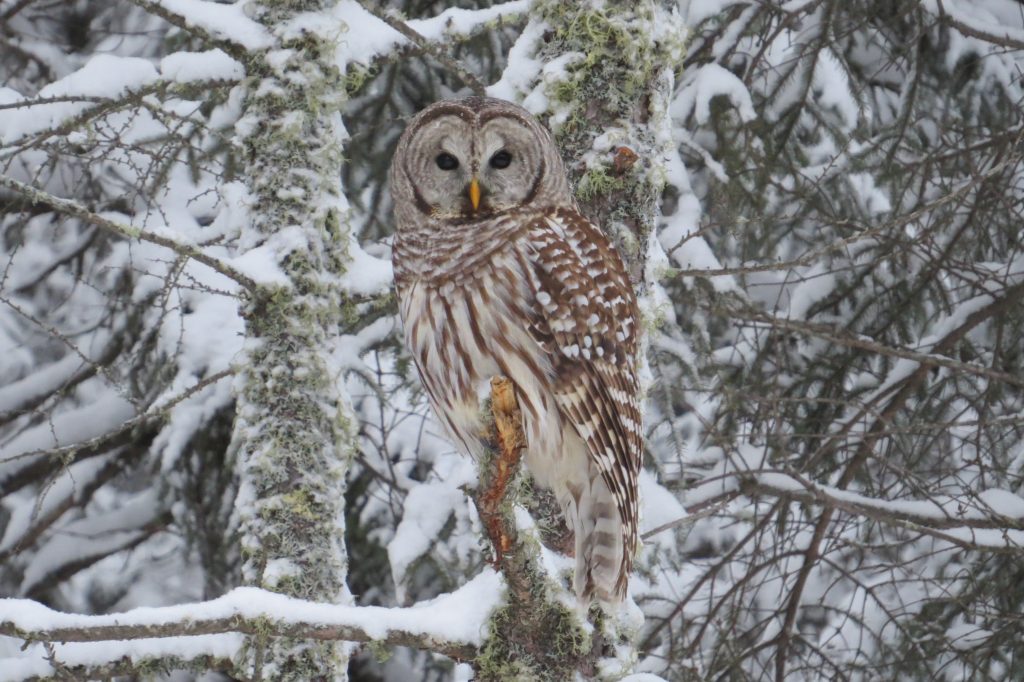 We finally peeled ourselves away from the Barred Owl. Like the owl, we had hunting to do. In that respect we were quite successful. We ended up seeing a total of six more Ruffed Grouse, and Evan was able to take two. As we drove and scanned for grouse, I was struck by how things had come full circle. Almost 30 years ago, I was the one sitting in the passenger seat hoping there would be a grouse to shoot, while being driven around by my dad who didn’t really care if he shot a grouse or not. And in that same vein, maybe someday Evan will return to a greater interest in watching the birds more than hunting. Regardless, we made some great memories together in the northwoods.
We finally peeled ourselves away from the Barred Owl. Like the owl, we had hunting to do. In that respect we were quite successful. We ended up seeing a total of six more Ruffed Grouse, and Evan was able to take two. As we drove and scanned for grouse, I was struck by how things had come full circle. Almost 30 years ago, I was the one sitting in the passenger seat hoping there would be a grouse to shoot, while being driven around by my dad who didn’t really care if he shot a grouse or not. And in that same vein, maybe someday Evan will return to a greater interest in watching the birds more than hunting. Regardless, we made some great memories together in the northwoods.

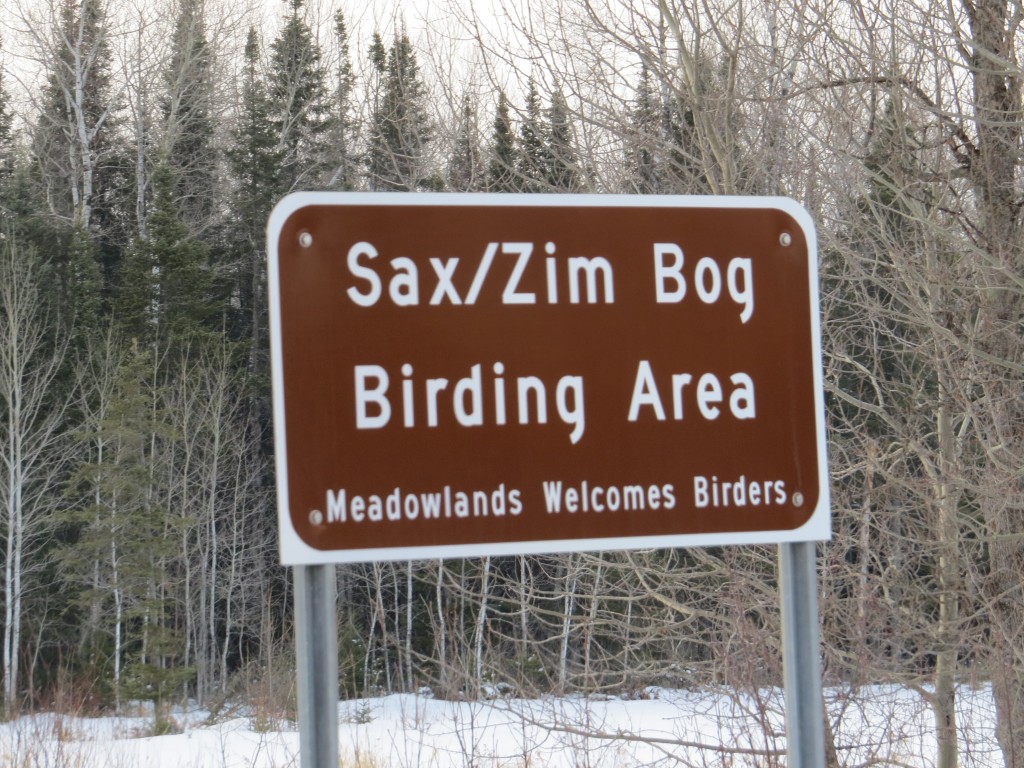
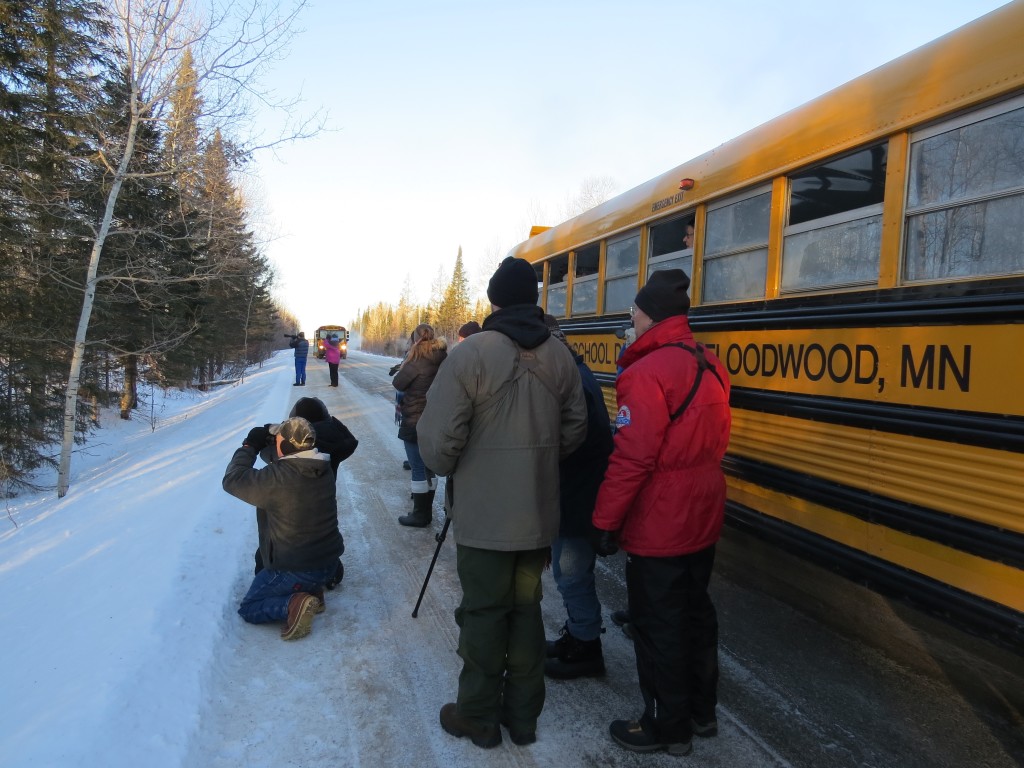 Fumbling with the scope barehanded in 30 below caused me to climb back on the bus immediately after setting up the apparatus, but eventually I did get back out for a couple quick photos myself.
Fumbling with the scope barehanded in 30 below caused me to climb back on the bus immediately after setting up the apparatus, but eventually I did get back out for a couple quick photos myself.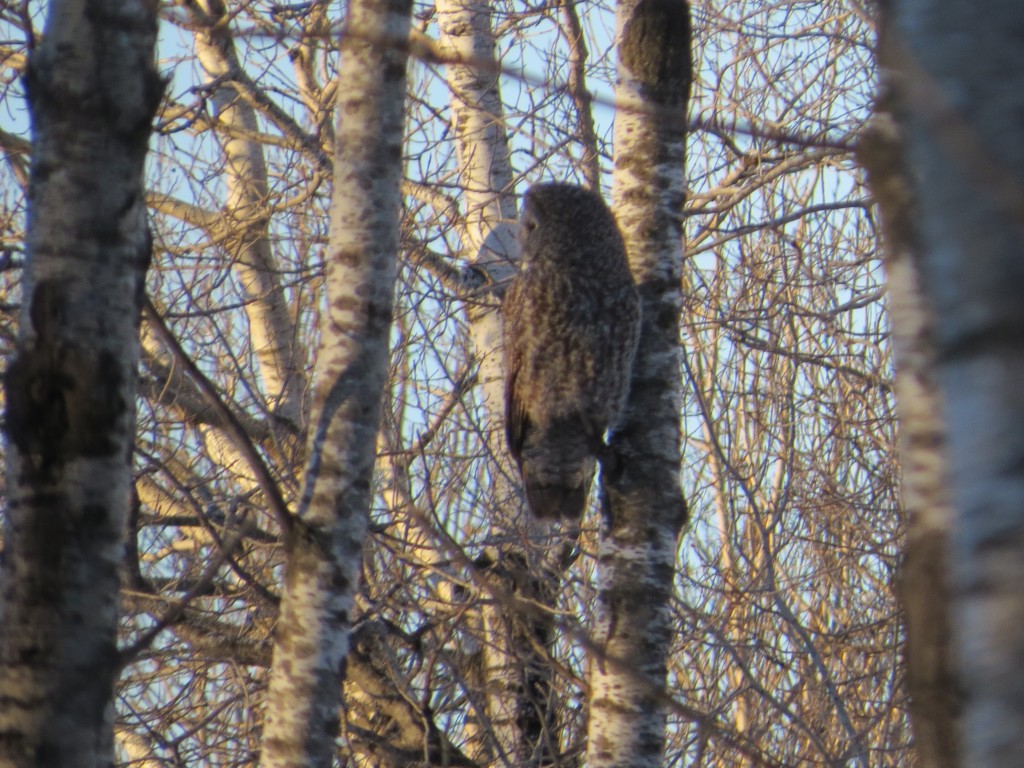
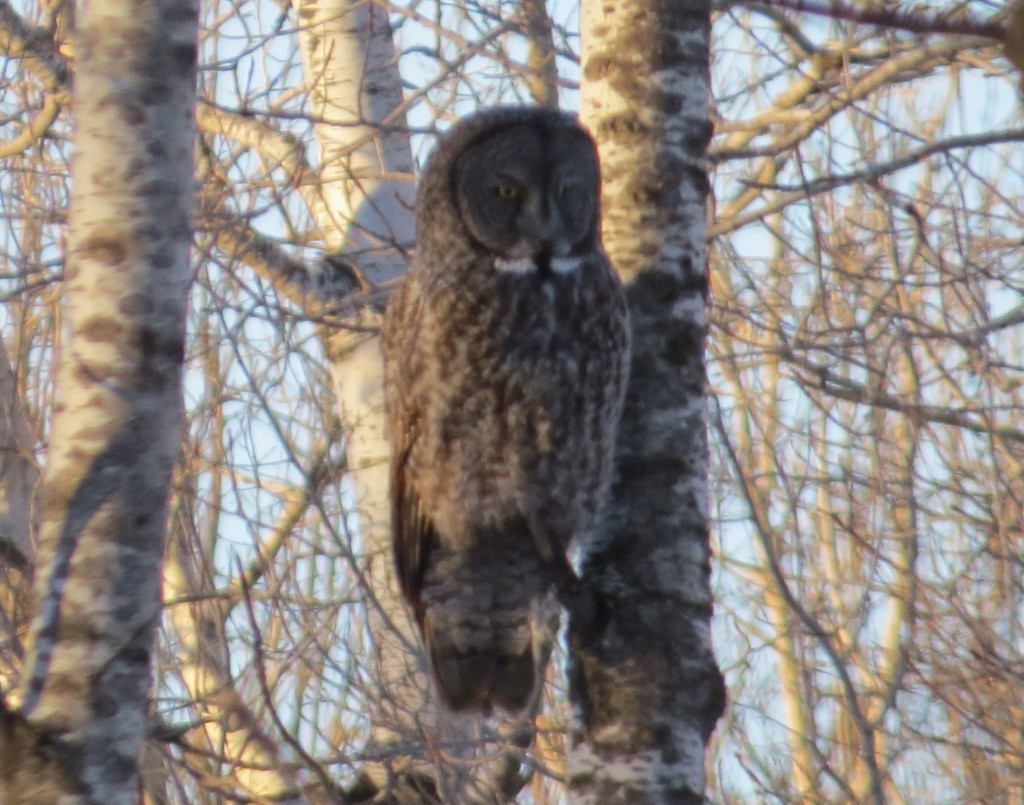
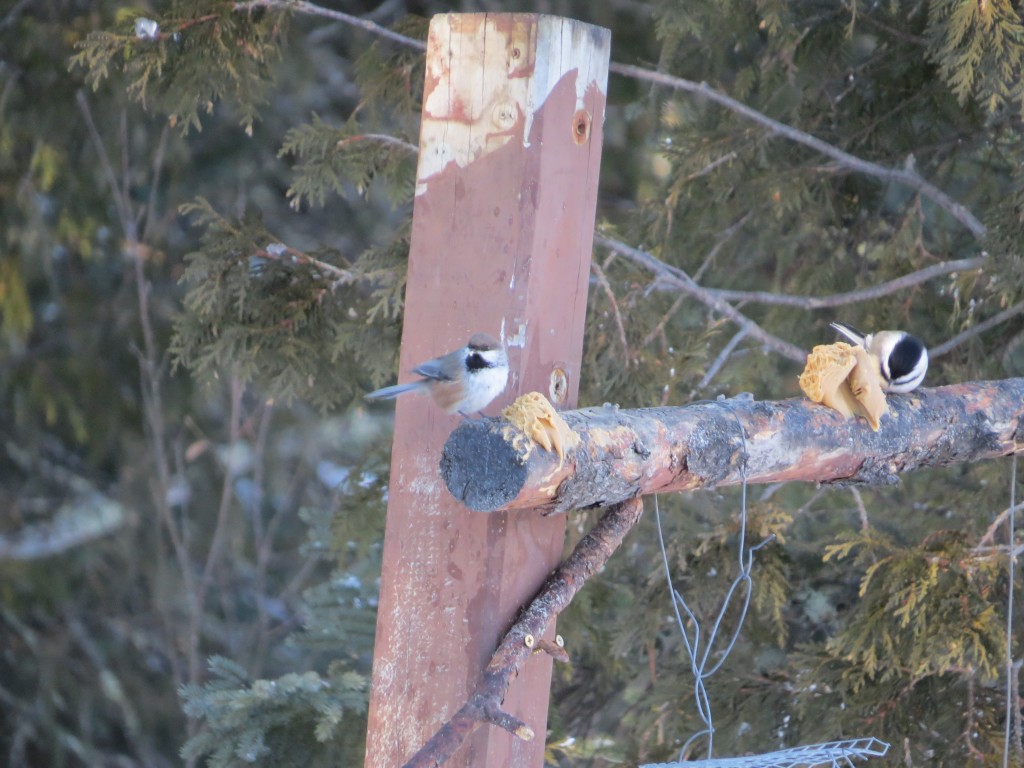
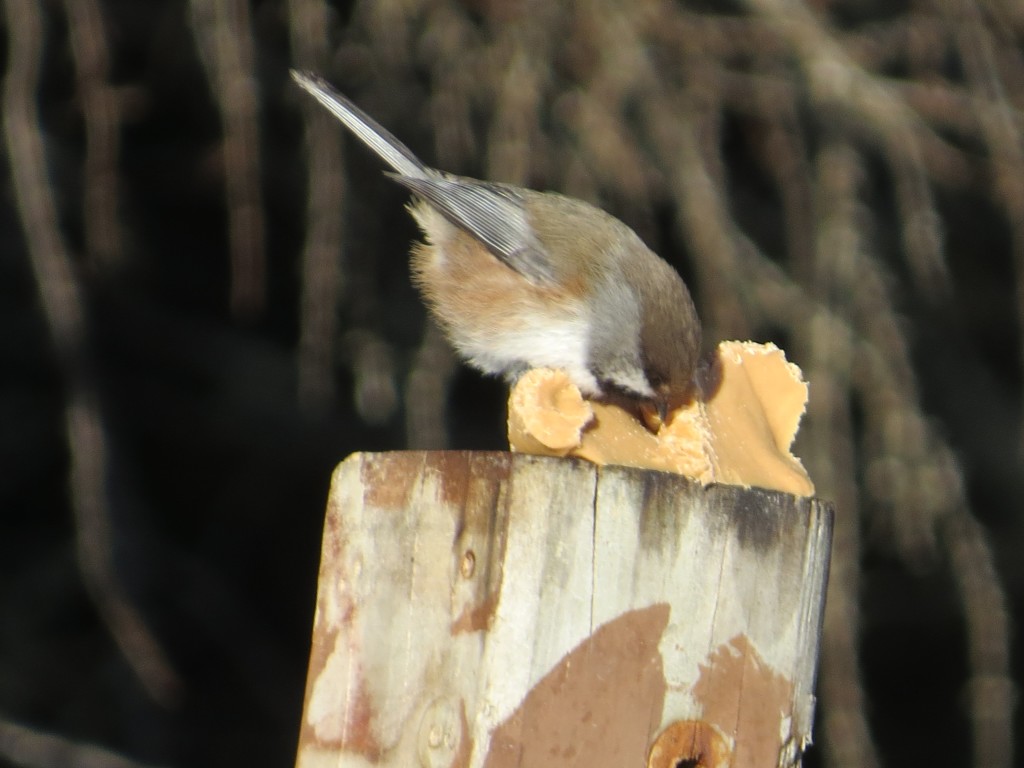 Another crowd favorite were both species of Grosbeaks, though on this day I only photographed the “yellow ones” as locals sometimes call them.
Another crowd favorite were both species of Grosbeaks, though on this day I only photographed the “yellow ones” as locals sometimes call them.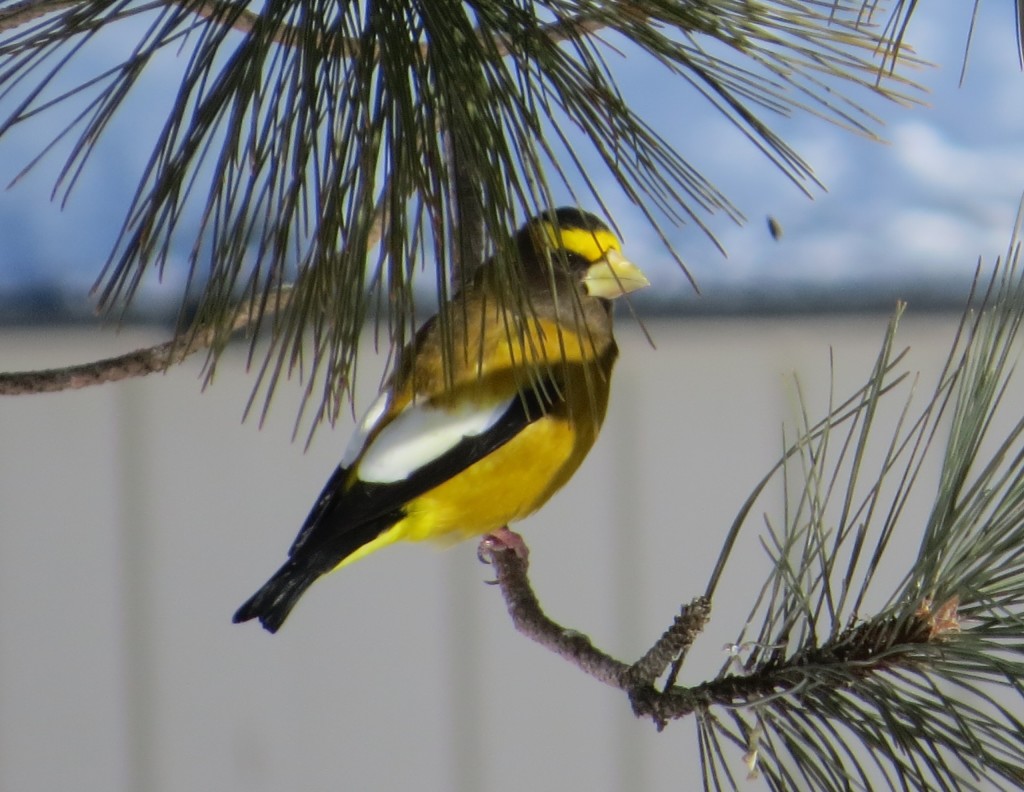 I checked in with Mr. Florida a couple times throughout the day to see what his lifer tally was. Besides the Great Gray, both Grosbeaks, and the Chickadee, he also picked up Northern Shrike, Common Redpoll, and a surprisingly hard-to-find Gray Jay. Despite missing on Ruffed and Sharp-tailed Grouse, Mr. Florida had the highest lifer total for our group. He was happy, especially because he told me he was not expecting the Great Gray.
I checked in with Mr. Florida a couple times throughout the day to see what his lifer tally was. Besides the Great Gray, both Grosbeaks, and the Chickadee, he also picked up Northern Shrike, Common Redpoll, and a surprisingly hard-to-find Gray Jay. Despite missing on Ruffed and Sharp-tailed Grouse, Mr. Florida had the highest lifer total for our group. He was happy, especially because he told me he was not expecting the Great Gray.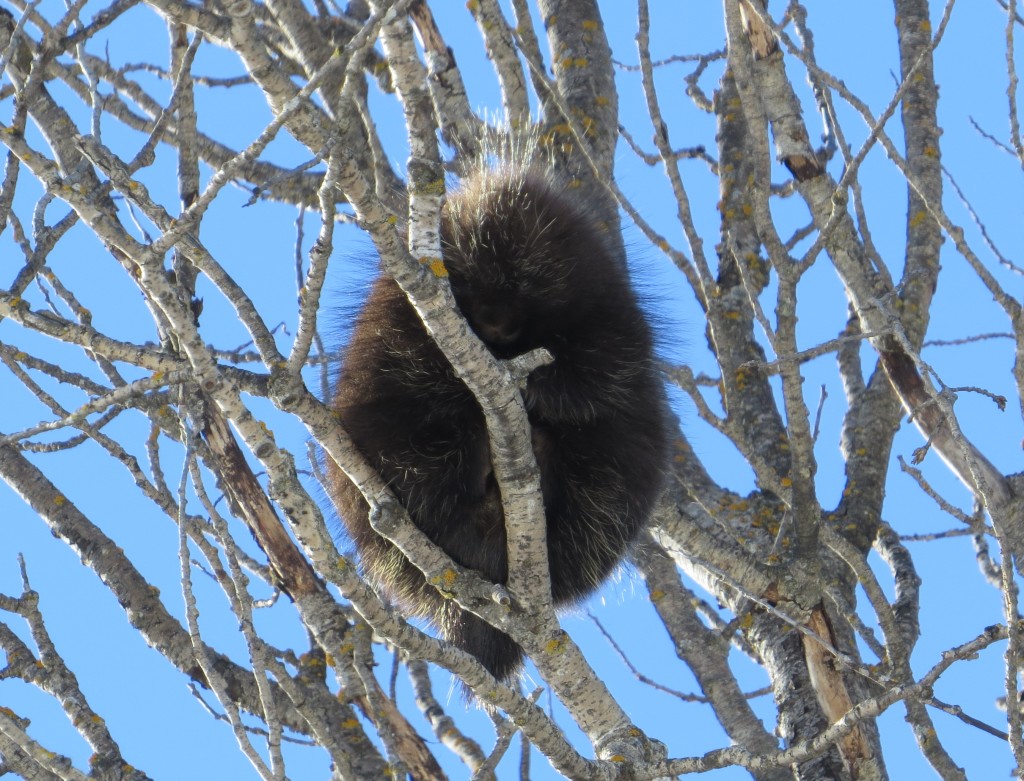 After birding for some time, our day was truncated late afternoon and did not allow for more Owl searching during prime evening hours as we had to get back to Meadowlands for the dinner and program by Canadian Great Gray Owl researcher, Dr. James Duncan. Listening to an authority on Great Gray Owls give a captivating presentation in a Canadian accent is like a giant exclamation point on a day in which many got their coveted lifer.
After birding for some time, our day was truncated late afternoon and did not allow for more Owl searching during prime evening hours as we had to get back to Meadowlands for the dinner and program by Canadian Great Gray Owl researcher, Dr. James Duncan. Listening to an authority on Great Gray Owls give a captivating presentation in a Canadian accent is like a giant exclamation point on a day in which many got their coveted lifer.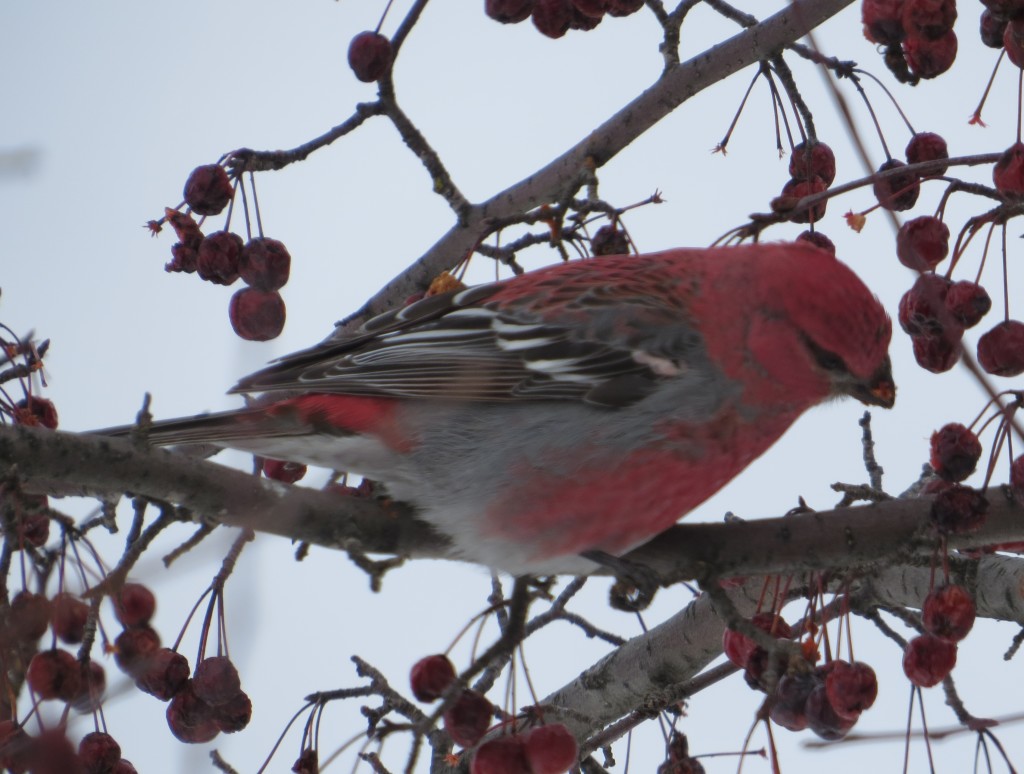
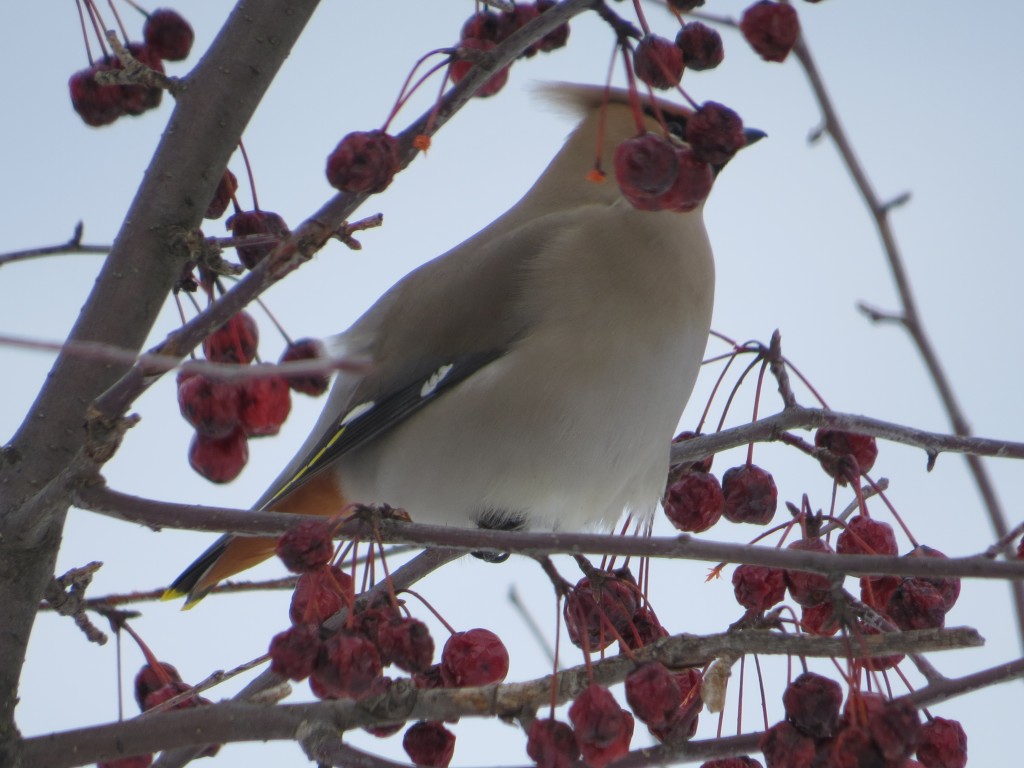 These were photo upgrades for me, though much work still needs to be done with this species. Considering I was sandwiched between a bus and a snowbank, I’ll take them though.
These were photo upgrades for me, though much work still needs to be done with this species. Considering I was sandwiched between a bus and a snowbank, I’ll take them though.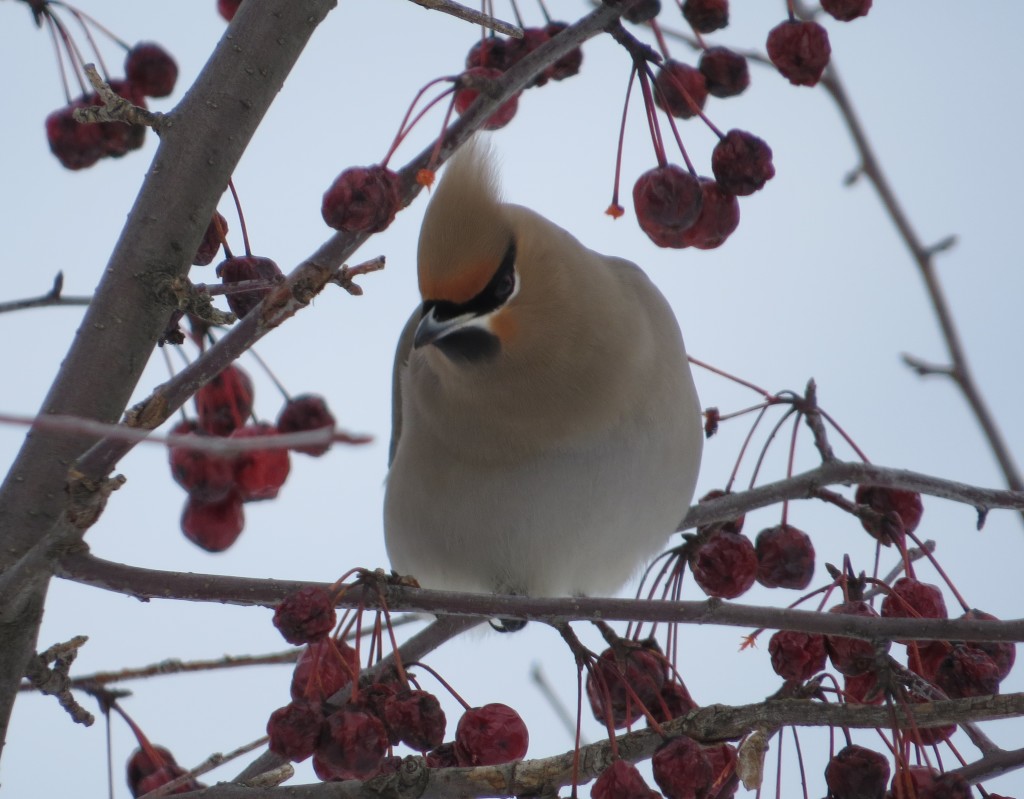
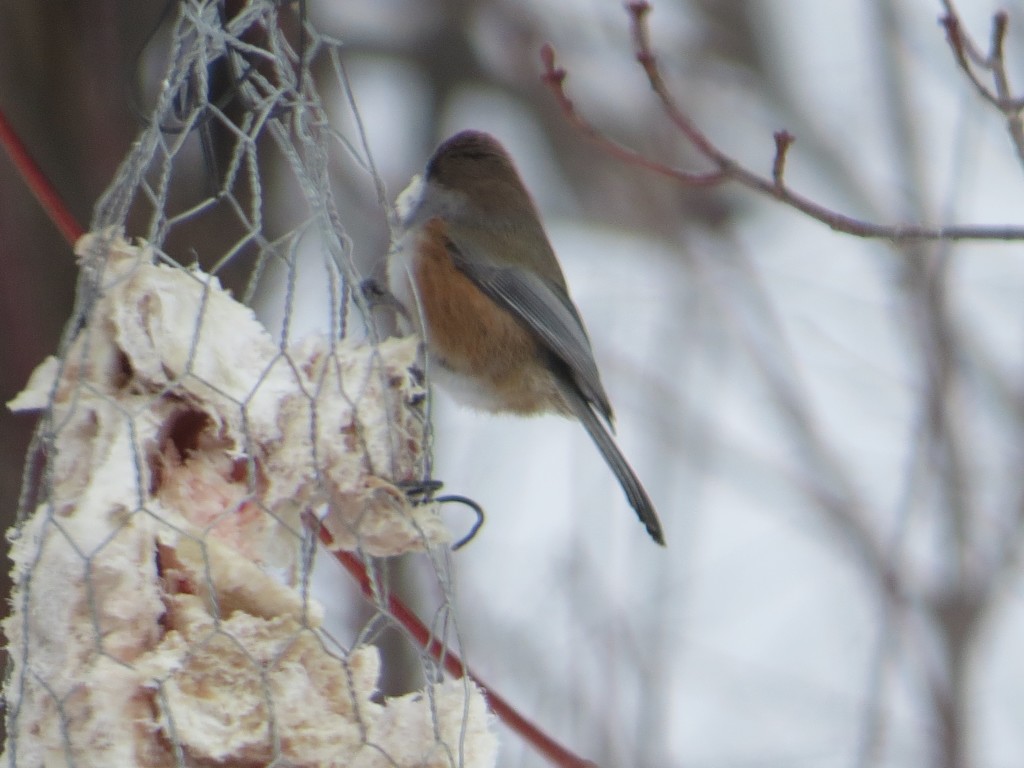 Then again, maybe I should have considering the address.
Then again, maybe I should have considering the address.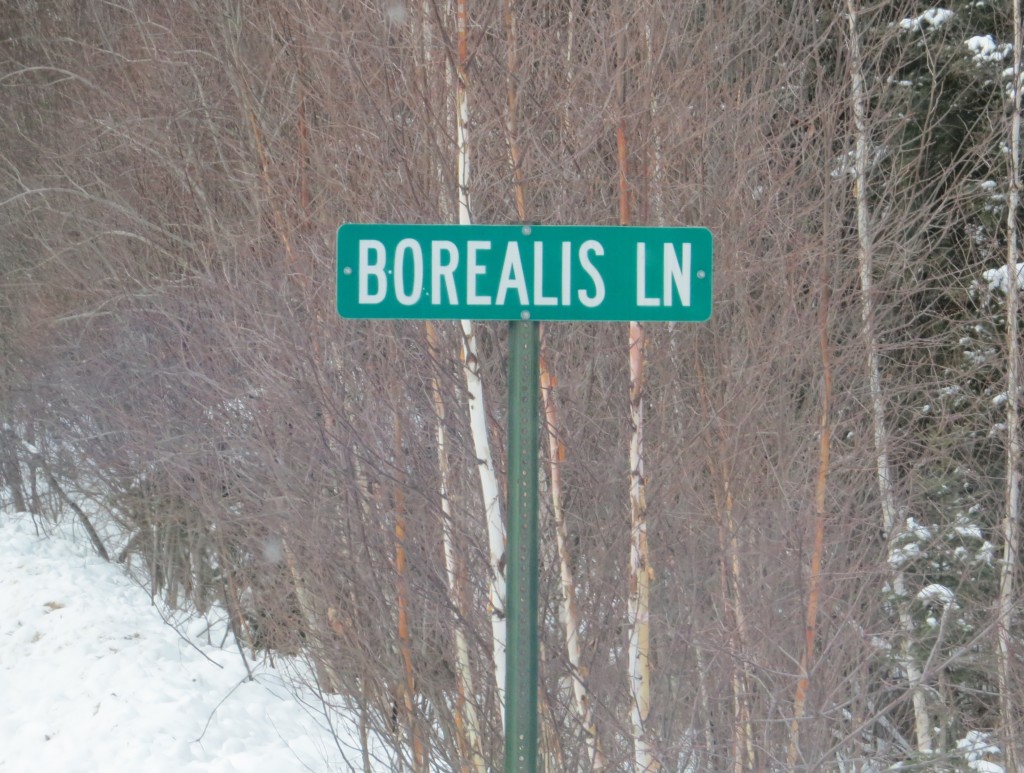 Our group continued on from the B&B searching towns on the way back for the ever elusive Bohemians. A Snowshoe Hare, thought he was elusive and brought some excitement to the group when the birds were lacking.
Our group continued on from the B&B searching towns on the way back for the ever elusive Bohemians. A Snowshoe Hare, thought he was elusive and brought some excitement to the group when the birds were lacking.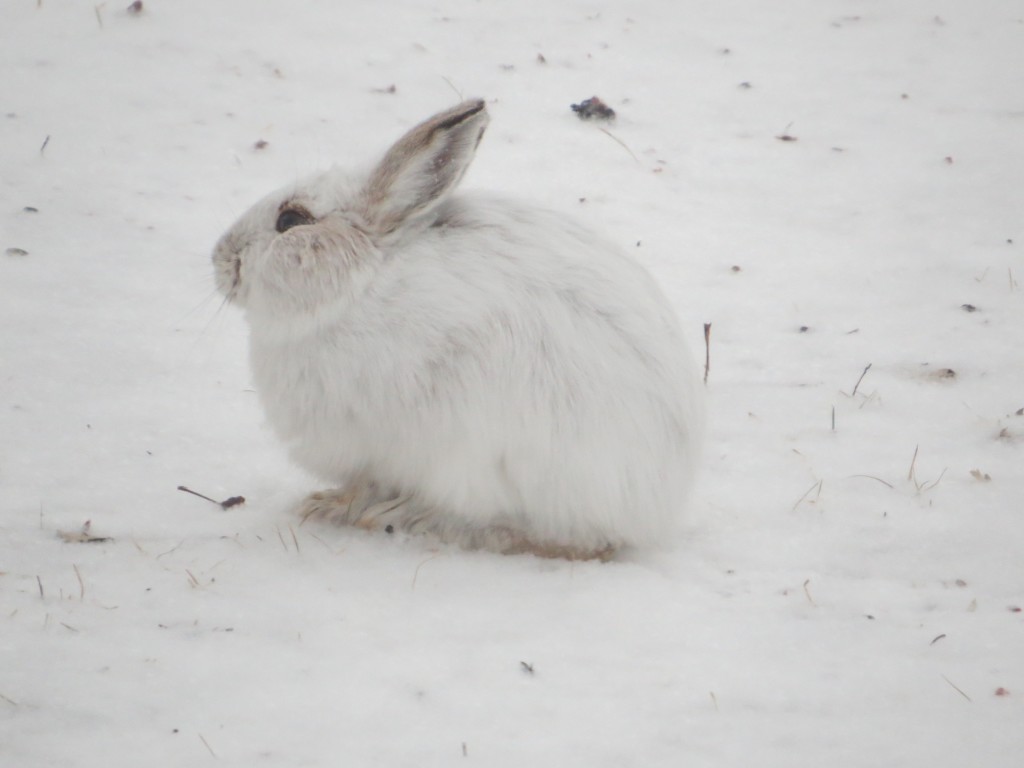 With one major bird lifer and one mammal lifer for the group, it was a long, sleepy day. We did have a slight pick-me-up when we were coming back into the Sax-Zim Bog and spotted a very out-of-season Common Grackle. But still, it’s a Grackle and doesn’t come close to filling the Sprucie void. There’s always next year. After all, it gives the festival-goers and guides a reason to return. As if they need another reason…
With one major bird lifer and one mammal lifer for the group, it was a long, sleepy day. We did have a slight pick-me-up when we were coming back into the Sax-Zim Bog and spotted a very out-of-season Common Grackle. But still, it’s a Grackle and doesn’t come close to filling the Sprucie void. There’s always next year. After all, it gives the festival-goers and guides a reason to return. As if they need another reason…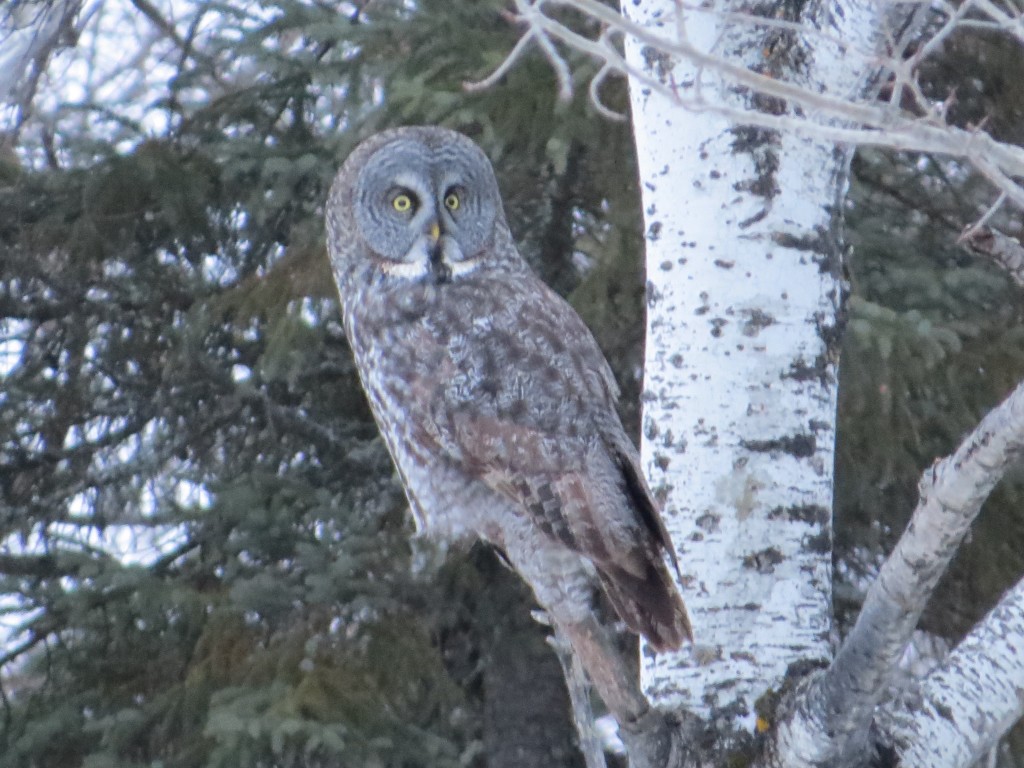
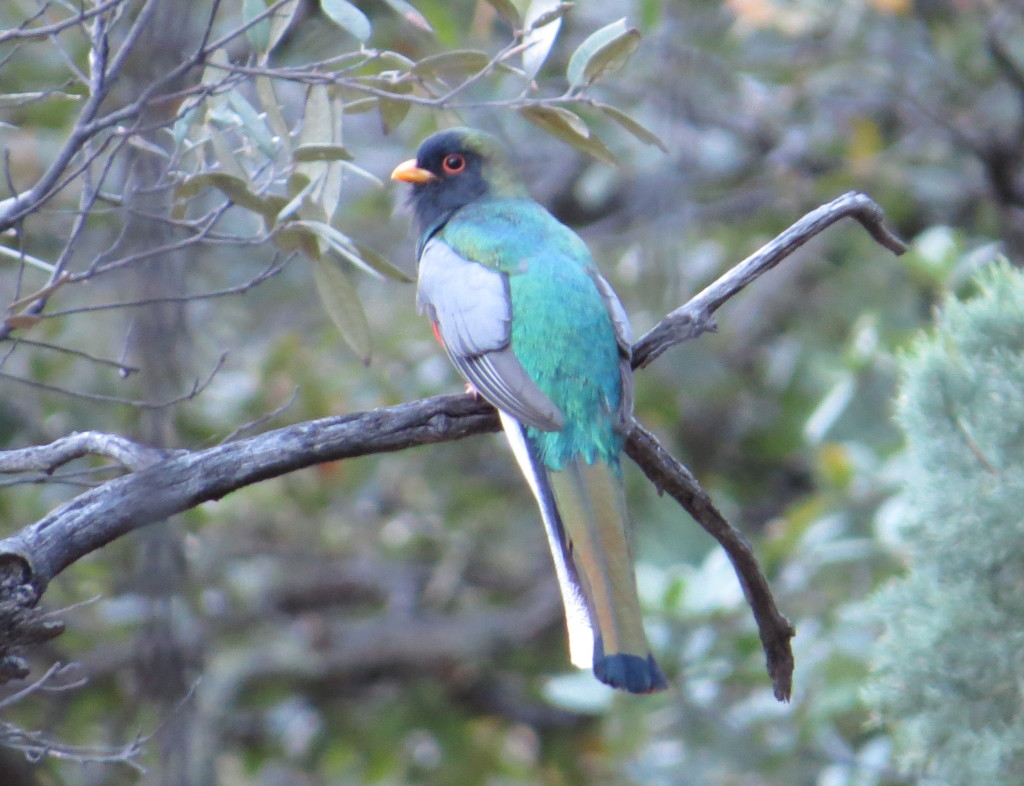 and over…
and over…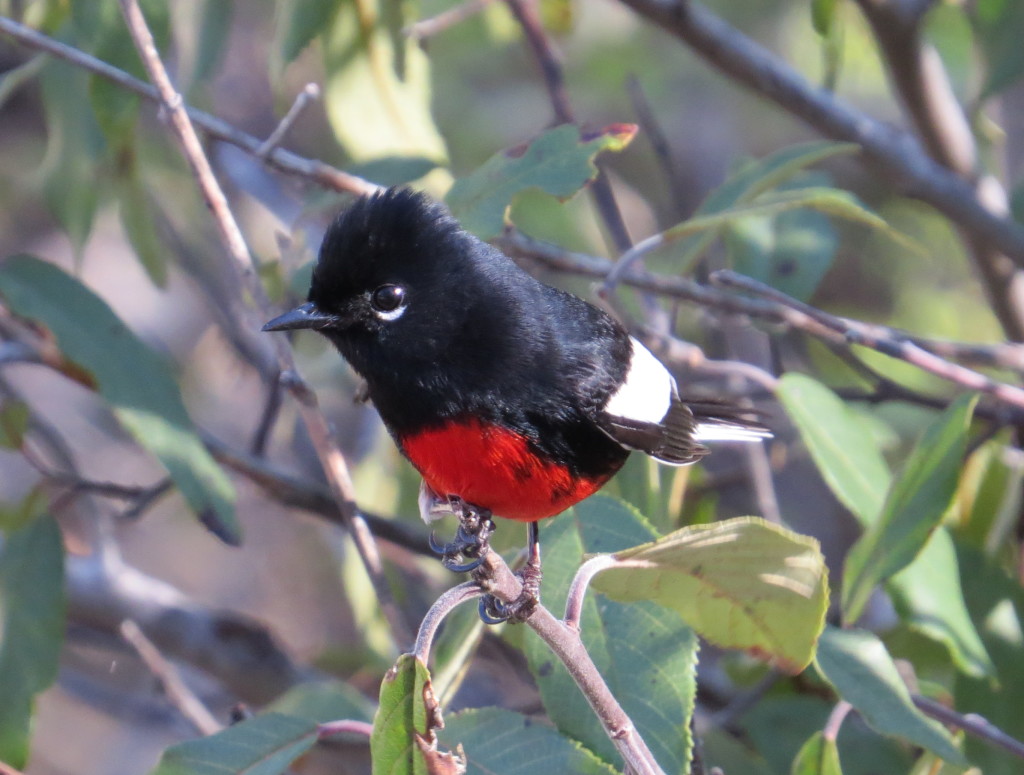 and over.
and over.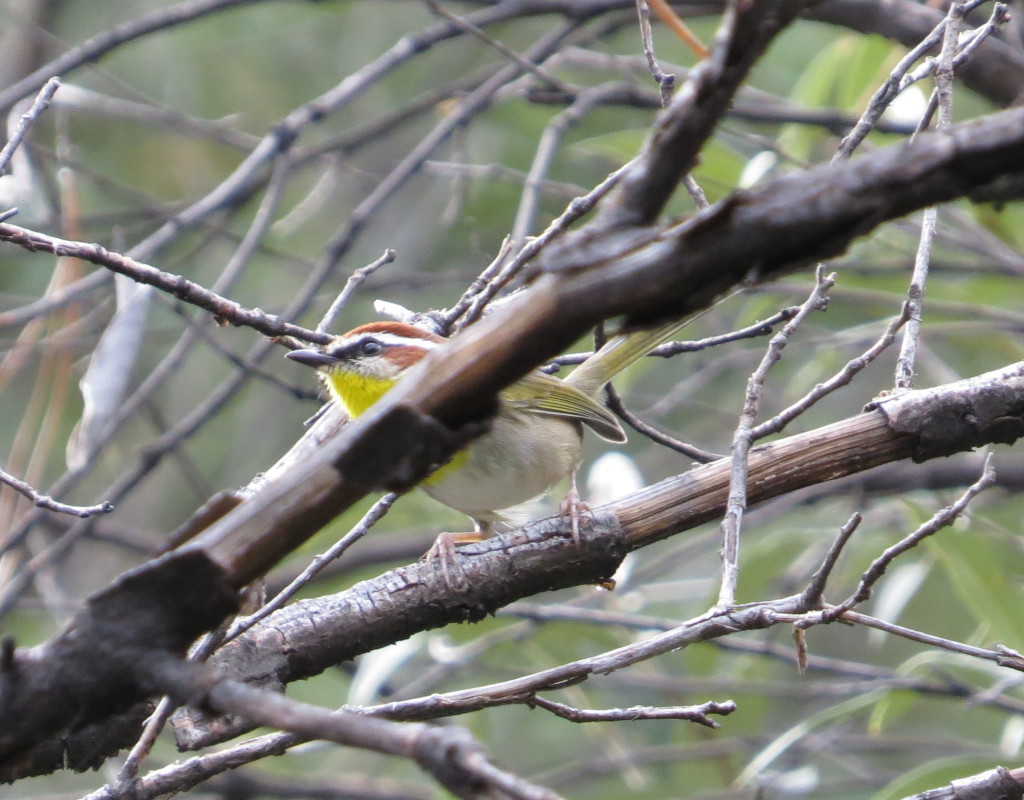

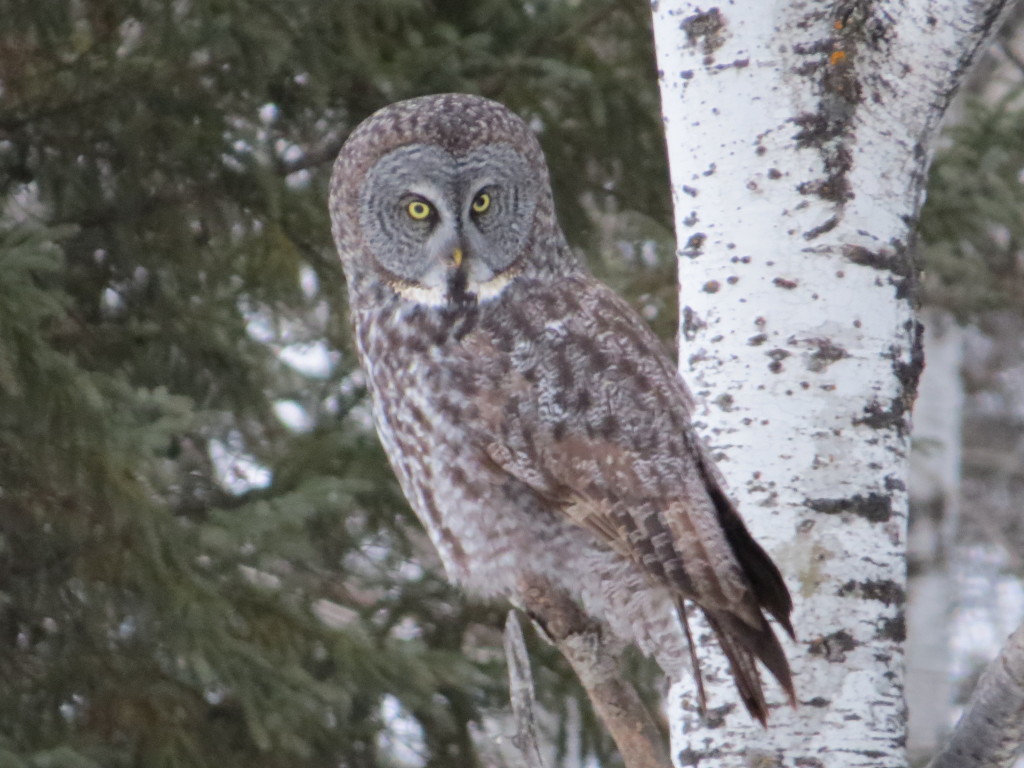
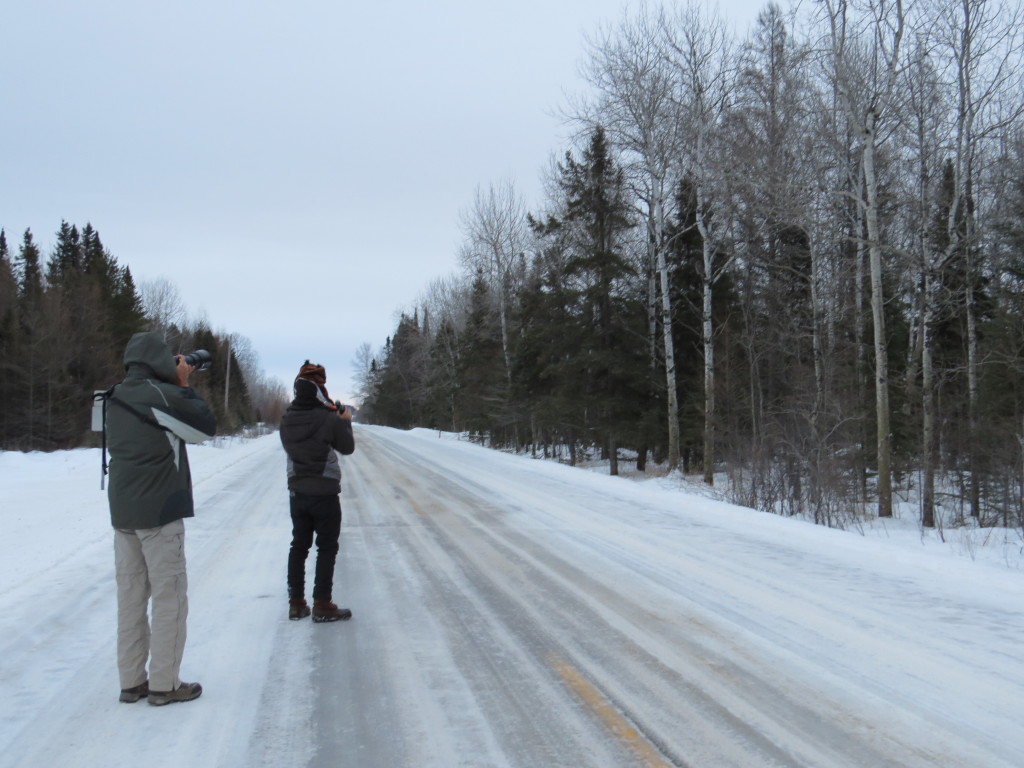 Not only was it thrill to watch these guys get this incredible lifer, but I also enjoyed seeing a Great Gray in a new (to me) part of the Bog. It doesn’t matter where these guys are, though. They are just plain cool.
Not only was it thrill to watch these guys get this incredible lifer, but I also enjoyed seeing a Great Gray in a new (to me) part of the Bog. It doesn’t matter where these guys are, though. They are just plain cool.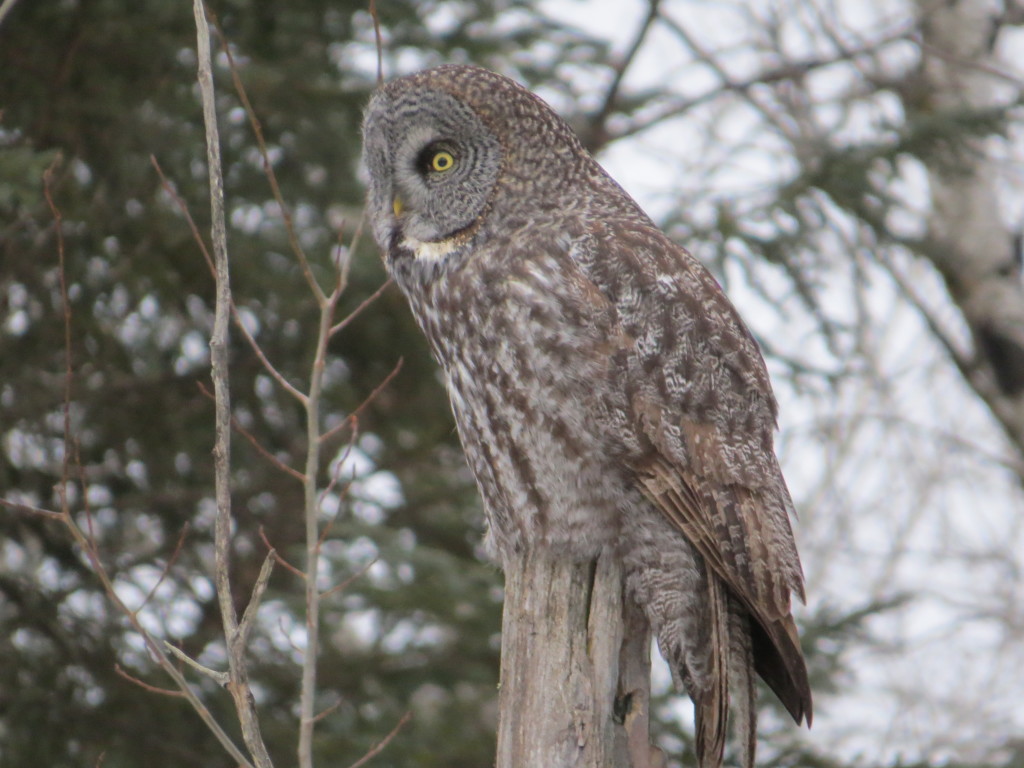
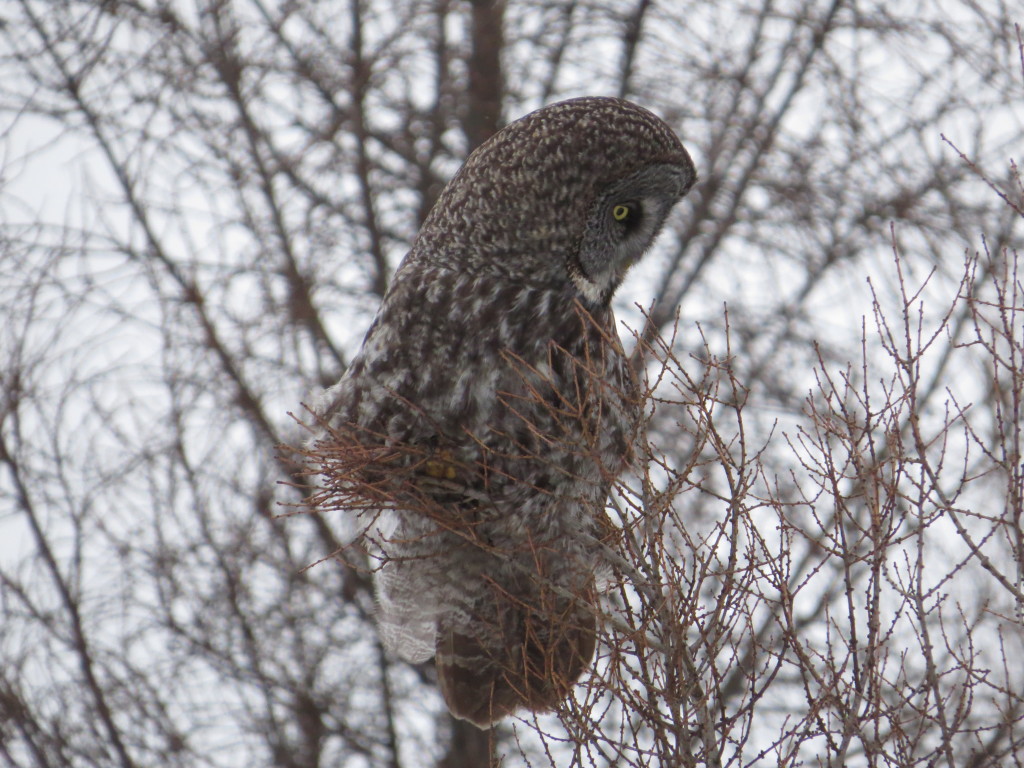
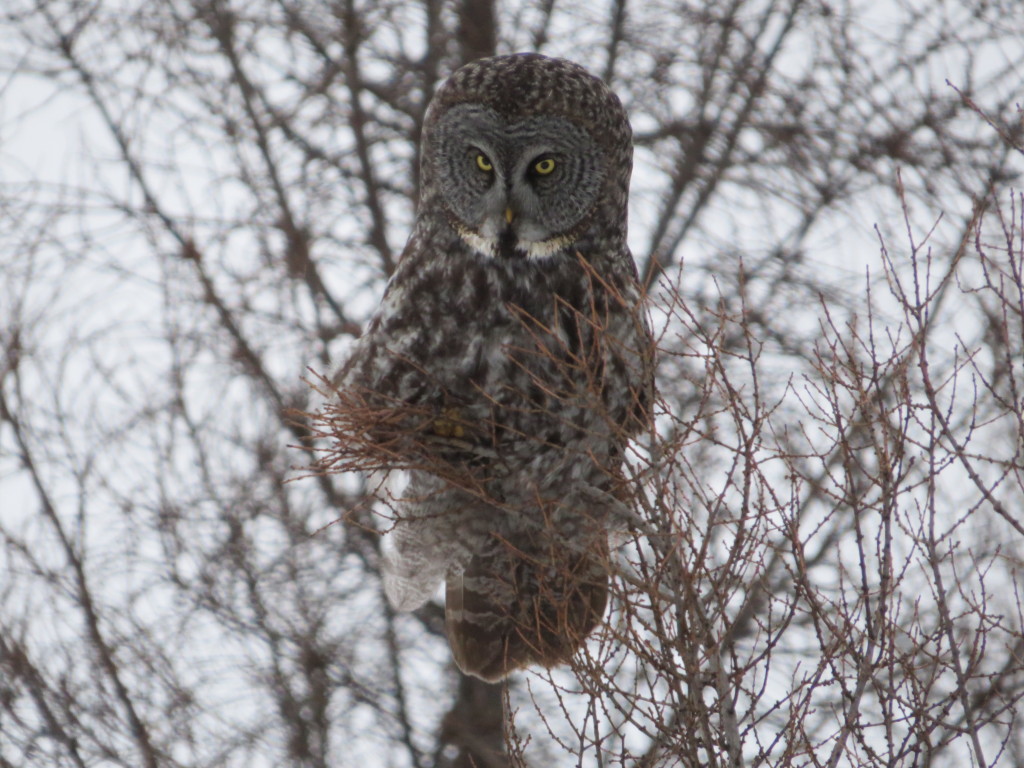
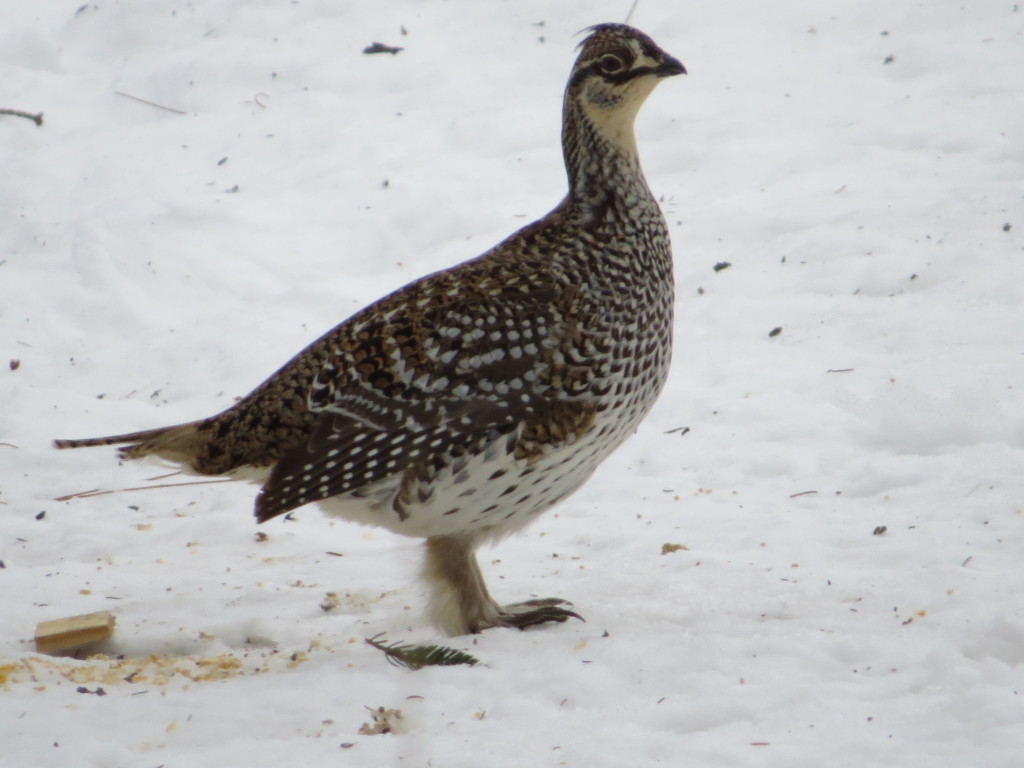 The guys even got to see the males of this new lifer doing their courtship dances! That was topped off by the Grouse coming roadside to feast at a local resident’s feeders before retiring for the day. It really couldn’t have been a better experience for viewing this bird.
The guys even got to see the males of this new lifer doing their courtship dances! That was topped off by the Grouse coming roadside to feast at a local resident’s feeders before retiring for the day. It really couldn’t have been a better experience for viewing this bird.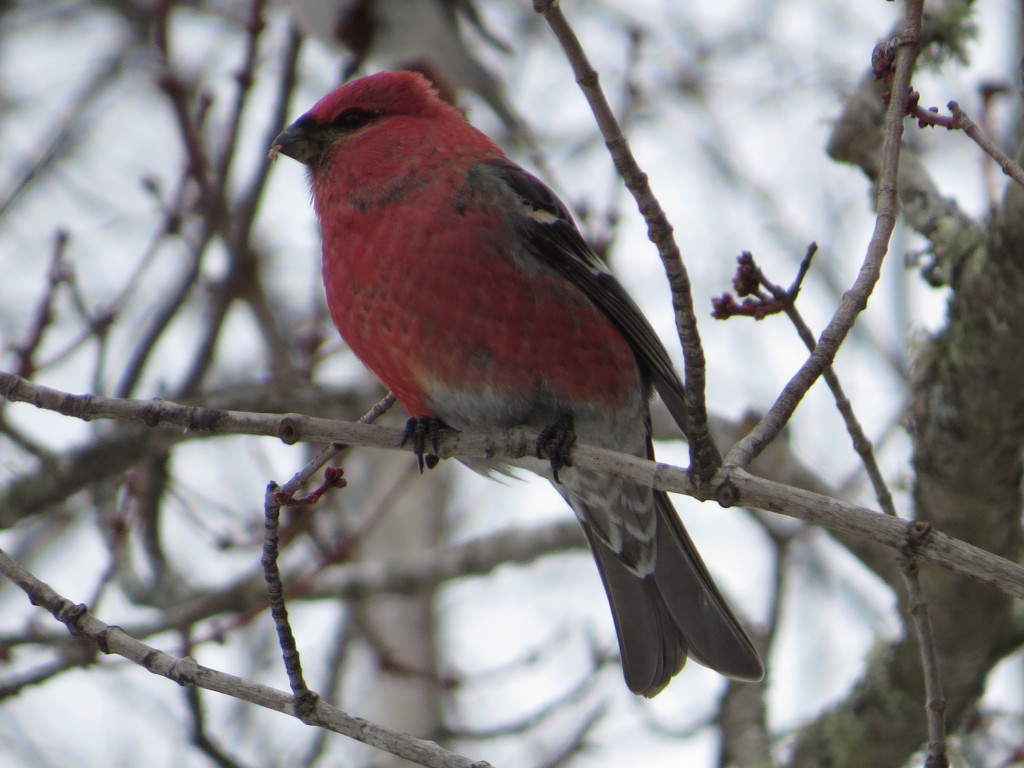 This is a bird I previously had terrible photos of, so this felt good to see a male up close.
This is a bird I previously had terrible photos of, so this felt good to see a male up close.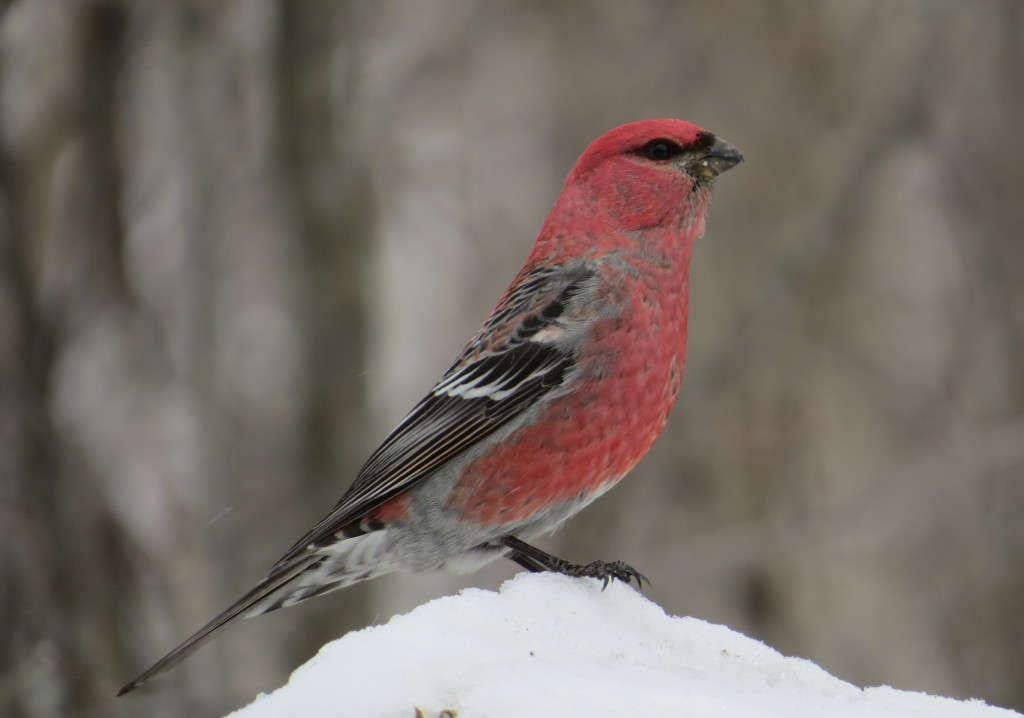 And of course, there were Common Redpolls which is a lifer for the guys. There are always Redpolls. This one had some potential for…oh, who cares anymore?
And of course, there were Common Redpolls which is a lifer for the guys. There are always Redpolls. This one had some potential for…oh, who cares anymore?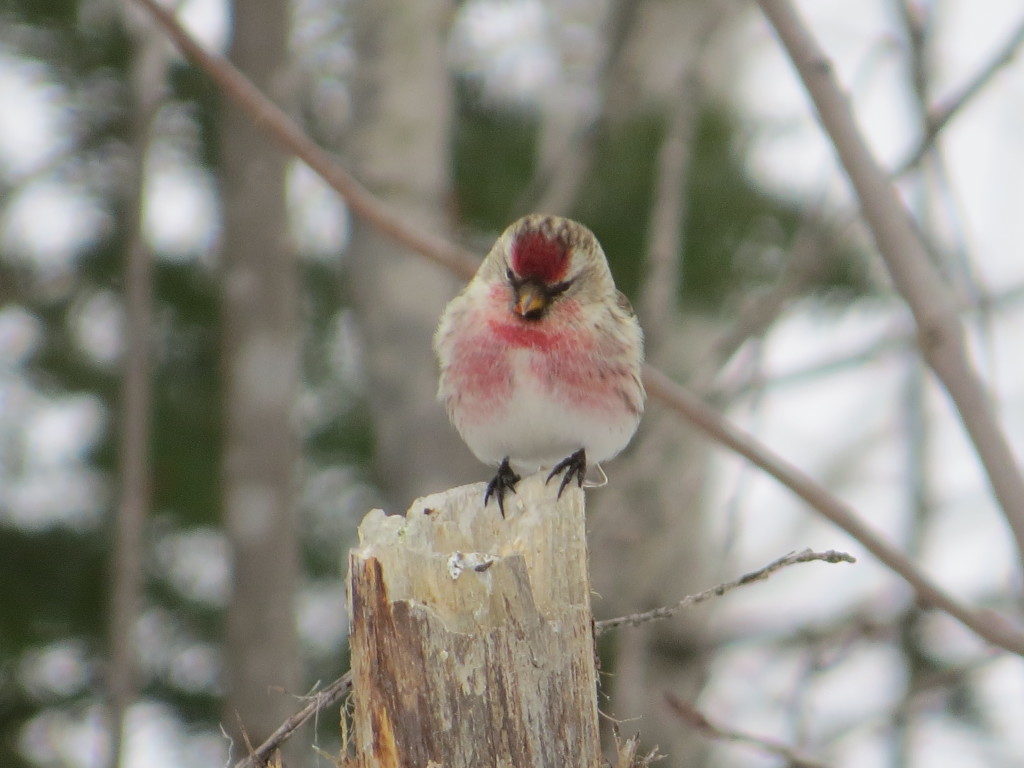
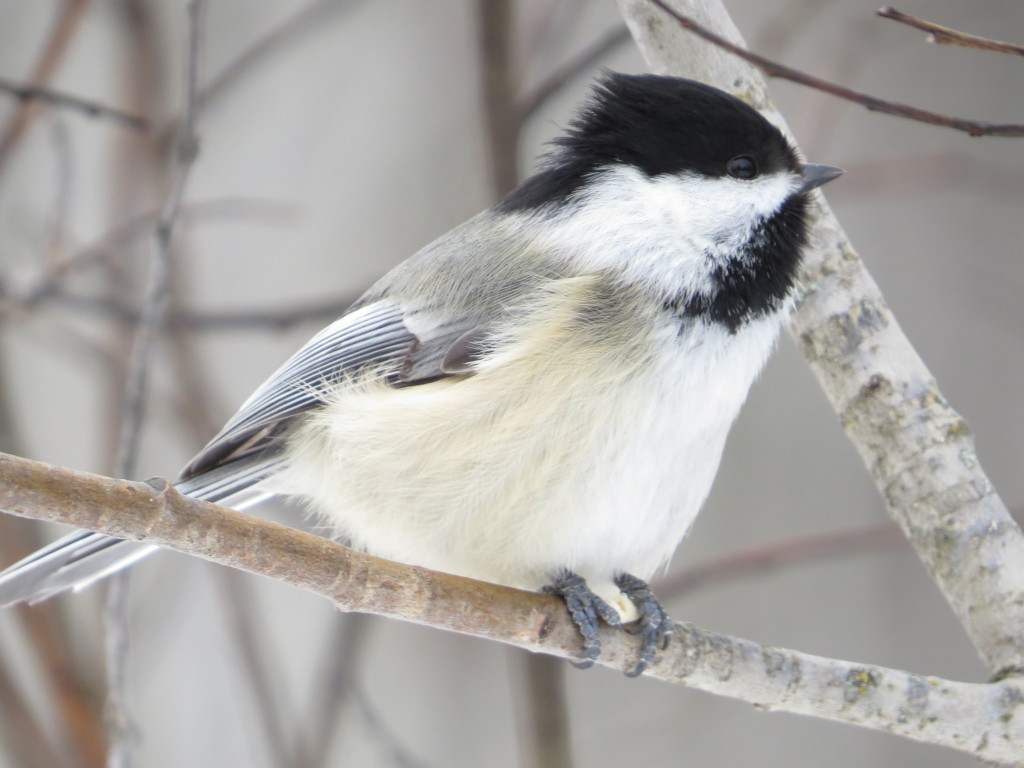
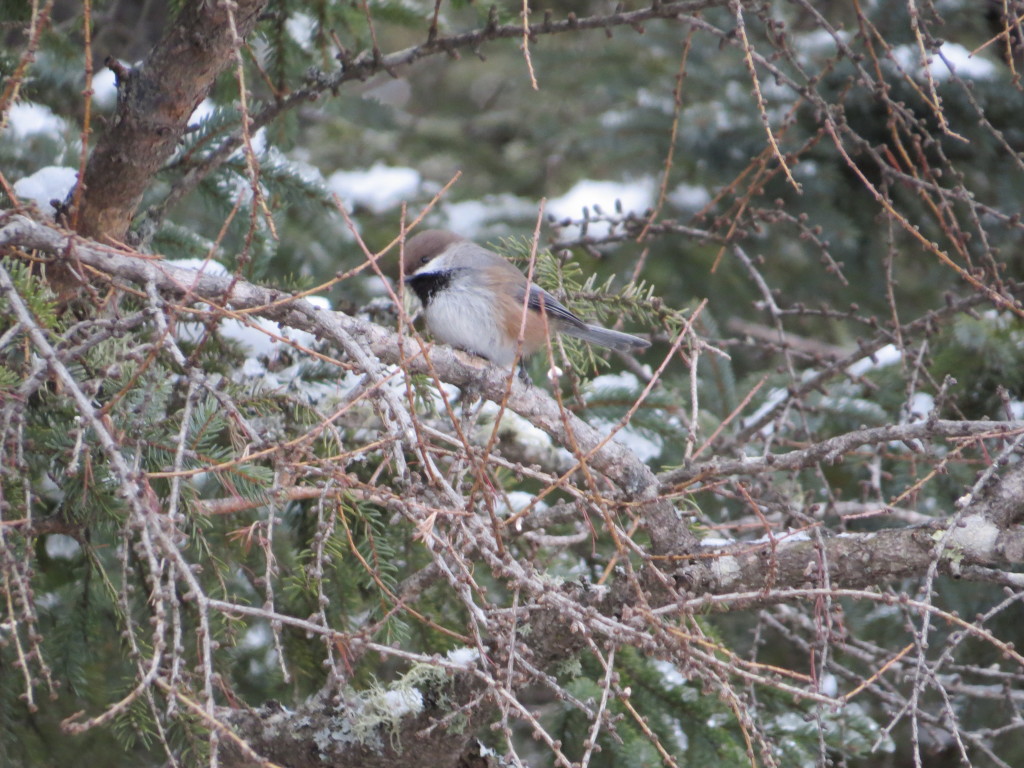 The Boreal Chickadees had started to become a regular at the Admiral Road feeders not more than a week before the guys arrived. Tommy and Gordon were truly spoiled with this lifer. It appeared within a minute of us stopping at the feeders. How many birders, myself included, have waited for an hour or more only to be skunked? Additionally, it came out often, like every minute instead of every half hour. Like the Great Gray, this bird is not a given. Also like the Great Gray, much face time is required with this bird. I would estimate that we spent equal time with it as we did with the Owl. For me this bird ranks just below a Great Gray Owl but definitely above a Snowy Owl. As such, I am on a never-ending quest to get a photo of a BOCH that I am happy with.
The Boreal Chickadees had started to become a regular at the Admiral Road feeders not more than a week before the guys arrived. Tommy and Gordon were truly spoiled with this lifer. It appeared within a minute of us stopping at the feeders. How many birders, myself included, have waited for an hour or more only to be skunked? Additionally, it came out often, like every minute instead of every half hour. Like the Great Gray, this bird is not a given. Also like the Great Gray, much face time is required with this bird. I would estimate that we spent equal time with it as we did with the Owl. For me this bird ranks just below a Great Gray Owl but definitely above a Snowy Owl. As such, I am on a never-ending quest to get a photo of a BOCH that I am happy with.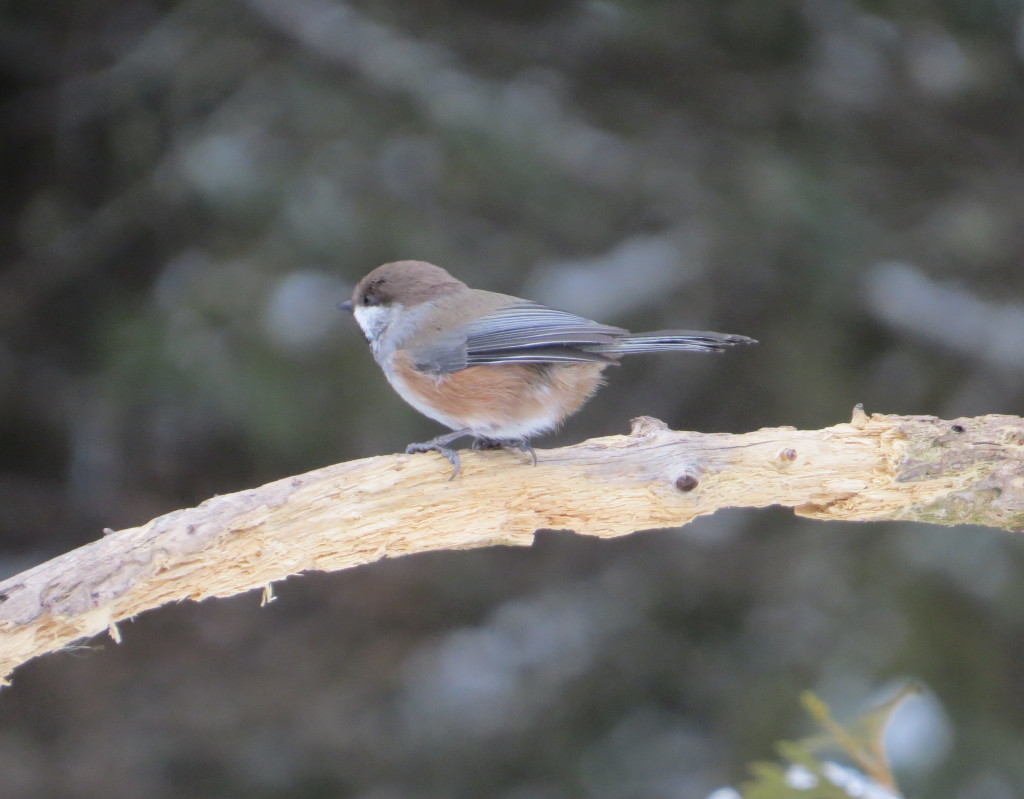
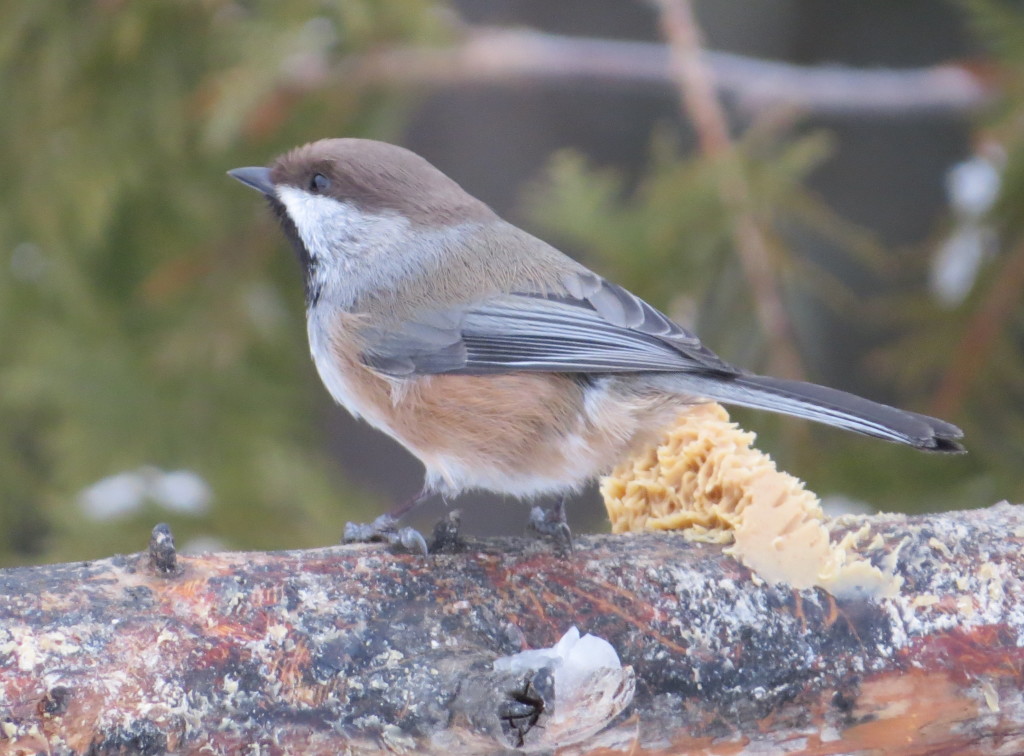
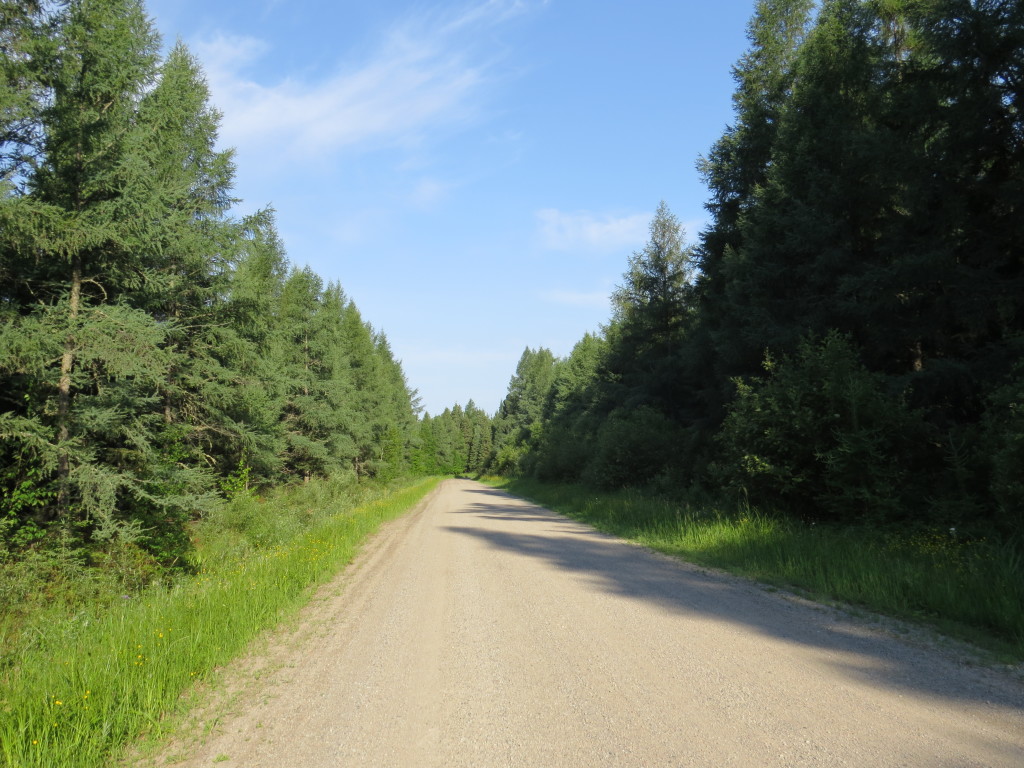 Northern Minnesota is home. Every season offers up something special in terms of wildlife and scenery. I was able to get out and do some birding in the forests, bogs, and open country on the same recent trip that included the Blackburnian Warbler. Cool stuff abounds everywhere here. It was good to be home.
Northern Minnesota is home. Every season offers up something special in terms of wildlife and scenery. I was able to get out and do some birding in the forests, bogs, and open country on the same recent trip that included the Blackburnian Warbler. Cool stuff abounds everywhere here. It was good to be home.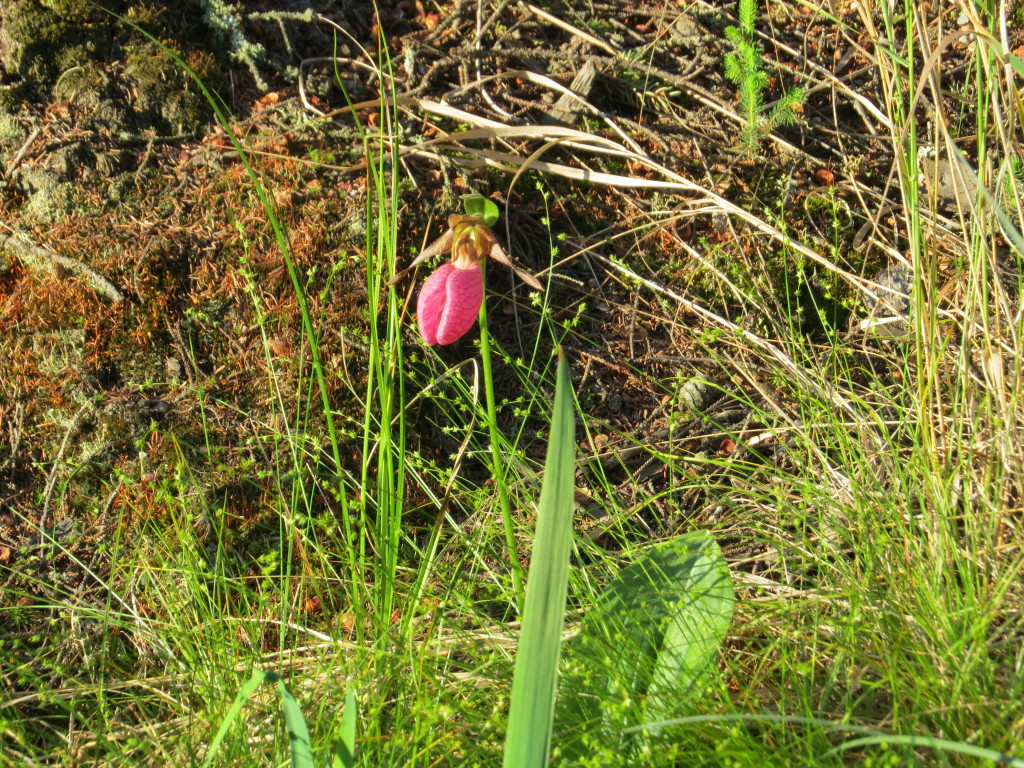
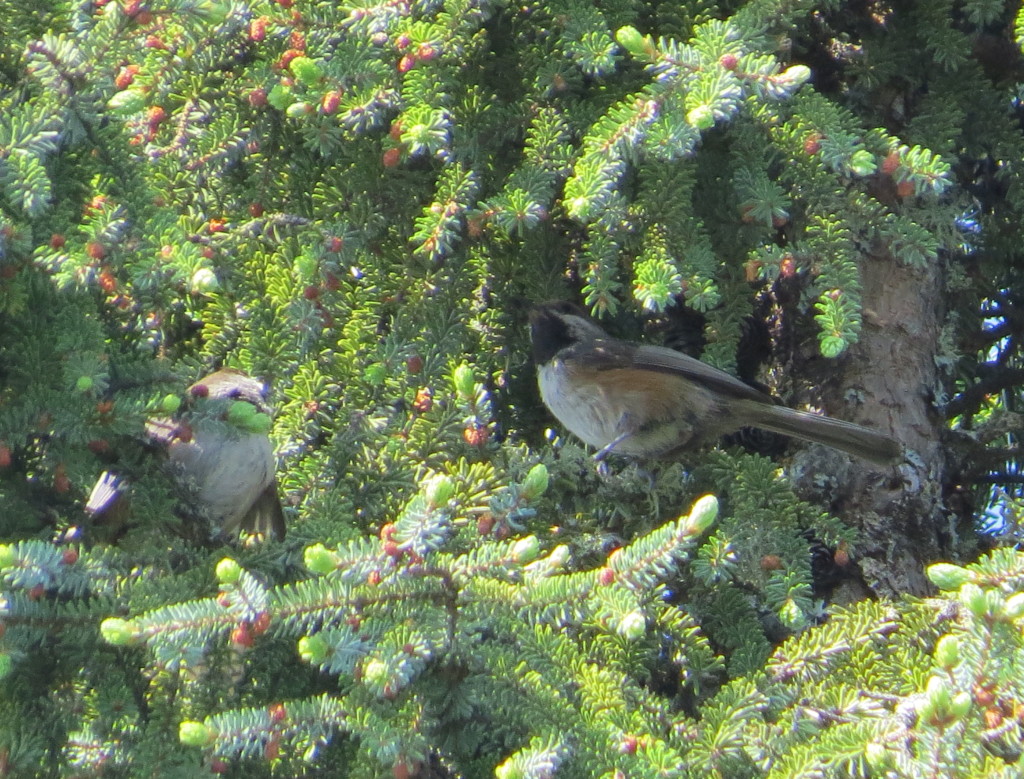 Judging from my picture, it appears that this was a family group with a couple fledglings! This Chickadee is so cool. Most MN birders only see them in the dead of winter when they come out to the remote feeding station on Admiral Road in the Sax-Zim Bog. I was very pleased to see BOCH in the summer and much closer to home than SZ.
Judging from my picture, it appears that this was a family group with a couple fledglings! This Chickadee is so cool. Most MN birders only see them in the dead of winter when they come out to the remote feeding station on Admiral Road in the Sax-Zim Bog. I was very pleased to see BOCH in the summer and much closer to home than SZ.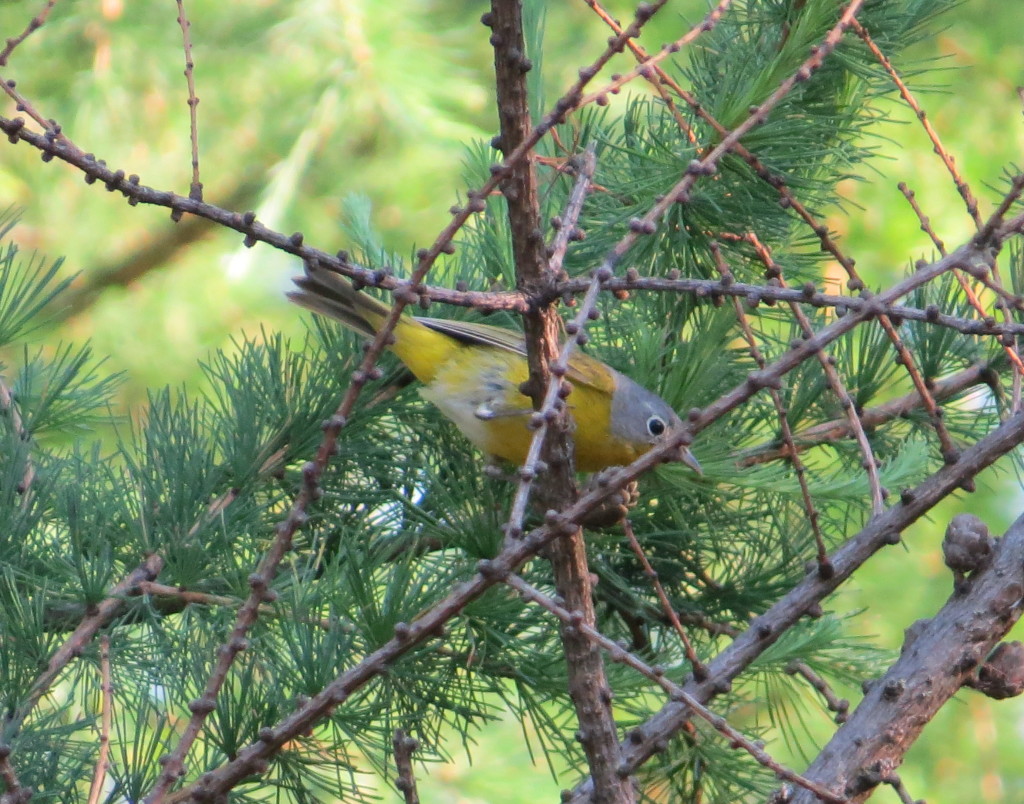
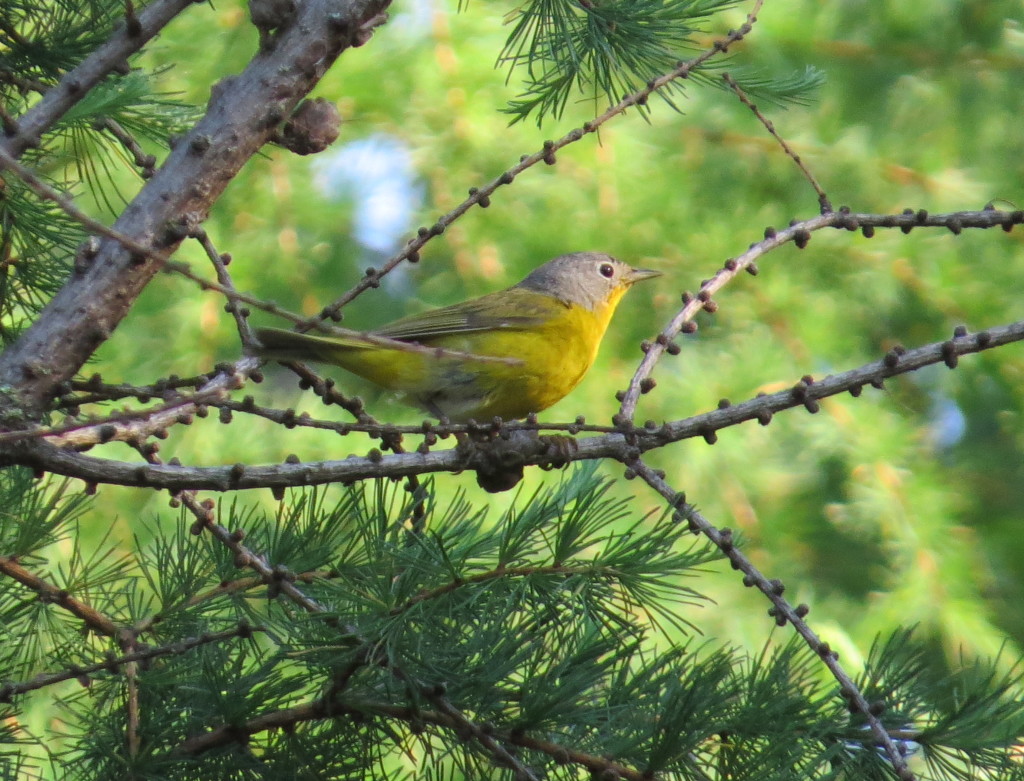 Another fun bird to see even if it couldn’t be seen well was the Lincoln’s Sparrow.
Another fun bird to see even if it couldn’t be seen well was the Lincoln’s Sparrow.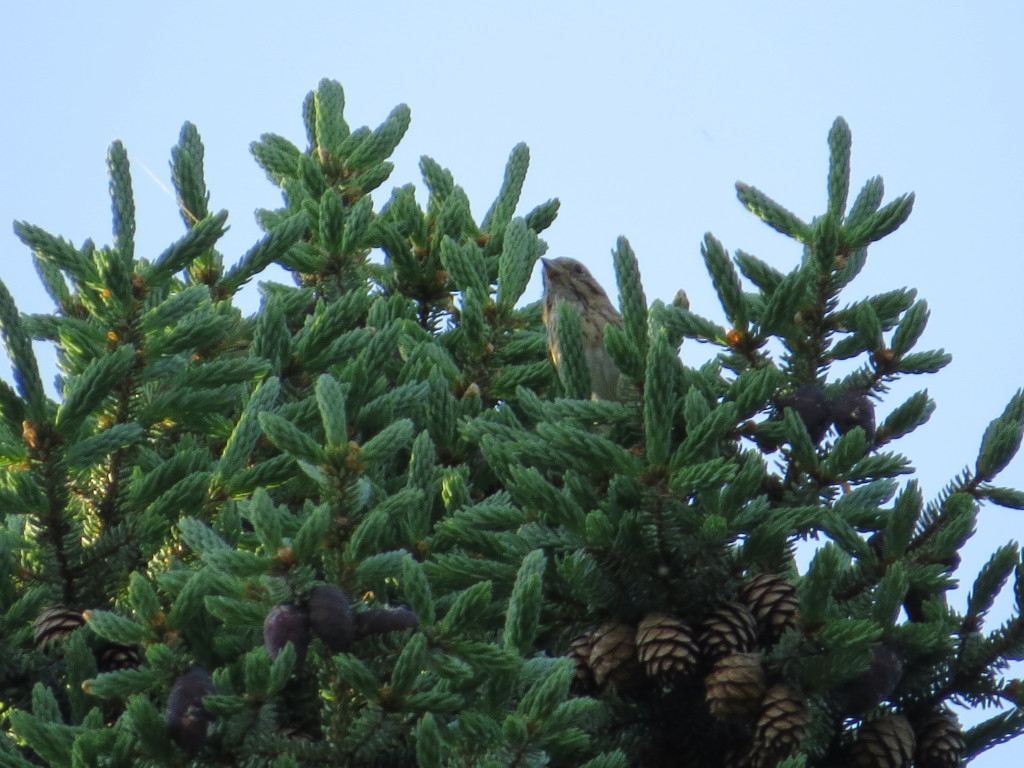 The varied habitats in northern MN offer up some unique opportunities for viewing wildlife. While looking for an American Bittern lifer in a marsh near my parents’ house, I found this gal looking for a place to lay her eggs.
The varied habitats in northern MN offer up some unique opportunities for viewing wildlife. While looking for an American Bittern lifer in a marsh near my parents’ house, I found this gal looking for a place to lay her eggs.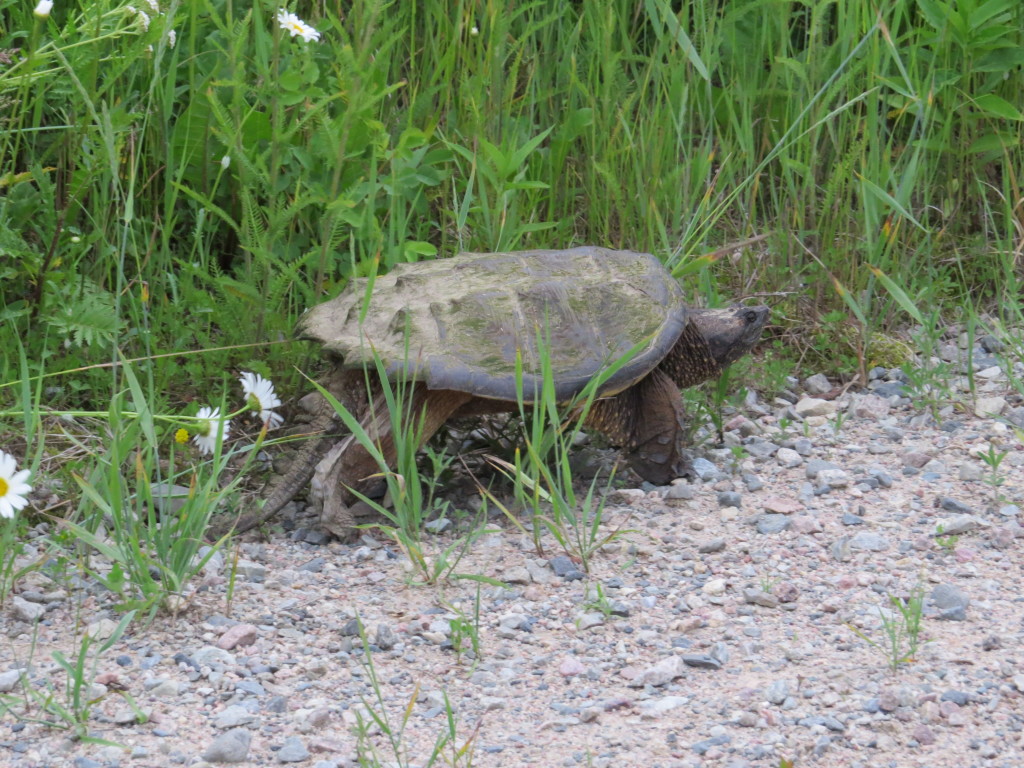 It was not the biggest Snapper I’ve seen. This one’s shell was the size of a dinner plate. I’ve seen them twice as big before.
It was not the biggest Snapper I’ve seen. This one’s shell was the size of a dinner plate. I’ve seen them twice as big before.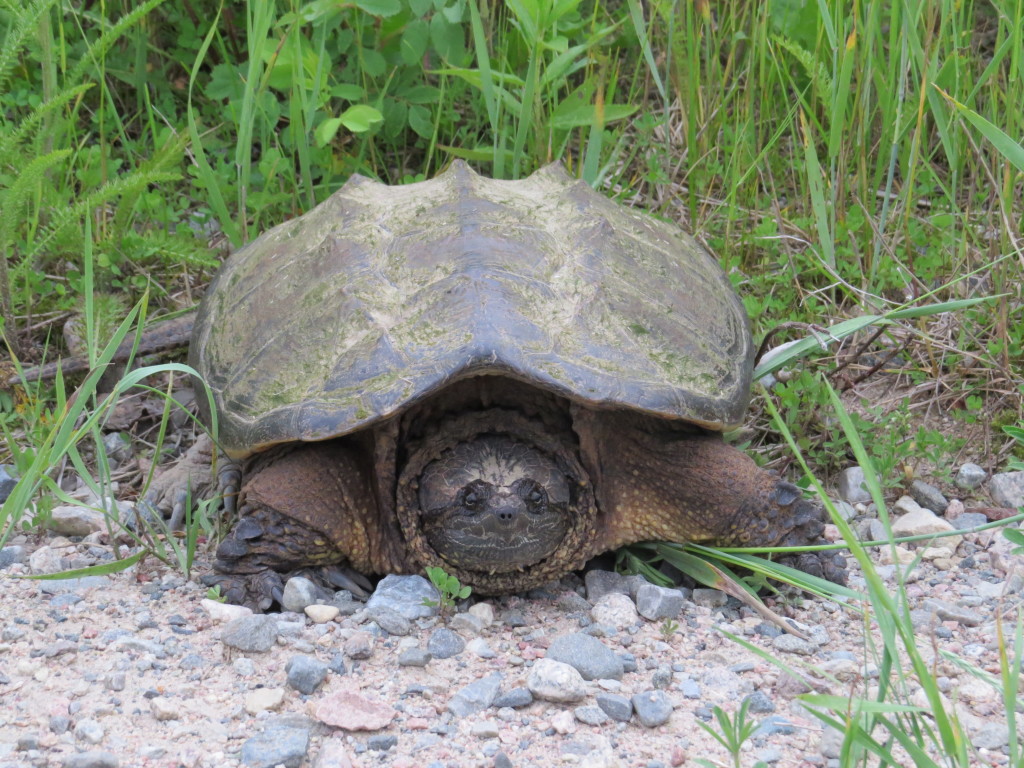 I didn’t spend a lot of time in the mature, upland woods other than just passing through. That was enough to nab my FOY Blue-headed Vireo that I missed during migration.
I didn’t spend a lot of time in the mature, upland woods other than just passing through. That was enough to nab my FOY Blue-headed Vireo that I missed during migration.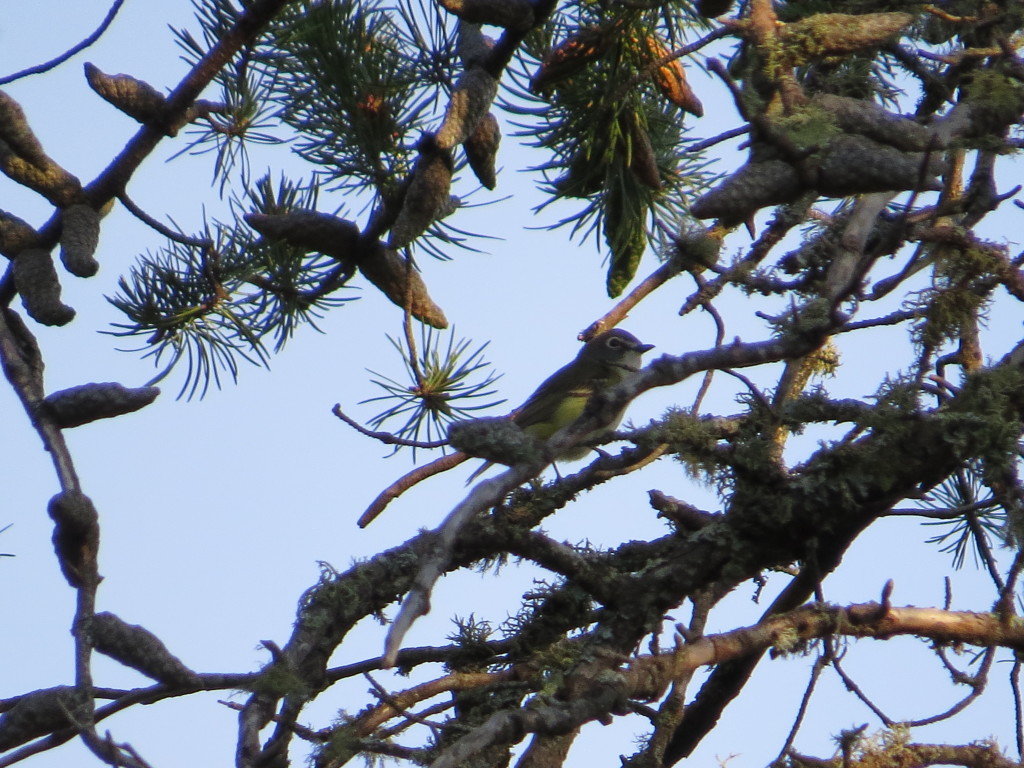 This bird has never been good to me. It was once a nemesis and continues to be a photographic nemesis. By the time I figured out its rhythm of jumping to a new perch each time after it sang, the bird disappeared from sight.
This bird has never been good to me. It was once a nemesis and continues to be a photographic nemesis. By the time I figured out its rhythm of jumping to a new perch each time after it sang, the bird disappeared from sight.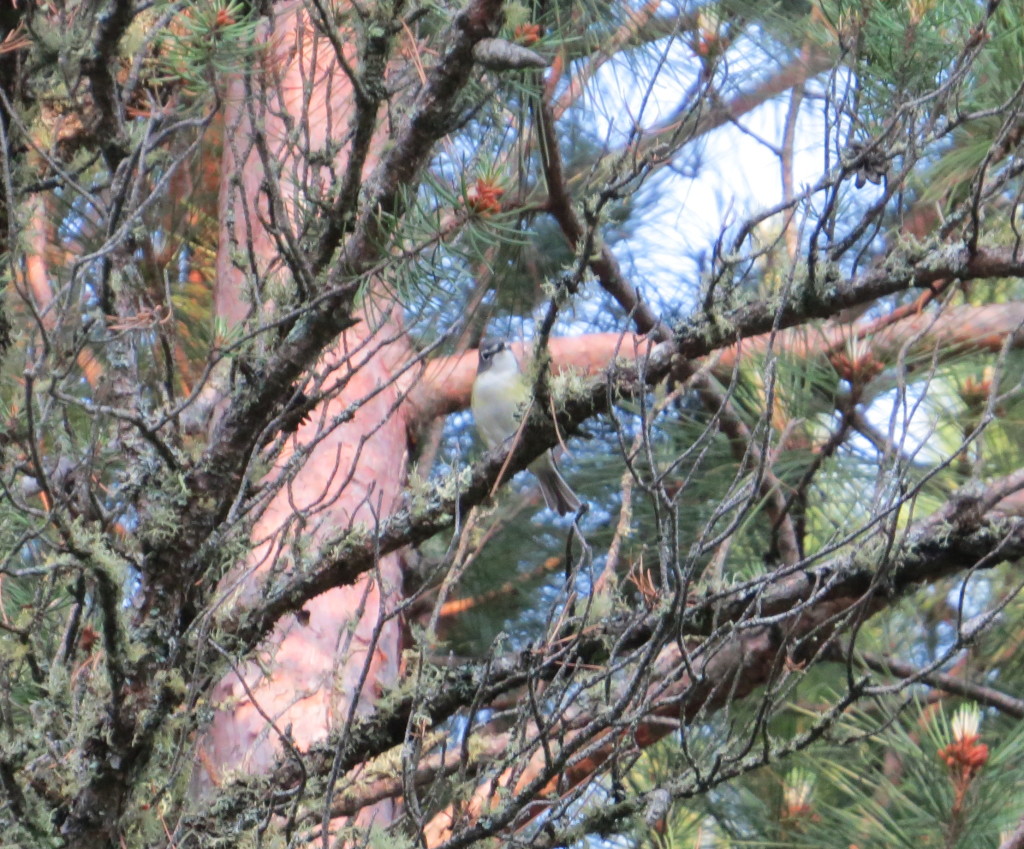
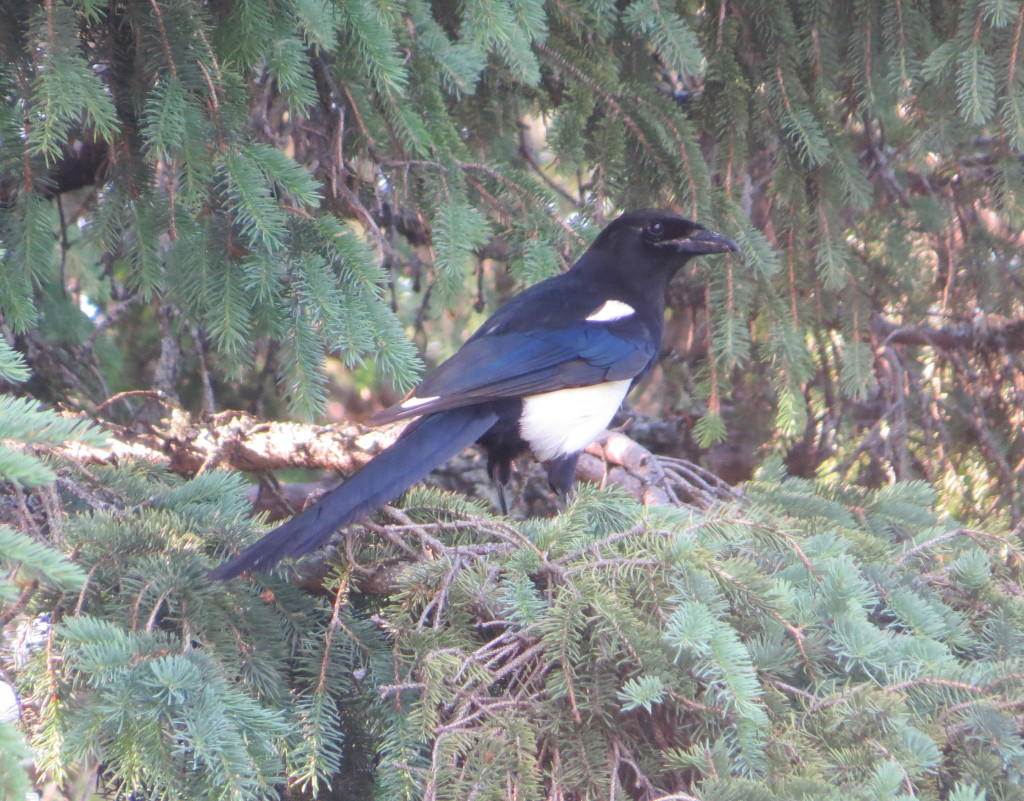 Also found in an open area was a bird that I have seen so many times this year and never before in the Northland, the Brown Thrasher.
Also found in an open area was a bird that I have seen so many times this year and never before in the Northland, the Brown Thrasher.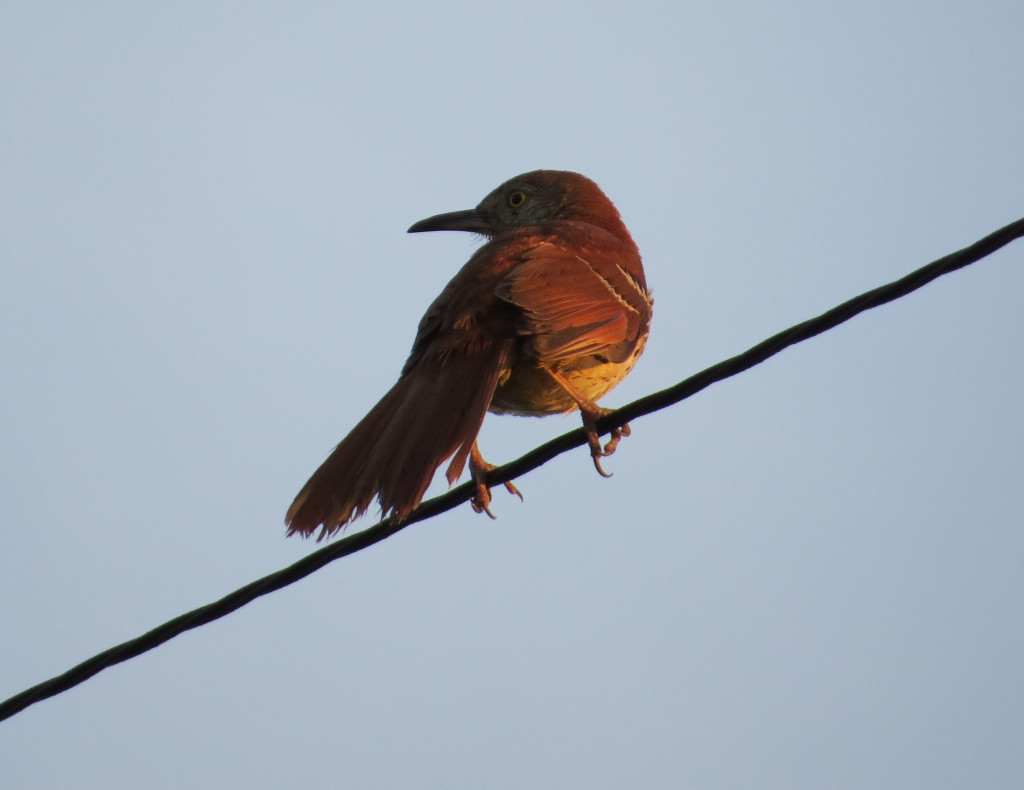 One bird that favors the open grassy fields that intersperse the Northwoods are the showy, and unique-sounding Bobolinks. They must be having a good year because I saw so many.
One bird that favors the open grassy fields that intersperse the Northwoods are the showy, and unique-sounding Bobolinks. They must be having a good year because I saw so many.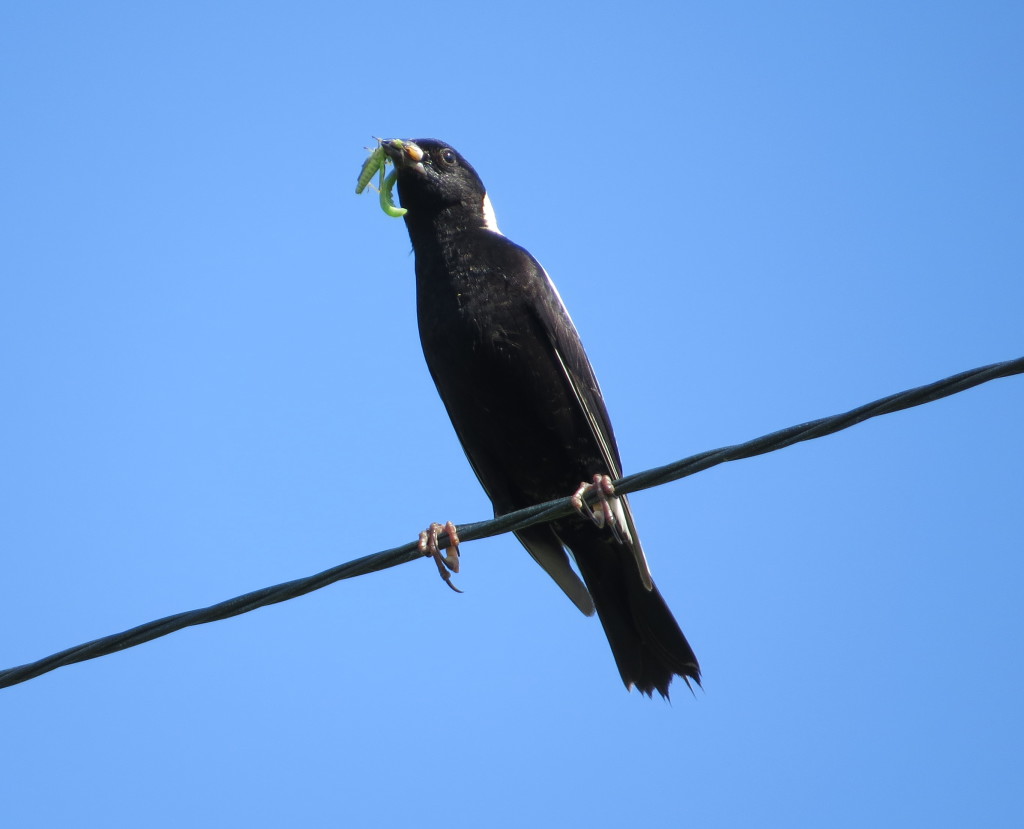
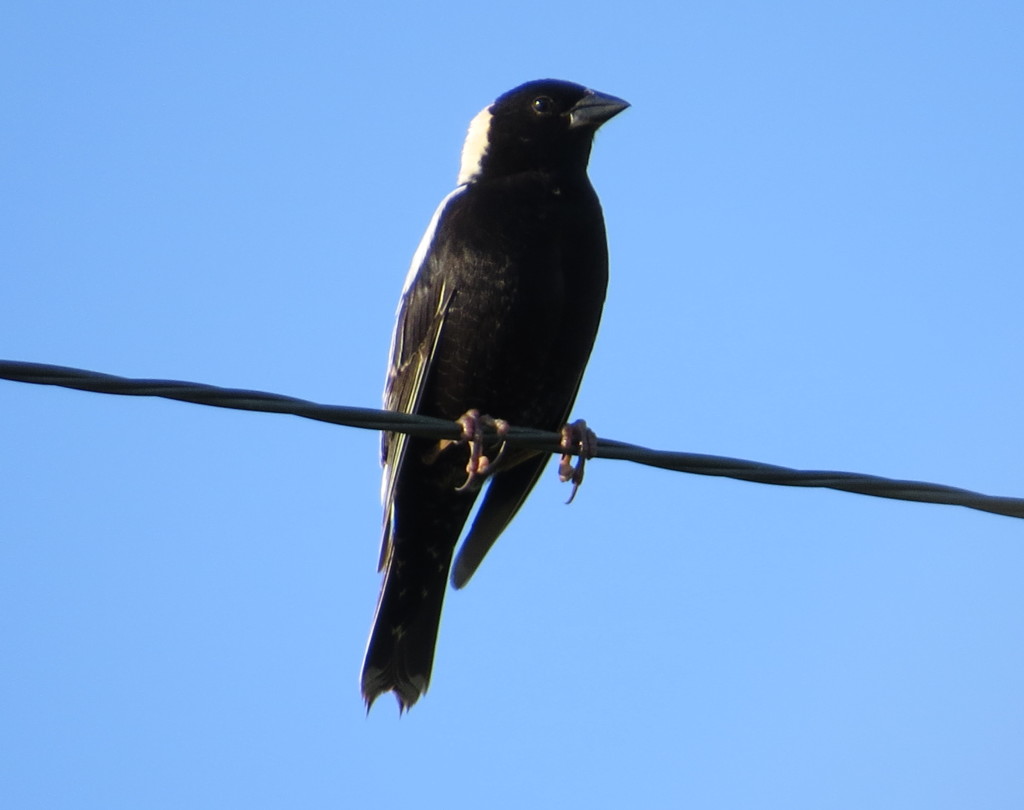
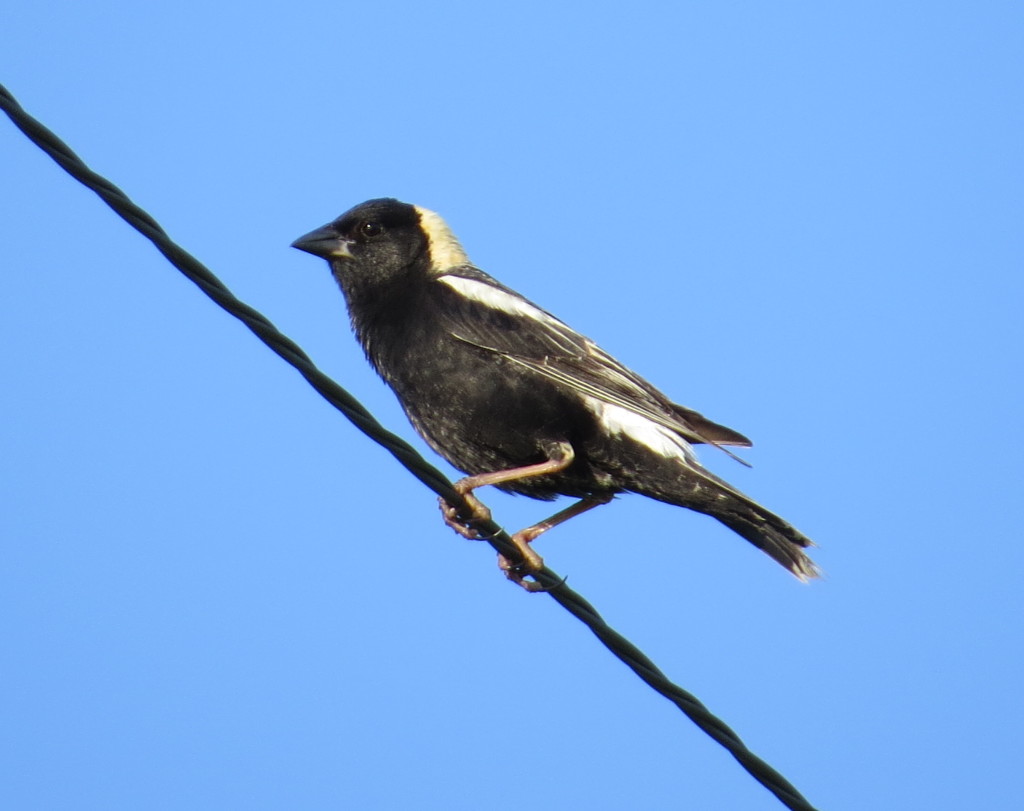
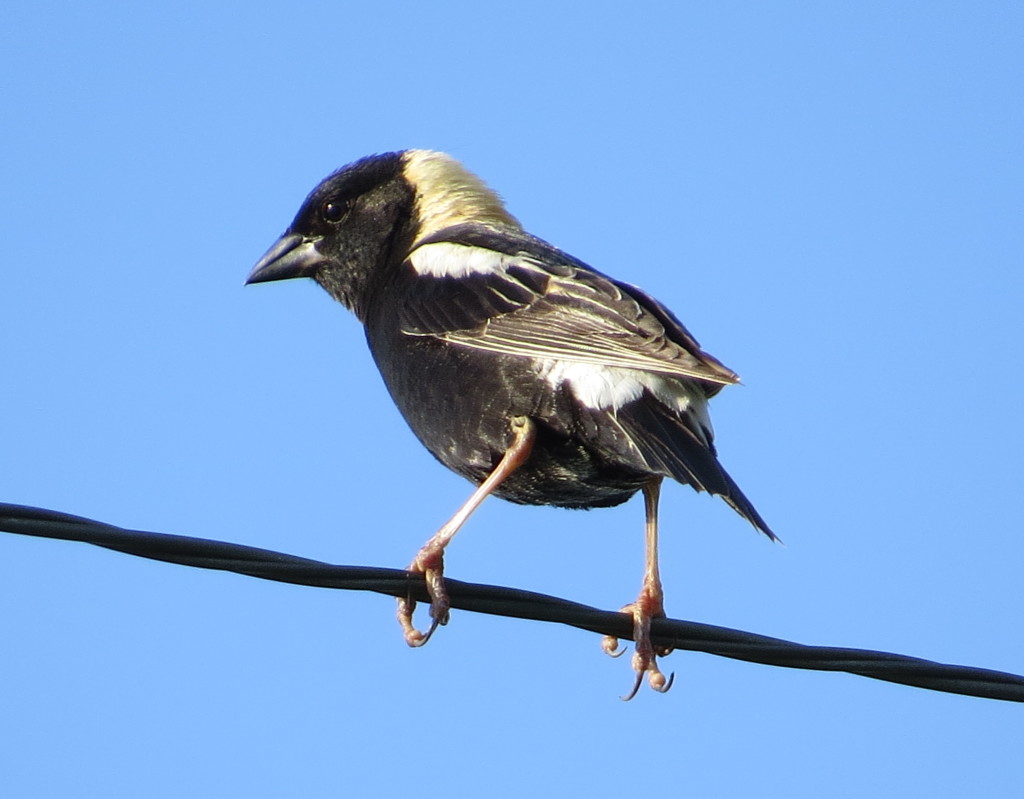 One bird that I was absolutely surprised to find in the open fields were Brewer’s Blackbirds! I had no idea they were in the area. Honestly, I often just dismiss most blackbirds I see as Red-winged Blackbirds or Common Grackles. Needless to say I was pleasantly surprised when I saw the Brewer’s. Like the Bobolink, it was nice to finally be able to get some decent photos of this bird too.
One bird that I was absolutely surprised to find in the open fields were Brewer’s Blackbirds! I had no idea they were in the area. Honestly, I often just dismiss most blackbirds I see as Red-winged Blackbirds or Common Grackles. Needless to say I was pleasantly surprised when I saw the Brewer’s. Like the Bobolink, it was nice to finally be able to get some decent photos of this bird too.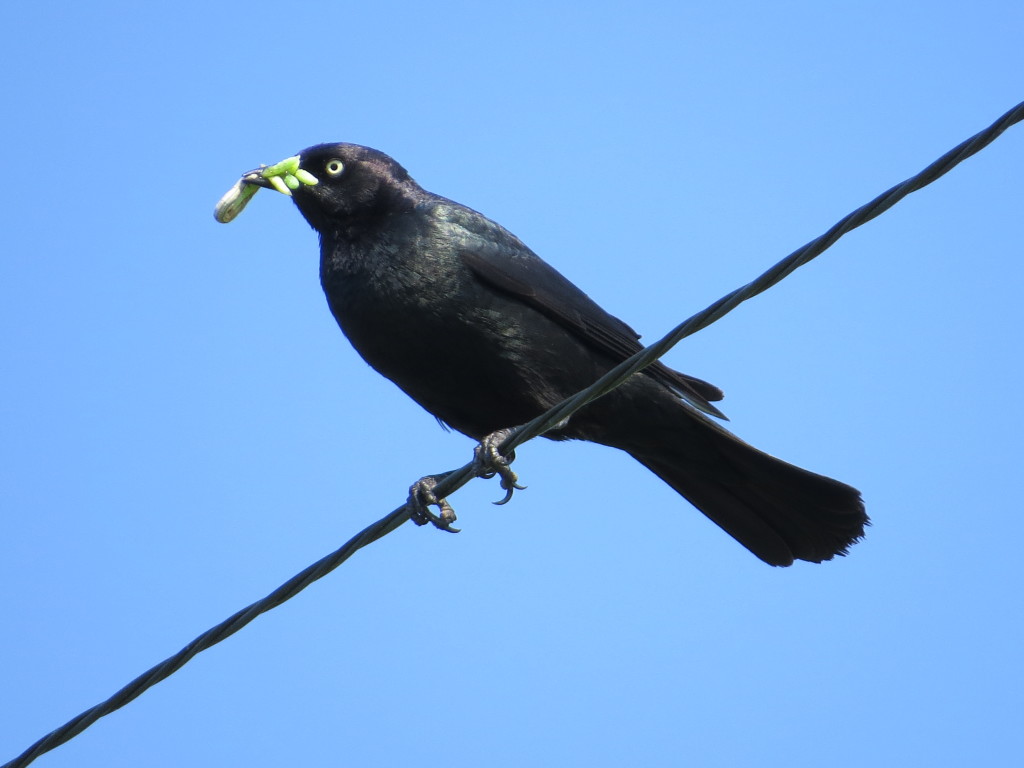
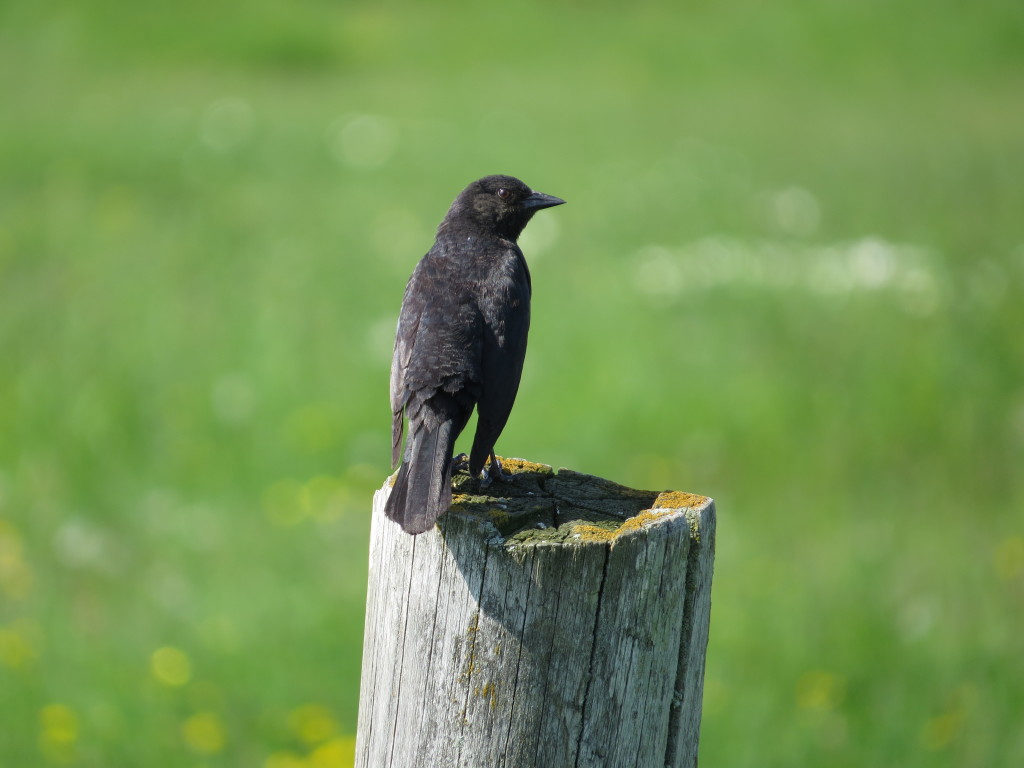
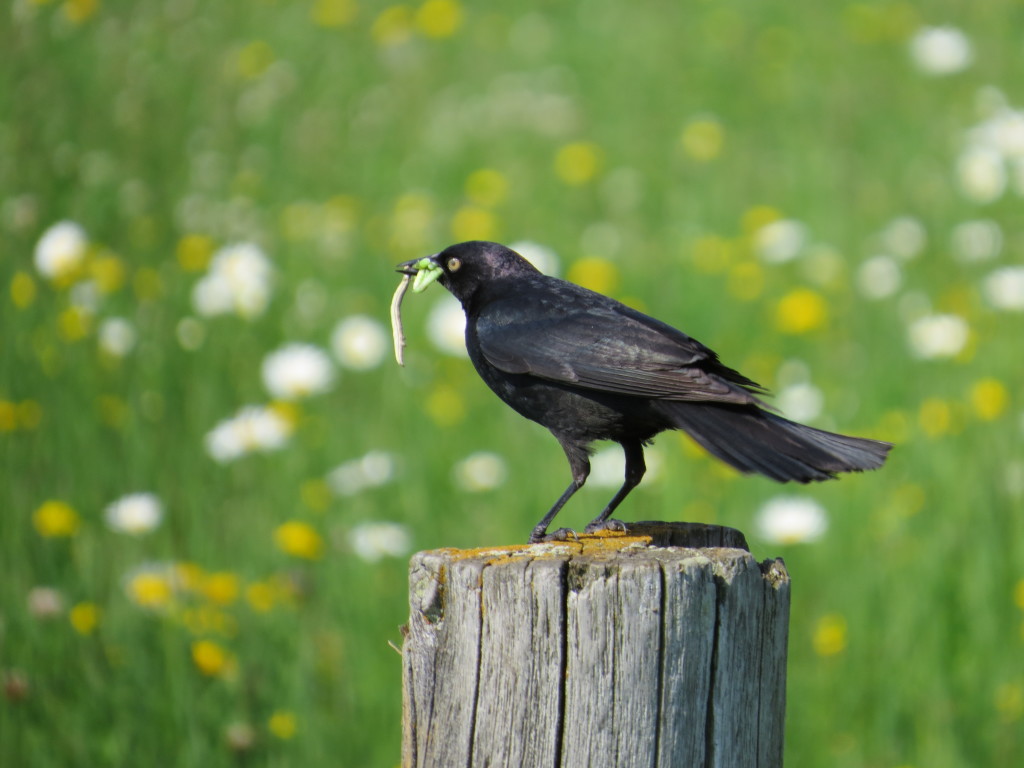
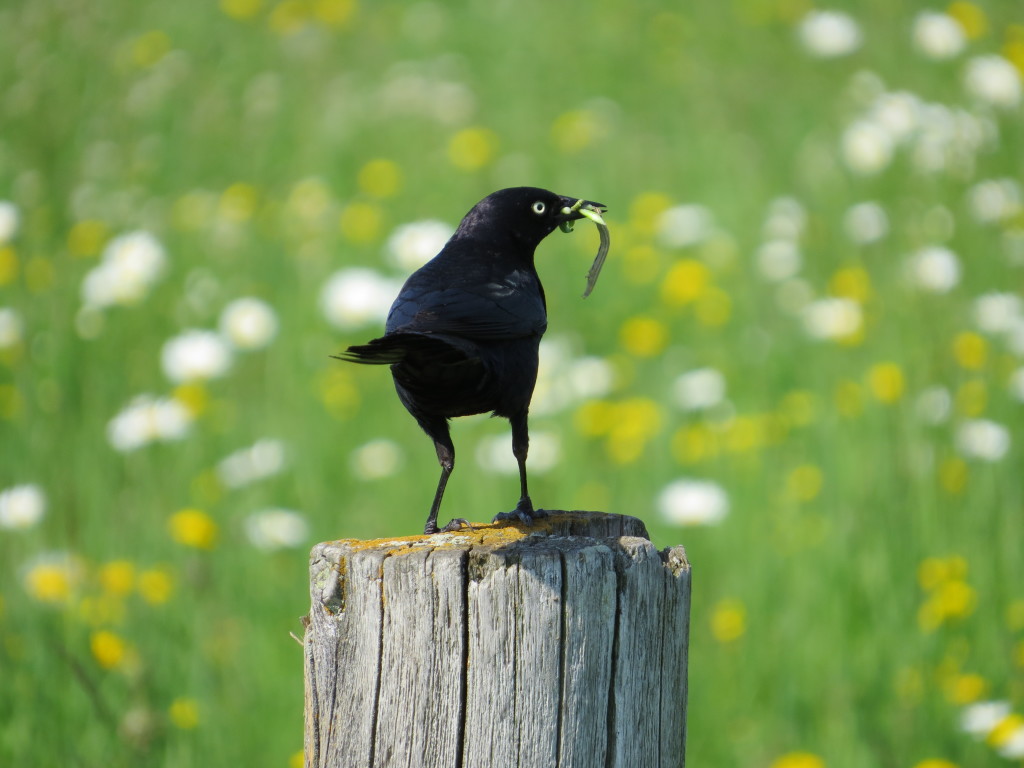
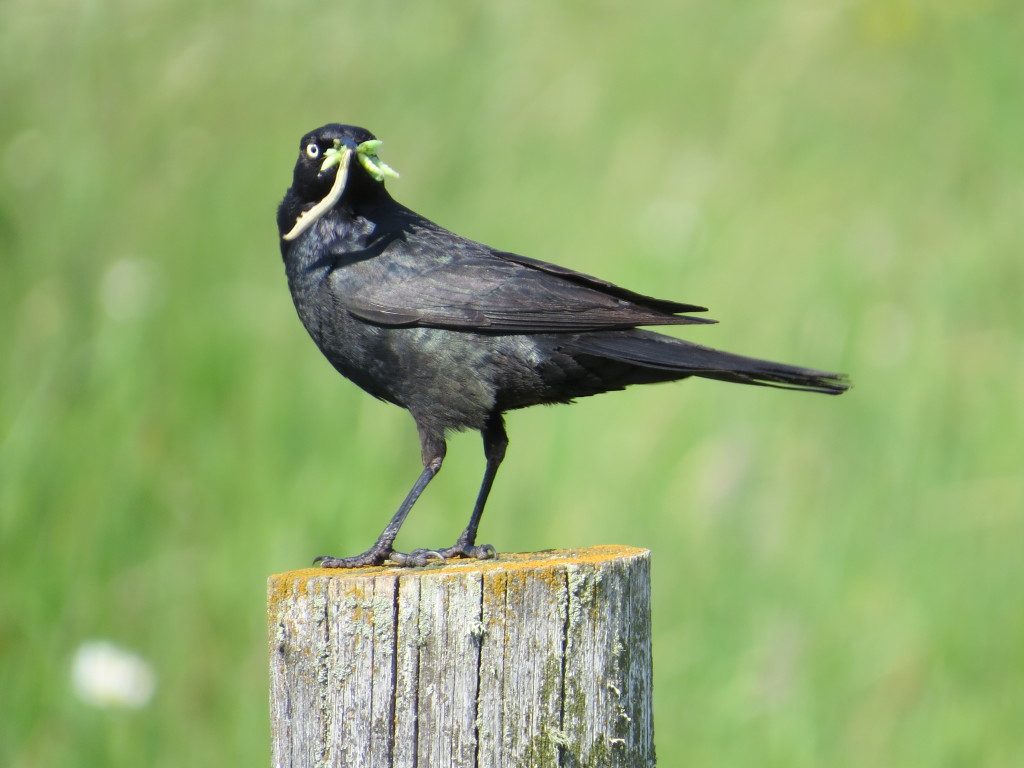 I had some really fun birding on this trip up north. I was not lifer hunting as there really are so few lifers I can still get. And none of them are easy. Or so I thought. In the next post I’ll tell you about a three-generation lifer that was delivered right to the doorstep.
I had some really fun birding on this trip up north. I was not lifer hunting as there really are so few lifers I can still get. And none of them are easy. Or so I thought. In the next post I’ll tell you about a three-generation lifer that was delivered right to the doorstep.
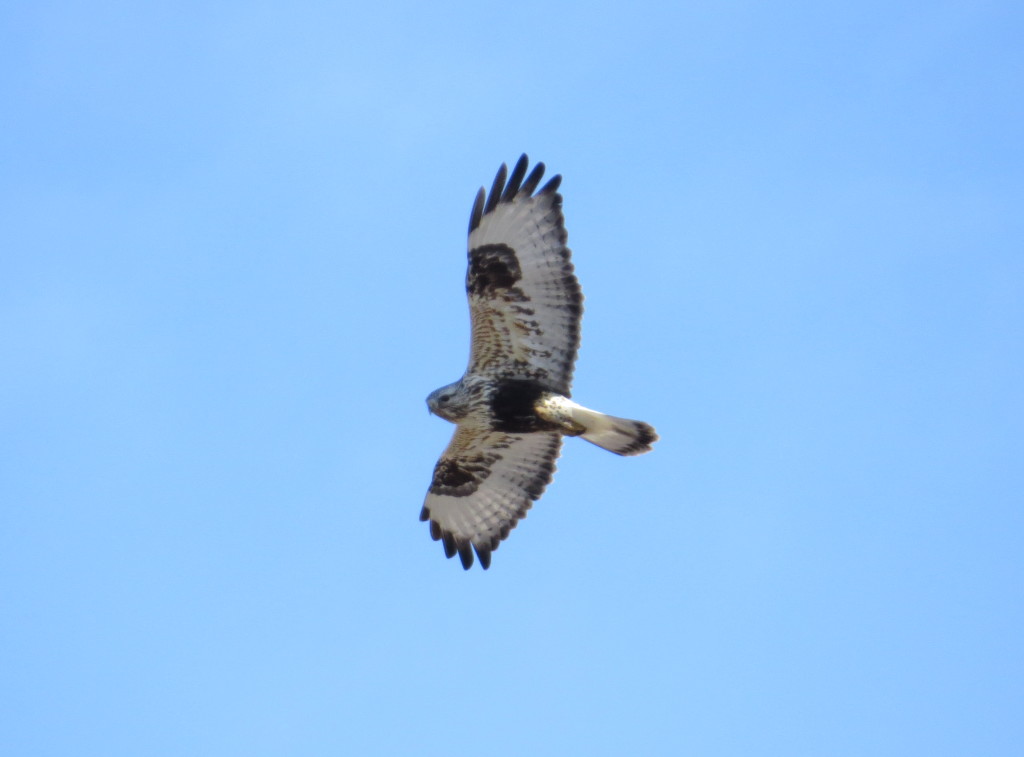


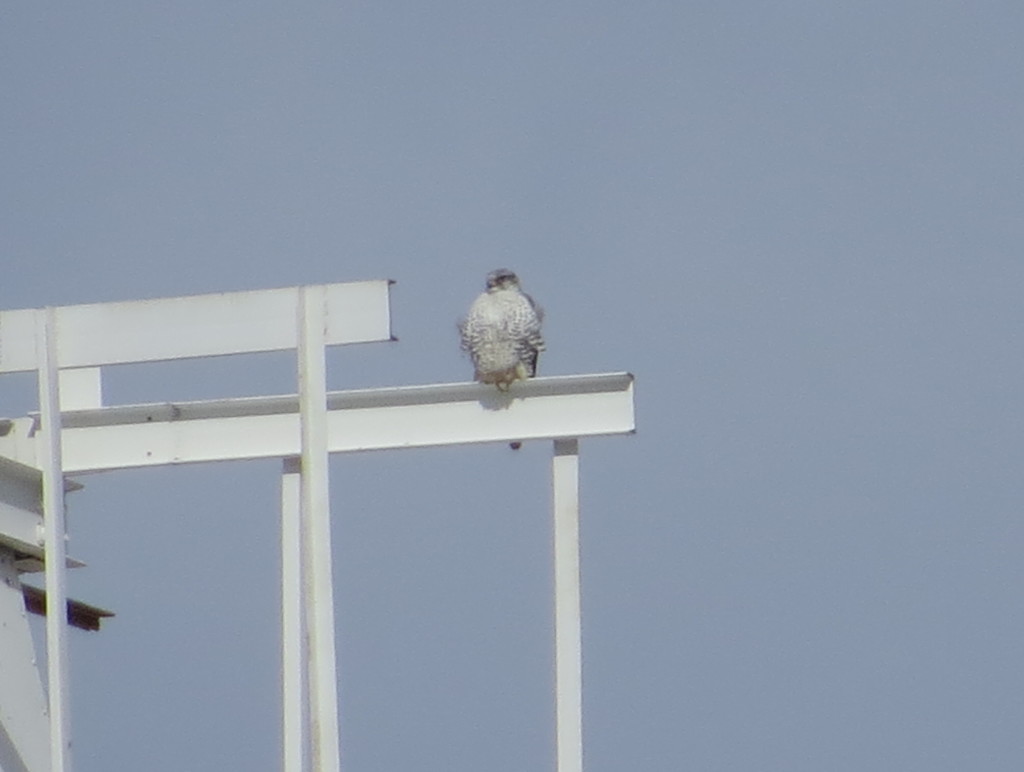
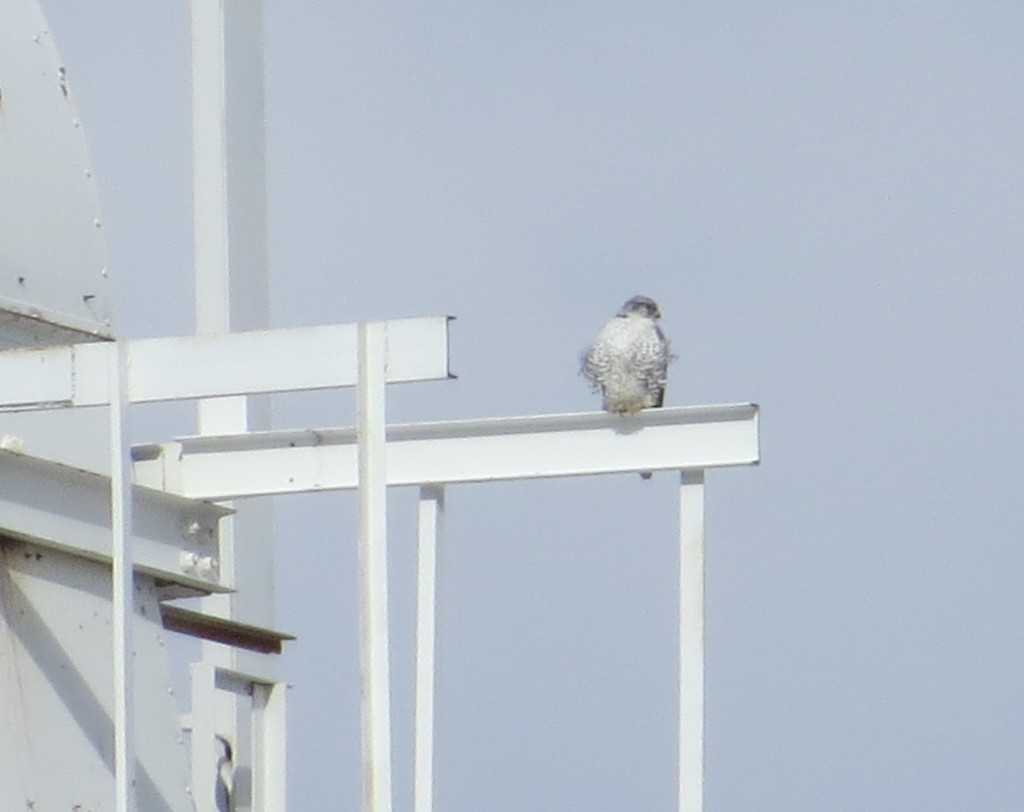 Some fun history on Gyr is that this same individual was caught and banded in 2003 in the Duluth/Superior area. At the time it was a third-year bird. It ended up returning every winter for four years and then did not return until this year! Given when it was banded, the age of this male Gyrfalcon is estimated to be 14 years 8 months–the oldest Gyrfalcon on record!
Some fun history on Gyr is that this same individual was caught and banded in 2003 in the Duluth/Superior area. At the time it was a third-year bird. It ended up returning every winter for four years and then did not return until this year! Given when it was banded, the age of this male Gyrfalcon is estimated to be 14 years 8 months–the oldest Gyrfalcon on record!